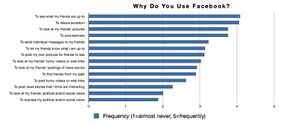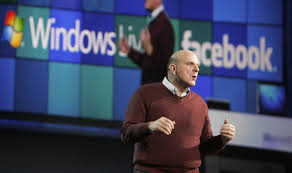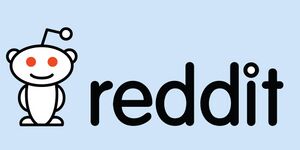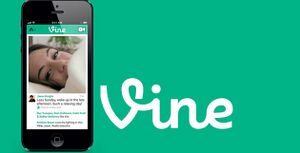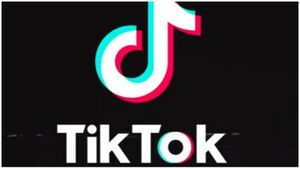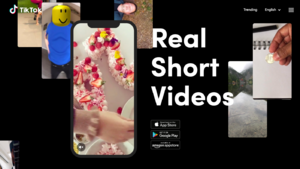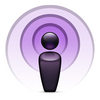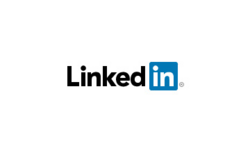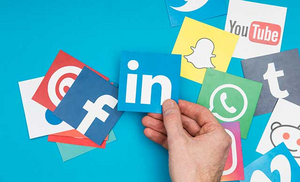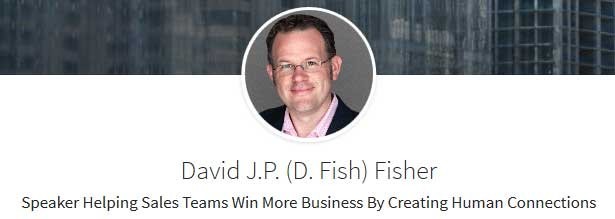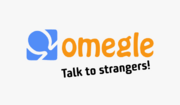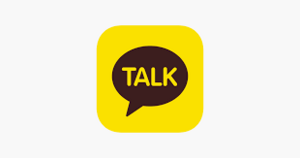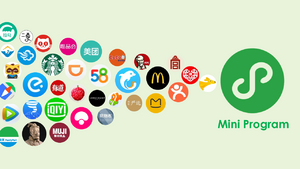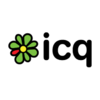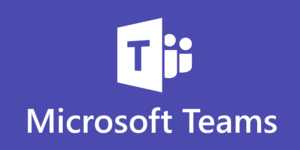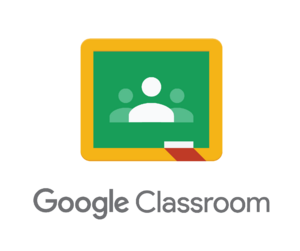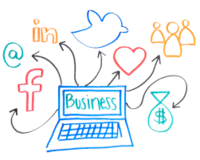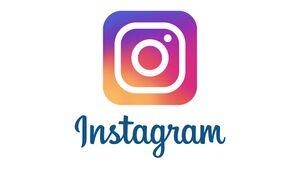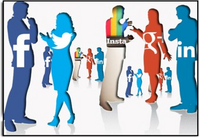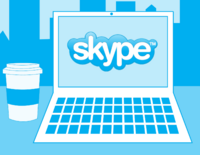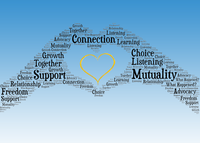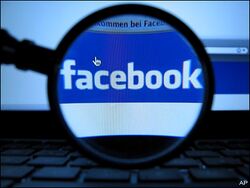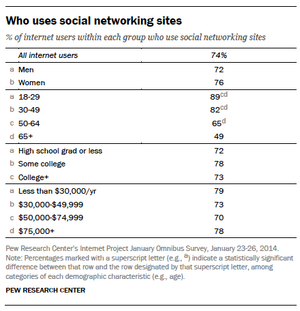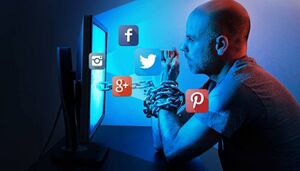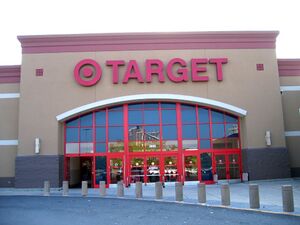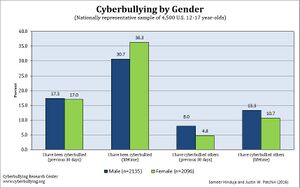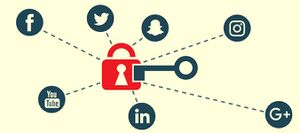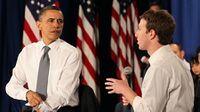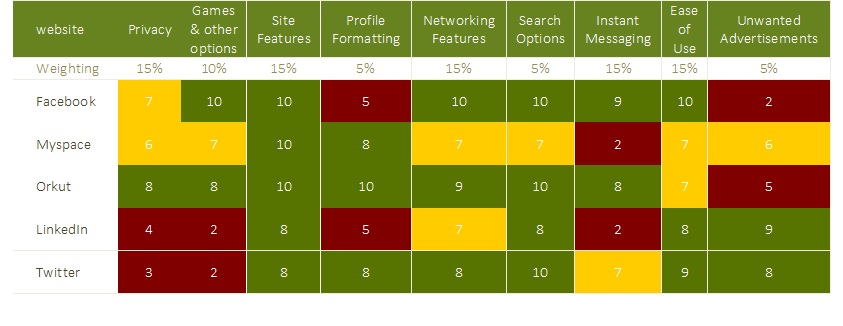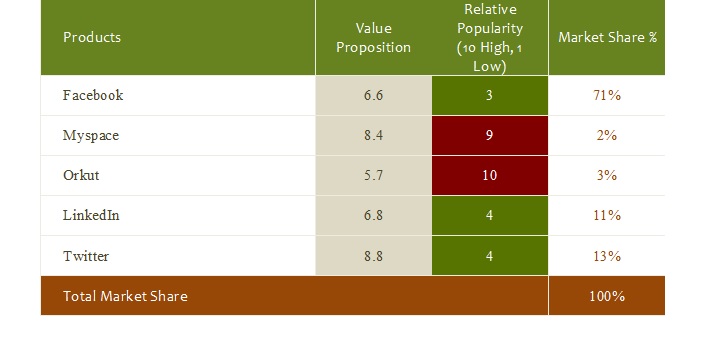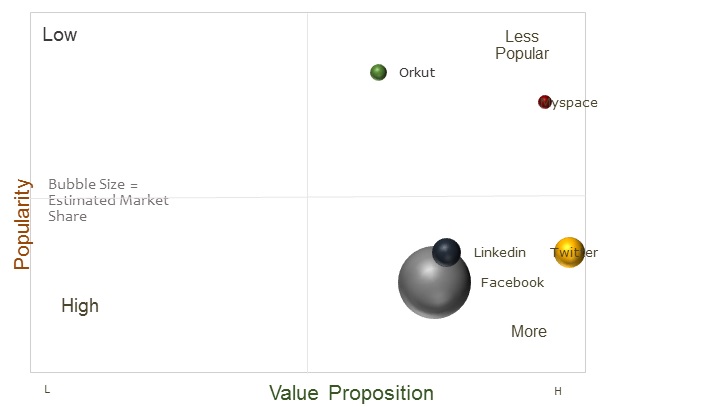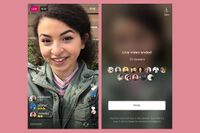A Social Networking Service is a platform used to build social networks or social relations among people who, for example, share interests, activities, backgrounds, or real-life connections. It consists of a representation of each user (often a profile), his/her social connections, and a variety of additional services. Most social network services are web-based and provide means for users to interact over the internet, such as e-mail, image sharing and instant messaging. Online community services are sometimes considered as a social network service, though in a broader sense, social network service usually means an individual-centered service whereas online community services are group-centered. Social networking sites allow users to share thoughts, images, content, activities, events, and interests with people in their network. They also allow companies and organizations to share their culture,advertisements, and ideas.
Social networking has a lot of characteristics. User-based is one of the most important characteristics of social networking. A long time ago, before we knew what Facebook or Twitter was, websites were mainly based on a content that is often managed by a single user – called an admin and read by internet visitors. Social networking, on the other hand, is a network of many users. Without users, social networking no longer has its meaning. Besides that, interactivity is an indispensable characteristic of social networking. It is very simple to understand that we need a group of people and they need to interact with each other to communicate and build a network.
New Media is a 21st Century catch-all term used to define all that is related to the internet and the interplay between technology, images, and sound. [1]As we shift from old media to new media we see a transition of “old stuff” to the “new stuff.” We are no longer fond of the old newspaper or handwritten letter but instead are more into blogs and social media platforms. As old media converges into new media, we see many different creative aspects come to the surface such as mashups, viral videos, rap parodies, twitter trends, etc. New media has helped develop a stronger and more impactful society. It has inspired people to further their inner creative self. Unlike the old media, new media incorporates the 5C's which are Communication, Collaboration, Community, Creativity, and Convergence. Technologies, such as blogs, podcasts, wikis, social networking sites, virtual worlds, and mobile technology (including Facebook, Instagram, Snapchat, Twitter, LinkedIn, and other social media platforms) are a big part of the new media.
The main types of social networking services are those that contain category places (such as former school year or classmates), means to connect with friends and family (usually with self-description pages), and a recommendation system linked to trust. Popular methods now combine many of these, with American-based services such as Facebook, Google+, Tumblr,Flickr and Twitter are widely used worldwide; Nexopia in Canada;[3] Badoo,[4] Bebo,[5] VKontakte, Delphi (also called Delphi Forums), Draugiem (mostly in Latvia), Hi5, [www.hyves.nl Hyves] (mostly in The Netherlands), iWiW (mostly in Hungary), Nasza-Klasa, Soup (mostly in Poland), Glocals in Switzerland, Skyrock, The Sphere, StudiVZ (mostly in Germany), Tuenti (mostly in Spain), and XING[6] in parts of Europe;[7] Hi5 and Orkut in South America and Central America;[8] Mxit in Africa;[9] and Cyworld, Mixi, Orkut, renren, Weibo and [Wretch] in Asia and the Pacific Islands.
There have been attempts to standardize these services to avoid the need to duplicate entries of friends and interests (see the FOAF standard and the Open Source Initiative. Since 2005, there has been a significant increase in a number of adult users. Almost three-quarters (72%) of online adults in the United States use social media today, suggests new data from Pew Internet. This represents a significant increase from when Pew first carried out this research in February 2005 when 8% of online adults were active in social channels. Moreover, close to one in five (18%) of online adults now use Twitter, up from 8% in November 2010, and a full 2% point rise as of February of 2013.
[10]
Social Networking
The rapid development of mobile internet provides a good living condition for the emergence of social media in smartphones and produces a new interactive form. In addition to obtaining new information, users also communicate through social media.
In the past, we did not have the luxury of smartphones, like iPhones and Androids. With social media networks like Facebook, Snapchat, Instagram, and Twitter, connecting with people and friends, in particular, is rather simple. We can use Facebook to share our status or update, whether it’s about your day, planned trips, or politics. You can also share albums and videos to keep your Facebook friends updated with what you’ve been up to. You can also scroll through Facebook and have many interesting and funny videos on your page, as well as many news articles and videos regarding Trump and other countries. Twitter is very different, where you can only post a “Status” by tweeting your thoughts or responding to other people’s tweets. Snapchat is cool because you can post pictures and 10-second videos on what you are doing right now, whether it’s going to the gym, going out with your friends, or traveling to Mexico. It keeps you up to date on what all your friends are currently doing. These snapshots go away after 24 hours. Instagram is another popular social networking site where you can post videos and pictures. It is only used for pictures and videos, and you can scroll through your news feed to keep yourself up to date with all your friend's lives on the day to day.
History of Social Media
The birth of social media was in 1997. The social media website that came out was called Six Degrees and the website lasted from 1997 to 2001. Six Degrees is similar to Facebook where it is a platform that allows users to form friendships and create a profile. From Six Degrees the Internet evolved into times of blogging and instant messaging. In blogs, people were able to interact with other readers and bloggers. From Six Degrees, America Online’s AOL’s instant messenger evolved which allows people to communicate 24 hours a day which later transformed into text messaging. When 2000 came around the use of the Internet became more prevalent which allowed people to use chat rooms and host discussions with people. In 2003 the first social media website came up, Myspace. It was a forum to create a personal profile and make friends. Later this form of social media was taken over by Facebook based on simplicity. Myspace was really complex and allowed for a lot of personalization from the layout and theme of the page, to the music player on the website, even the cursor on the page could be personalized. Myspace was a good portal to both promote music and to find new developing artists. [11]
The potential for computer networking to facilitate newly improved forms of computer-mediated social interaction was suggested early on.[12] Efforts to support social networks via computer-mediated communication were made in many early online services, including Usenet,[13] ARPANET, LISTSERV, and bulletin board services (BBS). Many prototypical features of social networking sites were also present in online services such as America Online, Prodigy, CompuServe, ChatNet, and The WELL.[14] Early social networking on the World Wide Web began in the form of generalized online communities such as Theglobe.com (1995),[15] Geocities (1994) and Tripod.com (1995). Many of these early communities focused on bringing people together to interact with each other through chat rooms, and encouraged users to share personal information and ideas via personal webpages by providing easy-to-use publishing tools and free or inexpensive webspace. Some communities - such as Classmates.com - took a different approach by simply having people link to each other via email addresses. In the late 1990s, user profiles became a central feature of social networking sites, allowing users to compile lists of "friends" and search for other users with similar interests. New social networking methods were developed by the end of the 1990s, and many sites began to develop more advanced features for users to find and manage friends.[16] This newer generation of social networking sites began to flourish with the emergence of SixDegrees.com in 1997,[17] followed by Makeoutclub in 2000,[18][19] Hub Culture and Friendster in 2002,[20] and soon became part of the Internet mainstream. Friendster was followed by MySpace and LinkedIn a year later, and eventually Bebo. Attesting to the rapid increase in social networking sites' popularity, by 2005, it was reported that MySpace was getting more page views than Google. Facebook,[21] launched in 2004, became the largest social networking site in the world[22] in early 2009.[23] Tumblr and many others have also come up recently.
Social Networking Platforms
The internet and new media have made everyone’s life easier. Many of the daily activities have been more efficient and less time consuming. We can search about everything on the internet and many sources will try to give us information. New media has also impacted the way people network with each other. Nowadays, everyone is busy running on their own schedules and often we find it hard to network with other people since it is not always that our leisure time matches with one another. Instead of face-to-face interaction being the only way of networking, thanks to social media, now there are many more options.
Arguably the most popular social media utility has changed the social networking industry forever. It was created by Mark Zuckerberg, Dustin Moskovitz, and two other students in February 2004. "Initially it was restricted to students from Harvard University but it was promptly extended to other Boston universities, the Ivy League and eventually all US universities. As of April 2014, Facebook has 1.28 billion unique active users. It became Facebook.com in August 2005 after the address was purchased for $200,000".[24]It has become the largest online social networking site in the world. While Facebook does promote many different things such as communication, helps in bridging social barriers and creativity it also raises issues such as cyberbullying, privacy and distraction. Facebook provides a way for users to build connections and share information with people and organizations they choose to interact with online. Users can also see current events that are nearby and invited friends to participate in the event together.
Though Facebook wasn’t created with the intent to connect employers and candidates together, it has evolved to much more than that. Employers can post their job openings on Facebook group pages targeting the type of candidates they would seem interested in. Employers can also utilize Twitter to post short job descriptions for any openings. Companies are learning how to use hashtags to get their posts exposed to the correct types of candidates. Using these sites “takes recruiting back to its grass roots of networking but for a digital age”.[25]
Facebook has found a way to include the teens in what was known as a college and employer/employee environment. They have now created what is known as the TBH app. TBH short for "to be honest" allows high school and college students send anonymous compliments to people they know by answering polls. The polls come in bundles of 15 questions and the users select the person they have in mind from four choices. The person then receives a notification with the question included so that they can know what a person thought of them. "TBH says it reviews those entries and accepts only submissions that are uplifting, not offensive, appropriate for people ages 13 and older, and that are funny or interesting." According to the Washington Post it is the number 1 free app on ITunes Charts. It is ahead of Youtube, Snapchat and Instagram with more than 5 million users. [26]
Mark Zuckerberg is the creator of the social networking website Facebook. He started this website in 2005 at Harvard University in Cambridge, Massachusetts. Zuckerberg did not think Facebook would ever become this popular. In an interview in 2005 an uncertain Zuckerberg discusses why he does not want his Facebook of 2005, exclusively for college students, to turn into a global phenomenon like it is today (Quigley 2005). According to Zuckerberg: There doesn't necessarily have to be more. You know? I mean, like, a lot of people are focused on taking over the world, or doing, like, the biggest thing — getting the most users. And, I mean, I think, like, part of making a difference and doing something cool is focusing intensely. 'There is a level of service that we could provide when we were just at Harvard that we can't provide for all of the colleges, and there's a level of service we can provide when we're a college network that we wouldn't be able to provide if we went to other types of things. So, I mean, like, I just want to see everyone focus on college and create a cool college directory that is relevant for students. Facebook now has more than seven hundred fifty million members, offices in fifteen countries and a valuation topping fifty billion dollar. He does not know why this all blew up out of the college scene, but he is making a lot of money either way (Davis 2013).
By now we all know what Facebook is, but even so Facebook continues to add changes and add new features. One of these features is the Facebook Marketplace. This market place provides a convenient way for Facebook users to sell items to other users. This market place shows you items for near your location, so all you have to do is message the seller. With everything being done on Facebook, this can make person to person shopping simple and easy.
Different people use social medias like Facebook for different reasons. According to the survey conducted by Megan Garber, the writer at the Atlantic Magazine, a 623 of people respond the reasons for using a Facebook. 71 percent of the respondents were students and 69 percent were female, so it's a specific population of users. The respondents were asked to rate how often they used Facebook for various reasons on a five-point scale.[27]
[28] More than one billion people are using facebook with some different perspective as for cultural, economic and social. It is not only belongs to the friends and family but also its create an important impact on the business and economies, communication to know the important news and building social bridges. For the business perspective can be said it really helpful as its promoted the feature of online market which shows as"Marketplace" along with the app. In 2016 they started the new feature which create a new business model. This is really surprising that, By the middle of 2019 this special feature helps 70 countries and 800million people.[29].
This is how the business of facebook bringing the new era even its started with $107billion IPO.
The Pew research expressed that Facebook is really an important source for the news. For Market research to customer satisfaction and any kind of source facebook can be use as a primary field. Even some of the news website using facebook as there primary source of news such as CNN or New York Times.For being in a society and to know the surroundings and the people the platform is really helpful.
Facebook became an innovator for social media because it added features previously never seen! This game changer made it more original but now these features are considered a must on all social media sites.
News Feed
One of the biggest innovations of Facebook has been the news feed, a way to see new content facebook, the pages you like, and your friends/family send you, whether it be a game invite or some news about a panda stuck in a tree the news feed is one of the features you use daily because it's common now on many different social media platforms! [30]The feed was updated so you not only see everyday content but also the most popular content being shown, usually some big news;ex. Kony 2012 and the Baltimore riots were widely spread by Facebooks news feed. [31]
Timeline
The timeline is one of the newer functions Facebook has developed; what it does is it shows you're "life" on Facebook in other words it will give you everything you did in certain time on Facebook over a timeline format, it is actually one of the most useful features Facebook has because it's like a story of your own growing up! [32]
Like
The like feature was probably the most "liked" things in Facebook... Let my pun sync in. Basically the like feature was made for the fact if you enjoyed certain content you could like it; This feature makes it so that you can appreciate content but also facebook uses it so something with many likes can be a feature News Feed post which in most cases something that reaches up to about about 500,000 likes will start to show up on everyone's News Feed!
Twitter is used as a platform to post statuses, short posts that are referred to as tweets. Share your thoughts and keep up with others via this real-time information network. Twitter only enables users to send and read "tweets", which are text messages limited to 140 characters, which was doubled to 280 characters in November 2017. Twitter was created in March 2006 by Jack Dorsey, Evan Williams, Biz Stone and Noah Glass and by July 2006, the site was launched. The service rapidly gained worldwide popularity, with 500 million registered users in 2012, who posted 340 million tweets per day. The service also handled 1.6 billion search queries per day. Twitter is now one of the ten most visited websites and has been described as "the SMS of the Internet".[33] Twitter has changed the idea of New media because of its character limit and allowing users to think about what they want to say. Because of the 140 characters limit, users were creating new jargon and different ways to use the service. Some users started using an "@" symbol before their username to identify another user within a Tweet. This user-driven functionality is also true for how retweets were created. Users wanted a way to re-post a message from a Twitter user while including credit to the user who originally tweeted it. The tweets are limited by characters, which is good for people who are busy and are looking for a quick source of entertainment and not for people who are looking to read long posts. Twitter is a great way to communicate with a large group of audience and many celebrities and politicians go on Twitter to spread awareness and make special announcements.[34] Since it's inception in 2006 Twitter has undergone many changes as it rises in popularity. It's most notable change is the expansion of the character limit from 140-characters to 280-characters. Twitter has also started to verify users with a large number of followers to ensure that they are not attributed tweets put out by fake accounts. Many linguists were worried that the character limit would cause a degradation of language, however, this does not seem to be the case. Twitter is giving voice to the voiceless and lending to some of the most meaningful discourse on the internet. Twitter helps people spread stories of great victory and defeat, stories that show the good in man and sometimes harrowing stories that force one to lose their faith in society, but the outpouring of support in the replies is enough to restore that faith. There will be more words written on Twitter in the next two years than contained in all books ever printed. The sheer amount of writing on Twitter allows linguists to track the way the language is changing in a way that was never done before [35]. Linguist Mark Liberman tested the so-called "word shortening phenomenon" that is happening because of the Twitter character limit and found that there is no such thing. He found that the average word length of tweets from the University of Pennsylvania newspaper's account was 4.80 characters/word, while the average word length in Hamlet (converted to modern spelling) is 3.99. [36] People use larger words and more eloquent language as a way to work through the character limit. The longer the word the fewer spaces needed, which gives more characters to content.
Historical Moments for Twitter
In 2006, Twitter founder Jack Dorsey tweeted the first tweet ever, writing, "just setting up my Twitter". [37] It has since garnered 86k likes and 108k retweets. In 2009 twitter broke its first major news story when a New York resident tweeted about seeing an airplane land in the Hudson River.[38] Since then people use Twitter to get news out to the public much faster than conventionally possible and news sources have taken to tweeting headlines and links to the related stories. By 2014 twitter had gained over 200 million users. By the end of 2017, there were more than 330 million monthly users. Twitter recently endured a small privacy scandal in which they found that users' passwords were stored unencrypted on the company's internal network. The problem was fixed as soon as it was found and users were advised to change their password, as well as to change any password to other sites where the same password was used. Twitter has stated that this was not an attack by a malicious party and that they do not believe that the vulnerability was exploited.
Instagram is an online photo sharing, video sharing, and social networking service provider that was purchased by Facebook. It was created by Kevin Systrom and Mike Krieger and was launched in October 2010. The app allows users to take videos and pictures and apply different types of filters to it and share it amongst their social networks. Instagram is one of the most popular apps in the world, as of June 2016, Instagram has 500 million unique users on a monthly basis. The idea of Instagram was conceived by adding the word "instant" and the function of a telegram together.[39]
Instagram was officially released on October 6, 2010, and since has gained over 25 million users in March, and now has 500 million monthly active users with 300 million daily users. According to statistics, Instagram has an average growth of 53% per year. In a single day, 60 million photos are posted, 35 million selfies posted, and 1.2 billion likes.[40]
Instagram sets itself apart from other forms of social media by allowing the user to photo share, by taking photos with the app, or use existing ones: photos can be shared on other social media platforms. Photo Manipulation allows users to 11 different filters to make even the most boring pictures interesting. Instagram, like any other social network, is based on having friends or followers. On Instagram you "follow" people and can "like" and "comment."[41]
With the most recent update in November 2020, Instagram redesigned its homescreen by relocating the camera and activity tab on the bottom menu and replacing it with Reels and Shop Tab [42]. The Reels tab replicates the Tik-Tok-like experience of automatically opening on a video posted by any public account. This update reflects Instagram's new strategy of offering creators more exposure and push the short-form video format. Instagram has also made it easier for users to shop with the new Shop tab. Brands can add tags on products and ads. When users click on these tags it allows them to see product details, add it to a wish list, cart, and make a purchase.
Instagram can be used for marketing your business. Through photography and micro-blogging, businesses are able to use Instagram to increase product sales, drive traffic to your website, increase brand awareness, increase customer satisfaction, attract top talent, and establishing relationships with influencers. Instagram is an essential platform for businesses to tell their story and display their product in a creative way.
@TheShadeRoom: Taking Blogging To Another Level
The Shade Room is an entertainment site whose brand is rapidly growing and becoming a well-known firm. Primarily focusing on celebrity gossip, trending news, and comedy. The Shade Room certainly developed a place in new Media. With over 7 million followers The Shade Room increased their social networks. Angelica Nwandu founded The Shade Room back in 2014 by using an Instagram account. When the idea of The Shade Room emerged Nwandu was penniless, unemployed, and had no experience in the blogging field. Nwandu, initially published blogs and postings anonymously using only Instagram. Within the first year The Shade Room gained recognition from nearly 700,000 followers; often referred to as the "Roommates". And is now pulling over 100,000 followers a day. New York Times called The Shade Room the TMZ of Instagram.
Nwandu studied accounting while in school. After graduating she obtained a job as an account. However, she has always been passionate about writing and poetry. Indecisive between her passion for poetry and her current job; Nwandu finally decided to resign and continued on with her writing career. With all this downtime Nwandu became obsessed with celebrity blogs. So, she came to this conclusion, "If I'm always on these sites and I enjoy this, let me figure out a way to create my own blog." She didn't know how to create her own webpage; therefore, she created an Instagram account and began publishing articles on The Shade Room. She would often spend her day watching celebrities on Instagram and Twitter. Publishing what they wrote, what they were doing, what they were posting, as well as every little comment. Originally her goal was to get 10,000 followers within a year. She surpassed her goal within a week and a half. Blogging became a new addiction for her, for every new follower she got she wanted more! For the first nine months, Nwandu was putting in her blood, sweat and tears and wasn't getting compensated. But with such a significant platform and a substantial amount of followers, she decided to open her own big cartel. What she did was create ad packages for small businesses [such as clothing and beauty companies] to buy posts on The Shade Room.
There are 2 sides to every blog the media and the truth; The Shade Room's mission is to get the truth of any and every situation. Which is perfect when celebrities can directly comment on any postings and clear up any misconceptions or confusion. This is what sets The Shade Room apart from any other blog. One of her very first stories was about a popular model named Amiyah Scott. Scott and her boyfriend were having an intense argument. Scott commented on the story Nwandu posted and then her boyfriend responded on that same exact post. This post alone got The Shade Room followings to 10,000. It's extremely rare where you see celebrities using blogs to communicating back and forth with one another. The Shade Room is now the place where celebrities can do so; celebrities such as the Kardashians, Nicki Minaj, 50 Cent ETC. In addition to giving plenty of blog space to stars such as Chris Brown and Nicki Minaj, TSR covers breaking news and political topics — from #BlackLivesMatter to #BlackGirlMagic — from the point of view of people of color.
Today, the Shade Room properties — which include a website, Instagram, Facebook, Snapchat, and YouTube pages — have amassed a following of more than 8 million people. Nwandu, 26, made this year's Forbes' 30 Under 30 list. The Shade Room continues to receive offers from studios wanting to invest in their platform and make them a digital empire.
Google +
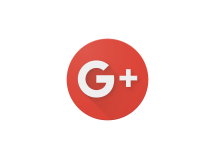 This relatively new entrant to the social connection marketplace is designed to allow users to build circles of contacts that they are able to interact with and that is integrated with other Google products. It also has features to look around the people nearby who are also using Google +. Therefore, it allows users to meet with new people. Google is aiming towards creating a sense of community amongst its users by creating opportunities for people to share status, send pictures, and communicate easily with one another.
This relatively new entrant to the social connection marketplace is designed to allow users to build circles of contacts that they are able to interact with and that is integrated with other Google products. It also has features to look around the people nearby who are also using Google +. Therefore, it allows users to meet with new people. Google is aiming towards creating a sense of community amongst its users by creating opportunities for people to share status, send pictures, and communicate easily with one another.
MySpace
MySpace was launched in August 2003. Though it initially began as a general social media site, MySpace has evolved to focus on social entertainment, providing a venue for social connections related to movies, music games and more. MySpace was once the largest social network site from 2005 to 2008 [43]. In December 2008, MySpace experienced its peak U.S. traffic amount of 75.9 million visitors but eventually it fell behind competitors like Twitter, Facebook, and Instagram. By the end of 2015, MySpace had 15 million global users.
Yik Yak
Yik Yak is a social media application that allows people to post Yaks about the location that they are in. This application uses location service and shows a live feed of yaks that people within a 1.5 mile radius of you have posted. This allows people in the same location to share their thoughts and feelings. These posts can be published anonymously or with any name of your choice. Yik Yak is currently only available as an application for ios and android phones. Yik Yak has been growing in popularity especially on college campuses [44]
Backpack
Backpack provides a hassle-free, secure and cost-effective online overseas shopping experience. Travelers from all over the world carry foreign products for shoppers who request them.
Ask.Fm
Ask.fm is a social media site where users can ask each other questions with the option of being anonymous. It was founded in Latvia during the summer of 2010 to compete with Formspring, which it easily overtook by generating 150 million monthly unique users as of March 2016. [45]
Hootsuite
Hootsuite is a social media management tool. You could use this service on their website or on their app accessible on any mobile device. This tool gives you the ability to link multiple social media platforms and manage all of them from one place. You could upload content and customize your information to match what the followers expect from each social media platform. You could also schedule the service to post the content at a future date. This helps PR professionals better understand their social media followers through the statistics and analytics that Hootsuite provides them with. This service also allows you to create customized campaigns and integrate them into your company’s website. [46]
YouTube
Youtube is a social media platform that allows users to share and view video content. It is also a great platform for advertising, which always shows a preview of a movie or promotion of a product before the video actually begins. Hence, it is an outlet for creativity and also has evolved into a business as many businesses use YouTube channels to promote their products and services. This type of new media has also made the world smaller since it quickly connects users from every corner of the world. It fosters a sense of community and its user base has grown to 1 billion with trillions of views of videos since its inception. [47]
Flickr
Flickr is an image hosting and video hosting website and web services suite that was created by Ludicorp in 2004 and acquired by Yahoo on March 20, 2005[48]In addition to being a popular website for users to share and embed personal photographs, and effectively an online community, the service is widely used by photo researchers and by bloggers to host images that they embed in blogs and social media.[49] The Verge reported in March 2013 that Flickr had a total of 87 million registered members and more than 3.5 million new images uploaded daily.[50] However, in March 2016 Flickr announced that they are only allowing auto-uploads from the desktop for paying customers. Wired declared “Time to Give up on Flickr, Everybody.” [51]
Pinterest is a social media platform for sharing images. The main focus of the website is for pictures. This social media platform is really interactive in the sense that when you click on a picture of a product it may take you to the site where you can purchase it or when you click a picture of a food it may take you to the recipe to make it.
Picasa
Similar to Flickr, Picasa provides a way to organize and share photos. It is a Google product and so offers integrated tagging and sharing with Google+. Picasa is known as an image viewer which has special characteristics like- organizing and editing for digital photos and has some photo sharing qualities. For organizing photos, Picasa has some great features like tracking, tags, Facial recognition, collection for shorting. There is a similar function to Windows Explorer in Picasa in viewing the image. Like other computer applications, Google's Picasa did an invention named Hello which was renowned for sending images free through the internet and blogs. It was similar to instant messages, but unfortunately, they shut it down as they were focusing on developing on Picasa and web albums and google talk. They ensured about user's photo by saying that they do not have any access on the customer's property.[52]
Reddit is a “social news website and forum” where a variety of topics are discussed from politics to technology and music. This is a great place for people with similar interests to come together to discuss any upcoming news and a way for the community to grow and share knowledge. Reddit is composed of hundreds of sub-communities called "Subreddits". The purpose of this website is that it is a social news platform and forum where stories are "Socially curated and Promoted by site members"[53]. Reddit was launch in 2005 by founder Steve Huffman and Alexis Ohanian but was later bought by Conde Nast Publications in 2006. The site is a collection of user submitted content that is divide into categories ranging from education, entertainment, image sharing, Technology, and Meta and in each of these categories, there are subreddits in order to get concentrated information on a subject. Reddit has risen through prominence with its use of AMA's in which President Barack Obama participated in 2012 and in 2014 Jared Leto and Snoop Dogg purchase a stake worth over $50 million. [54]
The variety of “subreddits” on Reddit is endless. It can include basketball, gaming, politics, cooking, books, science, animals and much more. On these subreddits, registered members can submit content such as text posts or direct links. Their users then can “upvote” or “downvote” the posts and determine its position on the site’s page. In the post itself, users can comment with a text or a direct link as well. In a time where social media is becoming more prevalent into our lives, Reddit is the perfect place to know what is happening around the world. There is a subreddit called “worldnews” where users will post with credible links to show what is happening these days.
9GAG
9GAG is a social media platform and webpage, that allows users to share user-generated content by uploading images and GIFs for others to view. 9GAG was founded in 2008 by 5 individuals, Ray Chan, Chris Chan, Brian Yu, Derek Chan, and Marco Fung. The platform has a system of votes for submissions that is similar to the point system on Reddit. Like Reddit, it is often compared to the variety of subjects on similar websites. 9GAG mainly focuses on entertainment through comedy, or gags, hence the name. The platform has many categories and themes to explore, including comedy, relationships, sports, movies & TV, cute animals, and dark humor. It originally started out as a webpage with 9 gags but has evolved since.[55]
Vine
Vine is a short-length video producing and distributing service. Videos created on Vine, also called "Vines," can reach a maximum length of 6 seconds and are meant to be played on loop. Much like Twitter and Tumblr, sharing has a special name; for Vine, it's called Revine. Vine was developed in June 2012 by Dom Hofmann, Rus Yusupov, and Colin Kroll. The project was bought out by Twitter, right before their release. Nash Grier, KingBach, Brittany Furlan, Jerome Jarre, and Curtis Lepore round out the top 5 in terms of Vine followers. All of whom use their 6 second clips for comedic means. [56] Vine had become rapidly attractive and well-known. French music group Daft Punk used Vine to release the track list to their 2013 album "Random Access Memories." [57] Dunkin Donuts used 6-second Vines to create a band of commercials centered around a Monday Night Football game between Philadelphia and Washington. Four years after Twitter acquired Vine for 30 million dollars, Vine was shut down due to it's inability to match previous year's growth and larger competitors like Snapchat and Instagram. This move came as a surprise to many and a lot of major Vine stars have shifted to Instagram and Youtube. [58]
TikTok
TikTok is a new mainstream app that works on Android and iOS devices, created by a Chinese developer known as ByteDance. The app is meant for individuals to share, create and engage with lip-syncing videos that may include singing, creating skits, dancing and more entertainment. Users on the app create short music and lip-sync videos of 3 to 15 seconds and short looping videos of 3 to 60 seconds.[59] Within the first half of 2018, the app became the world's most downloaded app in the Apple's App store with an estimated 104 million downloads.[60]
Since its creation, it has caused much controversy and excitement within the social media industries. To many, this app is a staple piece for the Gen-Z generation due to the fact that the users are segmented to be a younger generation. The platform’s origin derives from another formally popular platform known as Musical.ly, created by the same developers as TikTok. However, due to this platform’s decline in success, Musical.ly decided to rebrand themselves in a relaunch known to be what it currently is TikTok today. With their relaunch, the platform takes elements from another former popular app known as Vine, to become more of a playful place for memes and self-expression. Due to the fact that it carries similar qualities and humorist traits from such applications as Vine, it has additionally combined elements such as lip-syncing videos from Musically to become what is it today. This rebranding, inevitably, becomes the source for its sky-rocketing success and a reason as to why many are hooked on the trends to come from this platform.
As the platform continues to grow successfully, many users have become well-known from this platform as their videos become viral and trends evolve from their participation. Additionally, from this platform, many who have successfully gone viral have used TikTok as a way to jumpstart their career in entertainment, whether that be singing, dancing, acting or even modeling. From their prominent success with the content posted, many young users use TikTok in hopes of becoming what is known as "TikTok Famous" where the user becomes a social media influencer from their high engagement and presence within on this application. Now, although it serves much success for young users, within February 2019, the platform was battling a controversial issue regarding by a record-breaking $5.7 million FTC fine for illegally collecting data from children under the age of 13. [61].
Additionally, with the platform originating from Bejing, much controversy came from this matter and the app was accused of censoring pro Hong-Kong videos. There have also been issues regarding the LGPTQ community as TikTok has banned these videos in more conservative regions such as Turkey and, currently, the app is facing an investigation on the threat this app faces onto American citizens as Lawmakers are worried of TikTok spying on individuals and censoring content. [62]
Though it serves much controversy with current political affairs, TikTok's presence has given users the ability to maximize their growth and go viral. The formula for becoming viral is often a tricky one to handle, yet through the millions of views received from the app, the viewers are intaking all the content that they are watching, actively engaging with creators, and, most importantly, sharing the content to others. Much of the success is due to the algorithm which enhances social mobility, and targeted outreach efforts that ensure popular users are up on the latest trends.[63]
TikTok has skyrocketed the music industry, increasing engagement, and has many tuned into music they would have otherwise never heard before. With the ability to go viral, every track attached to each video increases the likeliness of one to listen to each audio through other music streaming platforms such as Spotify, Apple Music, and others. An artist by the name Lil Nas X is an example of the uprising star whose fame derived from the viral trends acquired his music within the 15-second clips. Through the viral success, his music has spent 19 weeks atop the Billboard Hot 100 [64] Many times, these top hits become viral through a shared hashtag sharing a challenge. "Truth Hurts" by Lizzo has even come back since its initial production in 2017, yet through the viral #DNATest Challenge, the song has become one of the top hits for 2019.[65]
TikTok has also resulted in instant celebrities that have become household names in less than a year. Currently (12/09/20), the five most-followed accounts are: Charli D'amelio with 102.5 million followers, Addison Rae with 71.1 million followers, Zach King with 53.2 million followers, Loren Gray with 50.0 million followers, and Spencer X with 49.7 million followers.[66] At 15 years old, Charli D'Amelio is the most famous TikToker and has even made appearances on mainstream entertainment such as The Tonight Show with Jimmy Fallon.
TikTok has really been changing the game recently. It has really shown me that there is no limit to creativity and that there are so many creative people in this world. Creative content ranges from funny, romantic, sad, informational, to challenges, and trending videos and the list goes on. People have mistaken Tiktok for an app for teens only, and refuse to change their perception of it being friendly and influential for all ages. If you're having a bad day, open up TikTok and scroll away. Next thing you know, you will be laughing so hard, you'll find yourself barely catching a breath. It really lightens up the mood and can make one forget and escape reality for a second. TikTok differentiates itself from any other social media app or website due to the different forms of content that can be created with several different features that can be added, and can make it even more fun and entertaining to watch.
Podcasting
A podcast is a digital medium consisting of an episodic series of audio, video, PDF, or ePub files subscribed to and downloaded through web syndication or streamed online to a computer or mobile device. The word is a neologism derived from "broadcast" and "pod" from the success of the iPod, as audio podcasts are often listened to on portable media players.[67]
Unlike Internet radio, users don't have to 'tune in' to a particular broadcast. Instead, they download the podcast on-demand or subscribe via an RSS (Really Simple Syndication) feed, which automatically downloads the podcast to their computers. The technology is similar to that used by TiVo, a personal video recorder that lets users set which programs they'd like to record and then automatically records those programs for later viewing. Podcasting was developed in 2004 by former MTV video jockey Adam Curry and software developer Dave Winer. Curry wrote a program, called iPodder, which enabled him to automatically download Internet radio broadcasts to his iPod. Several developers improved upon his idea, and podcasting was officially born. Curry now hosts a show called The Daily Source Code, one of the most popular podcasts on the Internet.
Right now, podcasting is free from government regulation. Podcasters don't need to buy a license to broadcast their programming, as radio stations do, and they don't need to conform to the Federal Communication Commission's (FCC) broadcast decency regulations. That means anything goes -- from four-letter words to sexually explicit content. Copyright law does apply to podcasting, though. Podcasters can copyright or license their work -- Creative Commons is just one online resource for copyrights and licenses.
Although several corporations and big broadcast companies have ventured into the medium, many podcasters are amateurs broadcasting from home studios. Because podcasters don't rely on ratings as radio broadcasters do, the subject matter of podcasts can range from the refined to the silly to the excruciatingly mundane. Podcasters typically cater to a niche group of listeners. By podcasting consistently on one subject, podcasters not only assert their expertise on the subject matter but also draw a loyal and devoted group of listeners. Podcasts are also used for informational and educational purposes -- self-guided walking tours, talk shows, and training are all available through podcasting, according to Podcasting Tools.
Several companies are trying to turn podcasting into a profitable business. Podcasting aggregators such as PodcastAlley.com and Podcast.net now feature advertisements. The Podcast Network, based in Australia, runs commercials and sponsorships during its audio broadcasts. Television networks have gotten into the action, too. National Public Radio, the Canadian Broadcasting Corporation, and the BBC have begun podcasting some of their shows. Corporations such as Heineken and General Motors have created their podcasts to attract consumers.[68]
Yelp
Yelp, founded in 2004, was a social networking platform to help connect individuals to local businesses. Yelp is a great place to look for restaurants to eat at. People who are interested in trying out different restaurants come together to pool their thoughts on the price, quality, and experience they had there. It is a great form of social media to look into when you are in an unfamiliar place since Yelp can be searched by location, price, and cuisine. What is also good about Yelp is that usually there will be numerous reviews for a certain restaurant so you are able to decide what the general consensus is. However, the downfall is that owners of restaurants allegedly write their own review or pay people to write positive reviews for their restaurants. This is a breach of integrity and makes it difficult for potential customers to truly identify if the restaurants would fit their preference or not.
Vero
Vero[69] is a new social networking app that launched in 2015. It features a sleek and clean user interface. Similar to other social networking apps it allows for the uploading and sharing of videos and pictures but also allows for the sharing and recommending of music and books. Vero prides itself for being free from advertisements and allowing for images to be uploaded at their highest resolutions without being compressed unlike Facebook, Twitter, and Instagram.
Currently, Vero is a free to use app but according to the app's CEO Ayman Hariri they plan to charge users for a subscription fee after one year of free use.[70]
V LIVE
V LIVE is a live streaming video-based platform founded in South Korea by Naver Corporation and officially launched to the masses in August 2015. Specifically curated with the purpose of connecting global fans with popular South Korean idols, this particular content sharing entity of new media (available both online and on smartphone devices) is a unique social media platform in which only verified celebrities are able to upload videos to the social media site.[71] However, the general public and fans of these artists are allowed to create accounts upon which they can comment on the idols' live streams which get displayed to the artists in real-time. During the live stream, fans are able to tap hearts on their iOS or Android devices in order to further propel engagement with that particular artist's live stream which would, in turn, boost their daily, weekly, or monthly ranking on the V LIVE charts. Once a live stream ends, fans who either missed the alert of the live stream (should they be following the respective artist's channel) or could not make it in time to participate are able to watch a replay of the live stream that will be reuploaded to the artist's channel. As the artists uploading videos are mainly speaking in Korean, multilingual viewers from all over the world are able to help their community of fans by submitting fan-made subtitles for those who don't understand Korean.
For the month of November 2018, Sensor Tower reports that V LIVE received 300,000+ downloads worldwide and made a parallel $300,000+ worldwide on the Apple Store alone. In the same month, Sensor Tower denotes a whopping 400,000+ downloads worldwide with a $100,000+ revenue worldwide on Google Play.[72] Considering the fact that these data mined analytics were reported just from the month of November 2018 alone, along with the fact that V LIVE is a freemium app, the results truly show how fans all around the world are eager to converge the obstacle of distance just to be able to interact with their favorite celebrities. The global aspect of this app is further substantiated by Amazon's marketing stack Alexa which showcases that only 23.5% of V LIVE's website demographics come from its mother-country South Korea. Meanwhile, 13.6% of the audience clicks in from China, 8.6% from the United States, 6.0% from Indonesia, and 5.0% from Japan.[73]
In reference to V LIVE's freemium functionality, Naver implemented V LIVE+ in January 2018. After paying a subscription fee, viewers are able to feel like part of an "exclusive" subcommunity in which the artists release extra content in the form of video-series, photos, etc. which remain unreleased to the general or casual viewer. In the case to help the exclusive content stay private within the subgroup, Naver regularly monitors other social media sites and content sharing platforms, as well as having fans e-mail in instances of leaks to quickly take action to have them taken down. An additional bonus of V LIVE+ is the ability to download all videos uploaded in high definition, a feature frequently requested by fans but currently unavailable to non-subscribers.[74]
With the global COVID-19 coronavirus pandemic going on, which has led to a near-complete halt to live music events. Live streaming events have become popular as an alternative, but the "Beyond Series" is also a way to bring K-pop live concerts to fans across the globe. Although K - pop concert had Live in the past, including other SM entertainment, but "Beyond Live" series systematically provides an alternative Live concert experience means of monetization, including tickets: at present, the first adoption of SuperM Beyond Live concert pricing through Naver V App can access the cost of the music on the two devices. [75]The show was streamed live on Naver’s V Live and involved fun features that allowed the artist to interact with the online audience. Through the live concert of Naver's Vlive, the unique performance of the artists, and the technology combining AR and interactive communication, it has received an explosive response from fans around the world.[76]
Sina Weibo
Sina Weibo, most commonly known as Weibo, is a social media platform most used in China, working as an equivalent of blocked services, Twitter, Facebook, etc. Launched by Sina Corporation in August 2009, Weibo has over 462 million monthly active users [77]. Due to the banning of Twitter and Facebook among other social media platforms, Weibo was launched in efforts to continue the flow of posts while being monitored for sensitive material [78]. Acting similar to Twitter, Weibo has a 140 character limit per post. Users of Weibo are able to perform live broadcasting, buy and sell products, start polls, play games, upload short videos, and make money through advertisements, paid posting, monetary rewards by other users, and paid subscriptions[79]. But actually, Weibo is more versatile than Twitter, and its functions are more like a combination of Twitter and Facebook.[80] Users are able to be differentiated with the use of "V icons", no V meaning regular users, verified individuals with an orange V, and companies and organizations with a blue V. Users are able to follow their favorite stars and organizations knowing them to be real accounts and not impersonations.
As of November 2019, Sina Weibo has over 10 million installations on Google Play [81]. This low number does not represent the number of installations in China which has reached over 400 million. Most Weibo users utilize the platform through the mobile app, which contains over 94% of the monthly active users.
Professional Social Networking Platforms
Professional social networks are designed to provide opportunities for career-related growth. Some of these types of networks provide a general forum for professionals to connect, while others are focused on specific occupations or interests. A few examples of professional social networks are listed below.
The site was officially launched in May 2003 and confounded by Reid Hoffman, a former Executive Vice President in charge of business and corporate development for PayPal. Currently, LinkedIn has over 200 million users from 200 different countries and 170 industries. The primary use of LinkedIn is for professional networking, connecting, and job searching. People often use this site to put up their resume and use connections to look for jobs. Companies use LinkedIn to recruit potential employees from a large pool of people and post information such as position spots and job descriptions. A typical user profile page contains employment history, education level, and network members or "connections". It is very limited to customization but is free. Unlike other free social networking sites like Facebook or Twitter, LinkedIn requires connections to have a pre-existing relationship. LinkedIn has two types of membership, basic, and premium. The basic membership means that the user can only establish connections with someone he has worked with, knows professionally (online or offline), or has gone to school with. This doesn't give much leeway in making new connections. On the other hand, the premium membership allows for better use of the database, through more access to connections in the database. Overall, LinkedIn is probably the most used form of social media for job searches or hiring of employees and can be credited for a large percentage of people finding jobs.[82] As of July 2015, LinkedIn currently has more than 364 million unique active members, making it the largest online professional network.[1] Subscribers have the opportunity to build relationships by making connections and joining different types of groups varying from demographics to professionals. Some recruiters are known as the "Head Hunters" are also using LinkedIn to find talents. Therefore, it is very crucial to have a nice and well organized personal description.
LinkedIn is a social media platform for the business community. LinkedIn is probably the most obvious choice for employers and students alike to use as a job searching tool. The idea of LinkedIn is to allow people to form connections with professionals and allow them to expand their network. It is a professional social networking site where employers can see an individual’s work experience and interests. Employers can also post job and internship openings for a limited amount of time for a fee. These job openings are constantly shown to prospects that match the employer’s preferences in a potential candidate. This is a great way for headhunters to look for potential candidates that will fit the culture of the firm and the qualifications in candidates the firm is looking for.
Building a LinkedIn Profile that Builds Your Career
With just a little work, CPAs can lay the foundation for an online presence that boosts their professional persona and prospects.
Just a few short years ago, you could safely ignore your digital footprint and it wouldn't affect your real-world interactions. Today, that's no longer the case. Your digital presence has an effect—either positive or negative—on your career and business. Whether you are looking to attract new clients, advance in your firm, or find a new opportunity, your online presence shapes how others view you.
One of the easiest and most powerful ways you can take control of your online presence is to harness the reach and influence of your LinkedIn profile. Many online-savvy people who also are active on Facebook, Instagram, Twitter, YouTube, and other social media outlets use their LinkedIn profile as the cornerstone for their online professional brand. LinkedIn can lead the way in influencing how others engage with you in your online and offline interactions. This article shows how to use LinkedIn to move your career forward.
3 STRATEGIC QUESTIONS MAKE ALL THE DIFFERENCE The omnipresence of digital information has flipped the traditional process of how we establish business relationships. In the past, we would extend provisional trust to someone and then build a working relationship to bolster that trust. Now, we can research and investigate someone before we ever engage. In fact, we can decide whether we even want to start a professional conversation based on what we find.
That's why it's important to control the brand messages that you are sending online. A great place to start is with LinkedIn, which has a huge footprint with more than 400 million members. If you do a Google search on yourself, there's a good chance that your LinkedIn profile will be one of the top results. If you have an unfinished or sloppy LinkedIn profile, that's not the first impression you want to make with someone who could be a client, a colleague, or an employer. Luckily, a little time and attention can take your LinkedIn profile from lackluster to outstanding (see the sidebar "Examples of Good and Bad LinkedIn Profiles").
At the root of every ineffective LinkedIn profile and wasted status update is a lack of planning. It's important to know what you are trying to say before you look at the ways that you can say it. Asking and answering a few simple strategic questions can greatly improve how effective, efficient, and easy-to-use your LinkedIn profile is.
What are your most important business goals?
Though your career or business goals may seem obvious to you, it's important to articulate them with specificity. This process can be as simple as saying, "I want to develop stronger relationships with the leaders in my firm to get on a partner track in the next 12 months." If you are trying to get new clients, you could say, "I want to increase my pipeline of business owners so that I can close five additional deals this quarter."
Who is the most important audience for you to communicate with?
Many different people will view your profile. If you try to speak to all of them at the same time, your message will become muddled. Identify the most useful group to engage with, and focus your profile and content on these people. For example, if you want to bring in new clients, speak directly to the target market that you serve: business owners, families, etc. Or if your business goals require you to be seen as an expert, engage with centers of influence or decision-makers at other firms.
What message does that audience need to hear?
Once you know exactly who is in your target audience, consider what they need to hear from you. The best communicators don't focus on what they want to say but on the information their audience needs or wants to receive. This is the core of your personal brand. Understanding how you want to be perceived is a critical step toward sharing effectively on LinkedIn. Imagine that you are talking to your profile visitor offline. What would you highlight? Would you focus on your experience, your passion for your work, or your unique ability to solve their problems? That's what your profile should focus on.
HOW TO CRAFT AN OPTIMIZED LINKEDIN PROFILE Once you've decided what message you want to share, and whom you want to share it with, the next step is to dive into crafting your profile. It can be overwhelming to look at the different sections and fields on the profile. Fortunately, you can focus on a few sections that do a lot of the heavy lifting to communicate your brand.
The LinkedIn headline
Found right underneath your name, the LinkedIn headline is up to 120 characters long and fulfills some incredibly important functions. Eye-tracking studies show that people spend more time on average reading the headline than on any other part of the profile. The headline, like those in a newspaper, is the key to grabbing readers' attention and then convincing them to read more on the page.
Instead of leaving your headline as the default (your job title), you can use keywords to draw in readers. Refer to whom you help and how you help them. What's more powerful: CPA at Firm X, Y, and Z or Public Accountant Helping Businesses Manage Complex Tax Issues? A simple template is filling in the blanks: "Helping (insert whom you help) with (what you help them with)."
Profile photo
If a picture is worth a thousand words, what are the thousand words of your profile photo saying about you? More and more of our online interaction is becoming visually based, and how you present yourself is a key component of your online presence. People like to see whom they are interacting with.
LinkedIn has reported that a profile with a photo gets up to 14 times more views than a profile without a photo. It's hard to define the "perfect" photo because it can be subjective and depend on a lot of variables. But here are three easy elements to keep in mind:
Keep your profile photo consistent with the rest of the information you are sharing. Ask yourself, "Is the person in the photo the same person that the visitor is reading about?" If you talk about how hard you work for your customers, but your photo is of you lounging on a beach, there's a mismatch. Make sure it's a polished photo. Both you and the photo itself need to have a certain degree of professional polish. You don't need an uptight headshot, but you have to convey that others can trust your competence. Low-grade or inappropriate photos don't do that. Balance that polish with approachability. Humanize yourself. Does the person in your photo look like someone with whom others would feel comfortable interacting? (See "Examples of Bad and Good LinkedIn Headers" below)
Bad Header
Good Header
[83]
Jobs/Employment
A 2015 Pew research study may have found that over half (54 percent) of U.S. adults have turned to the internet to look up job information – and 45 percent had applied to jobs online. However, among people who actively sought employment over the previous two years, a whopping 79 percent said that they utilized online resources, over 10 percent higher than those who said that they reached out to their personal connections.
Before social media, people who were seeking employment traditionally relied on the “Good Old Boy’s Club” in an informal system through which men would use their positions of influence to help others who attended the same school or university as they did or who share a similar social background. This resulted in a homogeneous workplace, with very few minorities and even fewer women. This “club” established who the winners of the job market would be, and essentially the losers were everyone outside this elite circle.
Scholars have noted that as time progressed, and boardrooms and offices became more diverse, there’s been an emergence of what’s been dubbed, the “old girl network,” a newer and more modern version of the old boy’s network where women would mutually assist other women who belong to a particular group, be it a sorority or alumnae of a school in gaining leverage in the job market.
These two methods of landing a job haven’t disappeared, but perhaps they’ve evolved to survive within a new interaction landscape. There are Twitter accounts and Facebook pages dedicated to alumni of the same university. Students connect with their classmates on sites like Linkedin, Indeed, and Facebook where users often share career tips, statuses about job advancement, and news about employment openings.
There are many business-social networking sites that mainly focus on helping individuals create a professional network of relationships as well as searching for jobs, and opportunities. Professional recruiters have started to utilize these social media platforms in their search for potential candidates, and these recruiters mainly search through larger social networking sites such as Myspace and Facebook (Flank Langfitt, 2006) According to online, business networking communities, Academy(www.ecademy.com), Friendster (www.friendster.com) and LinkedIn( www.linkedin.com) are three of the most popular business social networking sites. “Linked-in focuses on professional users creating of co-workers and another business associate. Those sites allow users to look for jobs, seeking out experts in a particular area or to make a contact with other professionals through a chain of trusted connections.” (O’Murcha, John G.Breslin, Stefan Decker, 2004[84] LinkedIn utilizes user data and user profiles in order to help create a suggested jobs page that is tailored for each individual user and best fits their prior work experience.
Lately, it can be seen that increasing numbers of employers have integrated the use of social networking sites in their search for the most suitable candidates, and talents. Ever since the popularization of social networking sites, the percentage of employers using them as a tool for assessing their potential job applicants has been increasing exponentially with a huge jump of 45 percent of them using them in 2009 (Jamie Vicknair, 2010[85]). Since then, the Society for Human Resource Management has found that 84 percent of them uses them (Roy Maurer, 2016[86]). As said in an Article by Forbes "Estimates suggest that around 25% of all jobs filled in the United States are done so via this more informal form of recruitment" so, in other words, the growth of social networking sites like LinkedIn are rising in there usefulness in job search if 25% of all job recruitment is done outside of the traditional form. When using social networking sites for a job search can also lead to increase social skills since you will be able to network to build your connections in the job market you are pursuing, which LinkedIn helps with since you're able to do that through their website[2]. In fact, employers will have a clear disadvantage if they do not utilize new media in their recruiting efforts. They will clearly lose out on potential great hires due to the fact that they just weren’t reaching them.
The importance of this is staggering considering that every year millions of students are graduating and entering the job market. These fresh graduates are different than in the past in their interests and styles, but now we see that their potential employers are changing as well. To be able to start a career, a graduate needs to understand how they can reach their potential employers and expose their talents to them. At the same time, employers need to recognize shifts in how new graduates fundamentally operate and how they can attract the best talent for the success of their business.
We can look at Deloitte in the Netherlands and how they were able to utilize social media for their recruiting efforts in a labor market with only 10 percent of people looking for jobs. For Deloitte their recruitment strategy “is shifting more towards internet marketing, content management and measuring traffic to your career site/page” (Lurent Brouat[87]). To make an impact with all potential candidates, it was important for their career website to be great and easy to navigate. Especially if they want to attract younger students and recent graduates who may not have as much experience yet, it was vital for their website to be simplified. They do a great job of clearly categorizing the website into three categories: students, young professional, and professionals. Their recruitment staff also utilized their social media sites by posting their own profiles to foster a sense of community, which would speak to young millennials who may be intimidated by the prestige of a Big Four accounting firm.
Deloitte NL utilized social media to help with their branding and they did this in two different examples. The first method they used was to use their current employees who had an interest in blogging to blog about what they do at work and what they like about their job. This is extremely attractive to young students because it answers the two basic questions that all students have about a career. They also ask their current employees to share their Twitter accounts so that their posts show up in the Deloitte Twitter feed. This is just another way to create that sense of community mentioned before. The second example was to set up a photo competition where current employees took pictures of the Deloitte logo and uploaded it to their social media accounts with a hash tag. The employee with the most amounts of views and creativity won an iPhone.
These methods were extremely effective producing 234 percent more traffic that came from social media compared to other sources (Lurent Brouat[88]) and meeting their goals for recruiting.
Companies such as Google, though they have a great reputation and amazing benefits, utilize their current employees to attract new candidates. They encourage current employees to post job openings themselves through status updates on social networking sites. When a current employee is supporting the benefits of working at the firm the job posts become that much more meaningful as well as expands the reach to people who are not directly connected to the company (Sannelli)[89].
Through new media, employers are utilizing methods for bringing in talent that isn't necessarily looking for a job. These types of candidates are called passive candidates. These candidates can be proven workers who are currently satisfied with their current job, but it can also include students who are not aware of opportunities that are out there. “Searching for passive candidates is one of the keys to social recruiting, especially in trying to find niche candidates,” said Jeffery Giesener, CEO and founder of SourceMob (Maurer[90]). As a student that is still learning about their chosen industry that they want to join, it is hard to know about which companies would be able to help jump-start their careers. Using social media, employers can look for these passive candidates and try to teach students while they are still not fully knowledgeable about their career path and talent.
By making a connection with people on those platforms, it also gives disabled people an opportunity to search for a job. From the article, Employment Issue written by Joe Strechay, [91] it talks about in the 1980s when television was classified “new media.” Geri Jewell had cerebral palsy, and she was one of the first people with a disability to have a regular role on a primetime television show. Although she is disabled, she was intelligent and funny, and that is the reason why she became a very successful comedian during the 1980s. Nowadays, new media like Facebook and Twitter give disabled people a platform to search for jobs, and employers can use those media to reach them. From the article, Huge Demographic Virtually Invisible in Media Wants to be Seen written by Christina Ng, it describes people with disability have a huge impact on economic. The statistic shows that they have a spending power of $200 billion to $500 billion. President and founder of Springboard Consulting, Vogel, once said "Disability doesn't discriminate. It hits all income levels, all nationalities, all races. We tend to separate it, but you can't." We cannot ignore the power of disabled people on our economy. In addition, Springboard Consulting is providing extraordinary good customer service to people with disabilities. Vogel thinks that “not only are they catering to people with disabilities but they're catering to the friends and families of people with disabilities...so it's one of those things that fans out exponentially.” Furthermore, Springboard Consulting actively market to people with disability and helps recruit and support them in the workforce.
In promoting employment, WeChat serves employment and entrepreneurship in new forms, promotes individuals to connect with the market through the network platform, and realized the individual market. Field value has released the huge potential of mass entrepreneurship and innovation and promoted the employment of the whole society. According to the estimate, in 2017, the employment scale of WeChat driven society reached 20.3 million people, double that of 2014, of which 49.66 million were directly employed and 15.34 million were indirectly employed.
New media not only gives disabled people a platform to reach for jobs but also earn money by simply posting. A lot of people are Youtuber nowadays, and their job is to post their works online and earn money based on how many likes, followers and subscribers they have. If they have a good amount of followers and subscribers, then they can earn a good living. For instance, from the article, The Missing Link: Why Disabled People Can’t Afford to Delete Facebook written by Frances Ryan, [93] it talks about how Hannah Hodgson, who has an intestinal failure and hearing loss and collapses several times a day, earn money on Youtube. She cannot go to school like other children because he has to stay in bed, and she uses Youtube as a platform to create a community for people with a rare health condition. She posts and shares her life on Youtube, where she has more than 2000 subscribers. She can earn a good living on Youtube. Another example includes Alice Strick who has severe depression and borderline personality disorder. She was unable to find an art shop work she could afford during her recovery, so she used Facebook to set up her own workshop. She also formed a connection in Instagram where she has been commissioned. She once said "Without social media, I wouldn't have had a career that I love and I'm proud of. I wouldn't be so far along in my mental health recovery." Those are only two of the millions of examples in the world. We might think those new media only entertain us, but they can be the only job for disabled people to have.
Classroom 2.0
Social network specifically designed to help teachers connect, share and help each other with profession-specific matters.
Nurse Connect
Nurse Connect is an online community designed to help individuals in the nursing profession connect and communicate with each other.
Social Networking Messengers
Snapchat
Snapchat is a video messaging application, that allows users to communicate with friends using photos, videos, text, and drawings. The unique interface allows users to take photos and videos that will self-destruct seconds after the recipient opens the file. This unique feature allows users to send media without the fear of it being shared. Snapchat also allows users to draw on the pictures and videos they take before sending. This allows for customization of photos and videos allowing the user to add a unique touch. As of May 2014, users of the app were sending 700 million photos and videos per day while the content was being viewed 500 million times a day. According to multiple sources, the company is worth roughly $10-$20 billion. [94] As of March 2015, Snapchat has more than 200 millions users worldwide.[3]
Snapchat has revolutionized the way society views celebrities' lifestyles. Before Snapchat came into existence, the only way society could look into the luxurious lifestyles of celebrities was through a third party whether that may be television, newspapers, and tabloids. The concept of being able to view how celebrities spend their money has always been interesting to society. Paparazzi became the middle man, notifying society where and when celebrities are. With the invention of Snapchat, celebrities can post pictures and videos of themselves performing daily activities, giving their fans a sneak peek into what they are doing. This diminishes the wall between fame and reality and allows users to get a better feel of how their favorite actress spends her day. Celebrities can interact with their fan better through this platform as well. For example, a family that has really taken advantage of this concept is the Kardashian and Jenner clan. The clan provides exclusive access to their home, pets, makeup routine, clothing line, family, friends. Thus, making users feel like they are also apart of their life too. The concept of real-time sharing really entices users and helps promote products on a well-populated platform.
Since January 2015, Snapchat has added a new feature called "Discover" which allows the user to access stories that companies may share online for the public to view. These stories allow companies such as ESPN, Food Network, and CNN to post videos to the Snapchat Discover content. This discover content can be viewed by Snapchat users from around the world. Once a user subscribes to the medium of their choice, a new snippet is provided to them every 24 hours. This allows companies to advertise themselves as well as broadcasting to a larger audience. Snapchat not only allows users to communicate with each other, but companies are able to communicate with consumers as well. News outlets and magazines such as The New York Times, National Geographic's and Cosmopolitan, just to name a few, post new current events and magazine snippets which disappear after 24 hours.
Along with the launch of "Discover" in January 2015, Snapchat also incorporated a new method for users to add new friends through the use of QR Code, or as Snapchat calls it, "SnapCode". With this new feature, users can snap an image of other users' QR Code in order to add them as friends. People no longer have to search for friends' usernames or phone numbers. This new addition was possible after Snapchat acquired Scan.me, a QR code startup in September 2014 for $50 million. This creates a new opportunity for companies to advertise their company and promote name. Users can also personalize this code by adding a series of photos. [95]
Following the launch of Apple Pay, Snapchat introduced their own version of sharing currency. They named this Snapcash. Snapcash is a feature that Snapchat and Square partnered up to allow users to exchange currency. Signing up and attaching a bank account to Snapchat allows the user to send money and receive money from their friends. The user can type an amount following "$" and the button to send a picture will turn green. By clicking this green button, the user sends the amount displayed to the user they are currently snapping. After sending the money, the recipient can click on it to receive the money that you sent. [96]
Snapchat has launched a new feature where you have access to various filters on the application. The filter does not only include different forms of lighting but also can mark the time the picture was taken and the location. The location filter changes as well based on your location. Other filters that they launch consists of animal ears and even various backgrounds. These filters do not change based on location but they are not permanent. These filters are added and removed based on popularity. This new convention makes Snapchat more interactive and fun as these filters even have special effects. The appeal of these pictures is that you can set the time limit on the picture and after the time frame is up the image disappears and there is no way to view the image again. [97]
Being one of the biggest banks in the world, J.P. Morgan Chase & Co. (JPMC) is in the middle of the negative image of Wall Street. However, their marketing strategy is very subtle compared to other powerhouse banks on the streets. This is the same for their recruitment strategy. One of their latest innovative utilization of social media was when they took over students’ Snapchat feeds in May[98]. Snapchat allows users to create their own filters. JPMC took advantage of this function and created their own ads on Snapchat available for viewing in and around college campuses. These ads ran until mid-June. This strategy was to target students about to enter the job market during the graduation season.
This method was extremely effective because it wasn’t an ad that ruined your experience while using the social media platform. Using filters allows JPMC to take advantage of the “permission format” where users can choose to use the ads in their posts or not. This is just another innovative way Snapchat is being used by regular users as well as corporations.
In October of 2016, Snapchat opened its ads API in part to appease agencies. It’s billed as a “middle-tier” offering, allowing partners to plug into the app to deliver ads on an auction-based basis [99]. According to Snapchat's third-quarter report, they had an average of 249 million daily active users [100].
This application connects people from all over the world. Anyone who downloads the app can text other users free of charge. WhatsApp was purchased by Facebook on February 19, 2014, for $19 billion USD. WhatsApp Messenger is a cross-platform mobile messaging app which allows you to exchange messages without having to pay for SMS. WhatsApp Messenger is available for iPhone, BlackBerry, Android, Windows Phone, and Nokia and yes, those phones can all message each other! [4]. As of July 2017, WhatsApp currently has more than 1.3 billion monthly active users worldwide.[5] Whatsapp has really advanced themselves in the recent past. They initially started as a text messaging and group chat app, then they upgraded themselves by coming up with video and voice call free of charge.[6].Just recently, this year they brought a new feature called WhatsApp Status which allows users to post pictures and videos for 24 hours.
Blackberry Messenger
Blackberry messenger was an internet-based application that allows messages and voice calls between blackberry, IOS, windows phone, and android users. It was one of the first messaging apps to use read receipts and typing indicators. Its main priority was security. Unfortunately, it was officially shut down on May 31, 2019 [101].
Skype
This app isn't new but it is useful for messaging and video chatting. Skype launched back in 2003, but was purchased by Microsoft in 2011 for $8.5 billion dollars. Skype services are free of charge if users are using the app via the Internet. Skype also has paid options for users who wish to make international calls from their cell phones and landlines. Skype translator can translate calls in 7 languages. According to statistics 32 percent of UK teens use Skype and 100 million of registered Skype users are from China. As of July 2015, Skype currently has more than 300 millions users worldwide. It can also be used for recruiting due to the fact that employers can use Skype to video interview with potential employees and hires. Users spend approximately 3 billion minutes on Skype per day. As of February 3rd, 2014 Skype has 4.9 million daily active users. [7]
Omegle
Omegle is a free website, which was launched on March 25, 2009. Through this website, a person can video chat with another stranger. In other words, this website allows the user to pair them with a random person to have a one-to-one conversation. There is no requires doing any registration. Also, the users can filter for people with their choice of interests. For example, a college student can enter their college email address to find other students. Besides, YouTube content creators use Omegle to create their YouTube videos. Some of the famous YouTubers include James Charles, Emma Chamberlain, and many more. Moreover, this is a great entertainment platform to interact with someone new or just to have fun. Omegle website is: https://www.omegle.com/.
Facebook Messenger
Facebook Messenger is an instant message service software that provides text and voice communication. It was developed by Facebook and initially released on August 9, 2011. As of July 2015, Facebook Messenger currently has more than 600 million users worldwide. Facebook Messenger, with its recent updates, has also included various features such as sending photos, videos, emoji stickers, GIFs, location, voice recordings, and even payments. These features allow the app users to have more fun while communicating with others and share information in new forms of media. For example, a lot of the stickers that people are able to download can be referenced to popular and upcoming movies (such as Disney's Frozen and the Hunger Games). These stickers can help promote other characters and brands and is another form of how Facebook can help promote sponsored content. [102]
Facebook Messenger has continuously introduced more and more updates such as video calling in April of 2015 and end-to-end encryption in October of 2016. Users have also been given the ability to send money over messenger in June of 2015. The service allows people to send money to each other free of charge using debit cards. It is only available within the U.S. and with USD; however, there are plans to introduce the service in Europe within the first quarter of 2017. On October 3, 2016, Facebook Messenger Lite was introduced with limited features in order to attract users who utilize slower operating systems and less data connectivity. [103]
KakaoTalk
Commonly referred to as Ka-Talk by Koreans, KakaoTalk is a social media messaging app for smartphones with free texting and calling features. In addition to the aforementioned features, KakaoTalk users can share photos, videos, links, and location, much like that of any messaging application. The app is convenient because with the users' permission to access the contacts list, KakaoTalk automatically syncs contacts to the application which eliminates the hassle of adding friends one by one. Data shows that 93% of all of South Korea's population uses the app and Kakao Corp. has since added even more features including retail commerce and games. The messaging app is also globally accessible as it is available in 15 different languages and used in around 130 different countries. Kakao Talk is gaining popularity as a global communication tool.
WeChat is a mobile phone application developed by Tencent Company in ShenZhen, China. Functions of Wechat are text messaging, voice messaging, one-to-many messaging, photos sharing, video sharing and video chatting. It was first released in January 2011. As of March 2018, WeChat currently has more than 1 Billion users worldwide.
The reason that WeChat has gone viral among the Chinese population is that it enables users to communicate with one another without having to type on the keypad, instead, users just need to hold the "hold to talk" icon in order to speak. The feature also attracts users that are at age 50 and above, which once again proves its ease of use.
In addition to its user-friendly interface, WeChat also allows users to subscribe to channels according to their interests, the channels then feed users with new information on a daily basis. Often, new and existing business owners are increasingly seen using their channels on WeChat to advertise about new products and promotions. Therefore, WeChat really is a multi-functional application that benefits both participating parties of the market, combined with its user-friendly interface, it enables anyone to go above and beyond with their interests. [8]
Nowadays, WeChat is no longer just a social software for instant text, voice, and video transmission. It has been widely used in life, government, business, finance, medical treatment and other aspects, and deeply integrated into people’s daily life, becoming an indispensable daily use tool. As a way of life, WeChat has changed people’s living conditions, and gradually formed a unique WeChat culture, such as “moment” (friend zone) social culture, “like” culture, “red envelope” culture and so on.
WeChat keeps pushing through the old idea and innovates the new ideas, adding different functions such as “checking people nearby,” “moment”, and “WeChat payment”. By the end of 2013, more than 500 million users have registered WeChat. Since then, a new lifestyle of mobile Internet has been established. The age of WeChat has come.
According to the different needs of users, a group can be set up and real-time voice chat can be conducted across regions. Besides in-text chatting, WeChat also supports personal and group voice intercom. Text, picture or video messages sent out can be forward to another friend and can be withdrawn in two minutes. Floor-based conversation makes chat seem more concise and convenient. WeChat itself is a virtual community with the theme of interpersonal relationship. It can send text, expressions, pictures, voice, and video, and even share real-time locations to other friends.
The most innovative feature of WeChat is the “Moment”. This function provides relative privacy for the users and their friends to share pictures, texts, and videos. In the page of the moment, users can set the cover of the album and record text and photos in the “album” that is belonging to the user. The post also has a positioning function, which can display geographical location, publish with text and pictures. The moment must seek the consent of the other users before it can “be allowed” to enter the other user’s moment and browse the information published by the other user. The comments below the sharing posts are only available for the common friends to see. That is to say, WeChat moment has strong personal privacy. Social media has its own way of presentation. With its simple and smooth user interface, WeChast has attracted billions of users to join. Users can send their real-life experiences to friends for recording and sharing. They can also learn about others through the life status recorded by everyone.
Another powerful feature of WeChat is the WeChat Pay. With the rise of the network, mobile payment has become tremendously popular in China. According to the Business Insider, WeChat Pay has a whopping 900 million monthly active users, for comparison, Apply Pay has 127 million users globally. WeChat Pay is associated with “wallet” in the personal home page. The so-called wallet naturally assumes the functions of wallets that people use in daily life. It can be used to transfer money between friends, to pay bills for online shopping, to recharge, to buy movie tickets and other unavoidable business transactions in life. WeChat has a great advantage in the number of users and the real-time convenience of chatting. Moreover, the majority of physical stores are accepting WeChat Pay for consumption. WeChat captures the users’ psychology and adds the function of WeChat Red Packet. There were two types of envelopes, regular envelopes and New York’s red envelop. The maximum amount of the envelope is 200 yuan and the money can distribute equally or random share. According to the Business of Apps, In 2018, 768 million people either sent or received a red envelope over WeChat – a 10% increase over 2017, and this increased further to 820 million in 2019. [104]
WeChat’s mini-programs have brought new ways for businesses to sell their products. A mini-program is a lightweight application that can be used without downloading. It can provide a wide range of services, including taxi, meal delivery, live broadcasting, and shopping. In fact, the application scenarios of the mini-program are becoming more and more abundant. For example, many hospitals use “easy to find”. It’s China’s first indoor navigation mini program that helps registered patients to find the designated location according to the precise location and the planned route. In addition, “China’s trial process information disclosure”, another mini program that enables users to access the trial process information in a timely manner. Also, Wal-Mart’s “scanner purchase” applet makes it possible to “one thing, one code” of goods. Users can complete the checkout in only 5 seconds. The usage rate has reached 30%, and reuse rate is as high as 95%.[[9]]
Line
Line created by Korea-based search engine Naver, is a messaging, media sharing, and video conferencing application that was first released in Japan in 2011. Popular in various countries in Asia and Europe, it has attracted over 600 million users as of February 2015. In 2013, it was listed as Japan's most popular social networking application. While this app is very similar to other communication applications such as WeChat, WhatsApp, and GroupMe, Line is unique due to its creators' intentions. It was first released in Japan because the earthquake of Tōhoku had damaged various communication infrastructures. Because this application is Internet-based, people were able to access it despite the conditions of the nation. Since its launch, Line has incorporated new features such as Payment (similar to Venmo), Line Game, and Line Taxi (similar to Uber)[105]. Such features, like those that many other messaging applications have, are added to create a holistic application that will be more convenient and entertaining to millions of Line users worldwide.
GroupMe
This app is owned by Microsoft and was launched in May 2010. It is a messaging app that allows you to start group chats with any type of smartphone like Android, iPhone, and Windows Phone. The application allows users of all different brands to communicate under one platform and is extremely fast. Instead of society only buying devices such as Apple Inc. to communicate with others in a super fast network, users can download this application to achieve the same communication. The purpose of GroupMe was to provide a real world network for users and help them organize their intimate connections. Users can share videos, pictures, and even their location. It's an ideal application to possess in order to create plans with friends or family. Instead of just privately messaging each individual to figure out what plans to make, users can download the application and easily message more than just one person. With 3G/4G connection or WiFI, communication becomes much easier and faster. [106]
Viber
This app was first known to made by an Israeli company called Viber Media. It was released on December 2nd 2010. It is a messaging app almost closely related to apps like whatsapp and GroupMe. You can share videos , pictures , and texts. One main reason it is used would be to contact family members in other countries just by using wifi and no money needed to spend on phone cards. You can make international calls free of charge. [107]
ICQ
ICQ (I seek you) is one of the earliest online messengers which was created in 1996 by a company called Mirabilis [108]. At the moment of its creation, the app was extremely simple and its users could only exchange messages with each other. As ICQ has been developing over time, in 2017 it reached the same level of features as another apps for communication. ICQ user can now make a phone calls, video calls and share any files [109]. The main characteristic of ICQ is that after registering an account, new user receives a unique code, which can be used as a tool for him to be found by others. In the same way, he can use these codes, to find any person. Because at the time of its creation, there were not too many messengers available to an Internet user, ICQ has gained huge popularity in 2001 [110] by obtaining 100 million registered users. Now popularity of ICQ substantially decreased, leaving only 11 million active users [111]
AIM
AIM (AOL Instant Messenger) was created in May 1997 with it originally being intergrated into AOL Desktop. It was later released as a stand alone download by America Online. AIM's main competitors at that time were ICQ, Yahoo! Messenger and MSN Messenger. In 2008, AIM officially entered the mobile market. Then in 2012 it was avaliable for Microsoft Windows, Windows Mobile, Classic MAC OS, macOS, Android, iOS, and BlackBerry OS.[112] On October 6, 2017, Michael Albers, VP of Communications Product at Oath annoucned that AIM will be discontinued on December 15, 2017.[113]
Video Conferencing
In times of uncertainty such as COVID-19, there is a need for people to connect while in quarantine. This called for the rise of video conferencing in order to connect with college professors, co-workers, and friends. With no end in sight for the end of the pandemic, video conferencing has grown in popularity across all platforms. Videos appeal to the masses because it engages them and allows them to interact with one another in the most authentic way, in real-time, other than speaking face-to-face. Video Conferencing allows accessibility and reliability in engagement that goes beyond phone calls and connect and give people our undivided attention. There are many forms of video communication that could
Video conferencing has numerous benefits that allow communication to be effortless regardless of distance such as allowing for a collaborative meeting environment regardless of distance which fosters a productive relationship between employees, speeding up the decision making process. Making the management of meetings simple — employees gather in one predetermined chat, making any scheduling issues unlikely. Allowing for efficient communication between remote workers and in-office workers. Demanding engagement from its participants—this reduces the likelihood of participants zoning out or multitasking and increases participation as employees are more involved. Having meetings via video boost communication and thus increasing learning—this is due to increased levels of concentration, with a survey conducted by Zoom, revealing that 50% of executives believe video conferencing also improves their degree of understanding.[114]
Video Conferencing can become very essential when you are working from home, as it has become part of the routine for many workers who are seeing a new change in their workplace. Social isolation may have changed the way people interact online, but video conferencing has allowed people of all ages to come together in order to stay connected. The true power of social networking is seen through times when people are unable to actively see each other and must use video applications to have authentic conversations. Interrogating online and real-life couldn't have been witnessed through a more powerful tool like video conferencing, as it is essentially social networking platforms and online communication technologies have become part of social life. [115]
Zoom
Zoom is a video conferencing software. Zoom was founded in 2011 by Eric Yuan, a former Cisco Systems executive. Zoom application connects people from all over the world. Zoom is fairly user friendly, it glitches the least, it offers many cool collaboration tools and it’s easy to connect to Slack and calendars on Google or Outlook. One of the features offered by Zoom is the ability to amuse yourself and others via customized backgrounds. Zoom also includes a feature that can track some aspects of whether a participant is multitasking on a computer and report it back to the host of the call. With Zoom, you don’t need a sign in to join a meeting, as long as you have the meeting ID. It is currently one of the most popular video conferencing software due to the 2019-2020 Coronavirus pandemic. [10] [11]
Microsoft Teams
Microsoft Teams is a cloud collaborative-based software developed by Microsoft. It was officially launched on March 14, 2017, as part of Microsoft 365. On July 30, 2019, Microsoft announce that Skype for Business Online will be retired on July 31, 2021 and that starting September 1, 2019, all new Office 365 customers will be onboard directly to Microsoft Teams for chat, meetings, and calling [116].
Microsoft Teams allows users to connect with their team from wherever they are working, even from across the globe. From Teams, users can conduct virtual meetings and collaborate with anyone in real-time through either a desktop app, web-based, or mobile app [117]. Teams, groups, and students can join a meeting through a specific URL or invitation sent by a team administrator or owner. Users can securely connect, access share, and coauthor files in real-time. It also supports VoIP, one-to-one chats as well as group chats.
Microsoft Teams is widely used by small and large businesses, individual users, clients, and even students and teachers. Microsoft Teams for Education is a great tool for classrooms where teachers can create channels for each class, create assignments, and assign quizzes through the integration of Microsoft Forms.
Google Classroom
Google Classroom is a free web service developed by Google, It is simply a platform made for educational institutions aiming to simplify, create, and grade assignments in a paperless way. Google Classroom can be used by teachers and students to organize assignments, boost collaboration, and foster better communication at a distance. Students can start with just one click by viewing assignments uploaded by their teachers. Teachers are able to make homework assignments for your students. When you create an assignment, you can upload the necessary documents for the students to read or work on. Students receive e-mail notifications of new assignments. The students can submit the assignments when finished, and the submission can be graded by the teacher.
Google Classroom was announced in 2014 is made available for some members of the G-suite education program. The years after the program add gone through various updates and interface refreshes to improve ease of use. Google Classroom has changed education to be more digital and paperless allowing students the freedom to organize all their assignments in a safe place. Students have the ability to comment on assignments and announcements, as well as e-mail each other through the Classroom interface.
Google classrooms integrate existing technologies within the G-suite such as file Google docs, sheets, slides, and google calendar. Google also allows available as mobile applications. Many users have come to enjoy Google classroom despite being in a competitive market with other systems.
Google Meet
Google Meet is a secure video meeting that could be used for business, classrooms or social hangouts which are built on Google's robust and secure global infrastructure. This video conferencing service targets businesses, but with the increase in video conferencing around the world, Google recently made Meet available free to consumers similar to their other app Hangouts. Meet allows up to 100 participants in a call at once, and includes features such as scheduling, screen sharing, and real-time captioning. The version of Meet requires you to have a Google account, and video calls have a 60 minute- cap. But after September 30th, you can chat for as long as you want and will remove any option to switch to a premium account.
Social Media Influencers
Andrew Bachelor. Amanda Cerny. Logan Paul. If you know these names tag you are likely a millennial who has heard or seen them. If you don’t, than it’s time you start to get to know them because they are “social media influencers” some people would call them attractive and young performers who have gained millions of fans on Internet platforms like YouTube, Snapchat and Instagram. In 2017 there are such things as social media stars, who are earning big money for pitching products in short, often silly, postings seen by millions of followers. The new trend in advertising that might surprise many people is found in the social media world. [118]
The advertising doesn’t show up in any traditional media such as that of television, radio or publishing. The new advertising is exploding on mobile devices, set off by young people who are mostly in their twenties. The social media influencers ho have attracted large numbers of followers on social networking platforms such as Facebook, Twitter and Snapchat. Some of them have larger followings than the most popular movies or TV shows. Major companies are paying them millions of dollars, with the hope that these individuals are able to influence their followers and persuade them to buy their respective products.[119] In an interview done to social media influencer Logan Paul by 60 seconds, when an ad was posted, it was viewed more than seven million times. Dunkin’ Donuts told 60 minutes that the spot had the same reach as a primetime TV ad. For one day’s work, Logan Paul was paid almost $200,000.[120]In the same interview 60 minutes found that production costs may be low, but the world of social media advertising sure does pay. According to Captiv8, a company that monitors online advertising, influencers with 7 million followers can charge up to $300,000 for a YouTube video or more than $100,000 for an Instagram post. Logan Paul tells 60 minutes says he’s worth somewhere between $1.5 and $2 million.[121]
It’s a worldwide popularity contest conducted minute-by-minute. One sign of just how popular influencers have become: they’ve caught the eye of the Federal Trade Commission, which now requires that influencers make absolutely clear when one of their postings is an ad. The influencers have said that government watchdogs are not going to slow business down.[122]=
Bookstagram and Social Media Influencers
Instagram is full of several different communities tailored to a specific topic. Bookstagram is a community tailored to bookworms and readers. When it originally popped up, they had micro influencers with small followings with aesthetic accounts dedicated to sharing new books, classics and everything in between but over the years these micro influencers have significantly grown in followings. The growth in followers have allowed these influencers to be able to make an income by promoting publishers, independent authors and book inspired companies. For bookstagrammer interested in a future career with publishing, bookstagram has been proven to be a factor that enables them to obtain a career in publishing houses. Nowadays, publishing houses actually hire employees solely for instagram marketing and they will actually look at an applicants instagram feed. Not only does bookstagramming lead to career opportunities, but it leads to a readers favorite part: free books. Publishing houses and bookish companies will reach out to bookstagrammers and gift them a book or a product for users to post and promote on their feed. Becoming a bookstagram influencers is as easy as receiving a free book/bookish product or even requesting ARCS of books[123]. Of course, being a bookstagram influencers isn’t all rainbows and sunshine. Over the past few years, there has been cases where bookstagrammers were giving positive reviews to books because they were paid to do so.
Fitness and Social Media Influencers
A new craze that has been seen across all forms of new media has been the increase fitness and healthy lifestyle living promoted on social media platforms. Many men and women have been making passive income by documenting their fitness endeavors and videoing, blogging, and writing about what motivates them throughout the day. Fitness motivators like Melissa Eckman, who was working a corporate accounting job, have found a source of income by doing what she loves. [12]. With the overall society becoming more health conscious and moving away from food that contains GMO's, social media fitness has struck a cord amongst millennial's and has been a huge source of motivation. With it becoming easier to share pictures of food, recipes for meal prep, and fitness workouts, the community is growing at an astounding rate.
Negative impact of Social Media Influencers
Unfortunately, Influencers can be known to have negative impacts towards impressionable children and young adults on social media. Society often puts celebrities and influencers on a pedestal, which glamorizes the lifestyles that they might portray online. There are many influencers that live dangerously, publicize drug use, or act in unhealthy ways in order to gain popularity on the web. By glamorizing behavior like that, it eventually inspires others to follow the same way, or at least influences the idea that unhealthy behaviors like these promote popularity or fame. In addition, many beauty influencers often promote unrealistic representations of how someone beautiful should look. Whether it be their weight or makeup, many of these influencers have used plastic surgery, dangerous diets, and photoshop to create a "perfect" facade. This can mess with the minds of followers around the globe that look up to them and start to think "Why can't I look like that?" and "what can I do to be beautiful like them?". [124]
The Benefits of Social Networks
Economical Perspective
Businesses are using social networks to create sale conversion, social networks offer advertising services for businesses. Facebook, a major social networking tool that businesses use, provides features for a different type of marketing advertisement. Facebook provides you with an ad manager account to allow businesses to advertise products and their brand [125] .Businesses promote promotions and products with Facebook ads to any audience they wish to target. In many cases. Facebook conversion ads help to not only promote products but also achieve sales. Businesses are using paid Facebook ads to retarget anyone that has viewed their website or is interested in a product.
Social networks bring many advantages to them other than allowing us to communicate with our friends and relatives. They have become an extremely important part of the marketing mix too many different companies and individuals and help pave a new way for advertisement and reach to more potential consumers. “Social media platforms, such as blogs, Facebook, Twitter, and YouTube have a number of benefits for companies and are fast overtaking traditional media formats such as print and TV ads, brochures, flyers and email campaigns,” Salcido (2011) stated [126]. There are three types of social media which are social networking sites, thought sharing sites, and media sharing sites. Social networking sites are the best way to excite consumers, it allows users to post and share creative ideas, enhance and expand customer relationships, advertise themselves, and show that they want to help others. Some examples of social networking site are Facebook and LinkedIn. Media sharing sites allow users to share content through pictures or videos and an example of this is YouTube. Thought sharing sites allows users to share their opinions and experience for others to read and an example of this is blogs. Traditional ways of marketing such as TV, newspaper, or billboard advertisement can be really expensive. Social networks are beneficial and trumps inconvenience, cost efficiency and reach for businesses and individuals. Social networks allow people to use them as a low-cost marketing tool. For example, a couple of years ago I wanted to sell my iPhone 4. Thus, I posted an announcement on Facebook for all my friends to know. In a matter of hours, I found somebody that wanted to buy the phone. This is a pretty good example of how convenient social network are when it comes to marketing. Social networks are very simple to use with everything being a click away. In addition, social media platforms offer unlimited access to the website at any time of the day. “All that is required is a computer and an internet connection,” Salcido stated.
Not surprisingly, social networking gained its entrance into the corporate environment via marketing. “According to Hubspot, 92% of marketers in 2014 claimed that social media marketing was important for their business, with 80% indicating their efforts increased traffic to their websites” [127]. Some of the commonly used social media marketing tools are, “Facebook 92%, Twitter 84%, LinkedIn 71%, Blogs 68%, YouTube 56%, Forums 24%, Foursquare 17%, MySpace 6%, Social Bookmarking 26%” [128]. Businesses are using social media to increase their brand recognition. Companies can create brand awareness because social media can bring more attention to the companies. That way more people know that these companies exist. And news can spread through word of mouth. If a potential customer was attracted to the company, that customer could spread it to their friend. That friend would spread it to someone else, and this can be a continuous process. For example, I am a frequent Facebook user and some of the companies I patronize are the ones whose existence I learned from my newsfeed. Companies also learn a lot from their customers. Because of social media, companies can easily interact and communicate with their customers. They can gather feedback from their customers, both bad and good, and make any changes if necessary. One such popular website is Yelp, which helps businesses get a sense of what their customers like and dislike about their business. Also, by using services such as, Hootsuite, which is a platform that helps companies with brand management through social media, companies are able to gain an edge over competitors and understand their customers better as well. They can gather information and keep track of it for future use. Additionally, social media platforms are usually free for anyone to use. Having a social media account would not cost the company any money.
A case study of Altimeter Group was created to illustrate the impact social media has had when trying to accomplish various company objectives[129]. In addition to spreading brand image, Altimeter Group was able to learn more about their consumers and what they expect from their brand specifically. Altimeter Group was able to view many trending consumer behaviors and create a profile for their target audience. They were also able to get real-time feedback on anything they could improve on. In terms of spreading awareness of their brand, Altimeter Group was able to reach and convey their message to around a hundred million Twitter users and five hundred million Facebook users. They accomplished this at an extremely low cost as opposed to traditional forms of marketing such as print, radio, and television marketing. This allowed them to maximize their profits and market at a more constant rate.
The photo-sharing social networking site has become a huge force to be reckoned with in terms of its marketing power. Businesses are able to use the social networking site to build their brand, share their expertise and harness the power of hashtags [130]. Many companies utilize Instagram by reaching out to users who are referred to as "InstaFamous" and having those users become ambassadors to the brand. Instagram has become so popular that Facebook, which acquired the social media app has begun having paid ads on the newsfeeds of its users. The director of Private Picassos, Valeen Paruchenko, provides private art lessons and uses Instagram to showcase the final products of her students. Through her customers re-posting her pictures or posting their own pictures and word of mouth, her customer base has increased. Instagram has provided her with an easy and free way to market her business.
Instagram Marketing-Usage Myths [131].
- Only works if you sell visual products
- Only for big brands
- Only for posting photos
Companies that offer services or visually unappealing products may feel like Instagram marketing may not be beneficial. However, these companies can still use the site to their advantage by showcasing their culture, celebrations, merchandise, and employees’ goodwill [131]. Many small companies have also been able to use the site to market themselves successfully, like Mission Bicycle, Sherwood, Almond Surfboards, Folk Fibers, a few self-employed artists and tech start-ups [131]. Companies are also not limited to only posting photos, “a key ingredient in Instagram’s advantage compared to other networks [is making] sharing a two way street and [enabling] brands to leverage User Generated Content (UGC) by way of photo contests and special campaigns” [131].
Social networking helps all types of companies to cut down their marketing cost. When compared to advertising in old media such as newspaper and television, it cost less to put themselves out there on social media such as Facebook and Twitter (DeMers).
Hashtags
Hashtags have also become an amazing tool for businesses on social media. Hashtags categorize your photos or posts. You will be able to click on the tag to see all photos and videos under the same hashtag. Companies are no longer limited to the customers who follow them, they can now reach hundreds of thousands of people. You may now inadvertently come across a company you never heard of through searching for a hashtag and follow them or become a customer yourself. Without hashtags, this possibility may not exist. Hashtags help attract new customers and grows their social presence. Companies can utilize hashtags and create specific slogans for their brand as well as have hashtag giveaways which are a free form of advertising. Meghan Ely credits her success and clientele to her hashtag usage on Instagram [130]. As an owner of a wedding consulting firm she has been able to connect with industry peers and other attendees at events. Something to keep in mind, if your profile is private, your tags will not appear publicly. Also, you need to consider what a "good hashtag" is. When considering a hashtag, search to see how many users are using that specific tag. The bigger the number, the better. On Instagram, you can use up to 30 hashtags. Brevity is important when using hashtags. Many times people use very long tags. However, it is best to keep it simple.
[132]
Besides marketing, companies are also using websites such as LinkedIn to scout and recruit its employees [133]. Companies are not the only ones benefiting from this wonderful blessing to mankind. People are also using social networking to their advantage, to find employment, apartments and great deals on previously owned cars, instruments, books and so on. Facebook can be a source of great deals and discounts. For instance, I learned of the amazing discount the spa in my neighborhood was offering through a Facebook friend who lives in the same neighborhood. She sure made my day as I relaxed with the masseuse rejuvenating my sore body with a Swedish massage at half the price! Not to mention that the apartment where I now live, which is located in close proximity to my favorite restaurant and just a block from the subway was discovered on Facebook, saving me a ton of money in broker’s fee.
How Social Networking Enhances Brand Loyalty
Building and maintaining brand loyalty is an important aspect of any business. Consumers who are loyal to a particular brand help generate greater profits. Studies show that loyal customers tend to spend up to more than 67% than new customers. Social networking sites are often used by consumers to express their support for certain brands. Also, they are used to raise any questions you may have about the brand's product or service. New media is leveraged by businesses to build and maintain brand loyalty amongst consumers. Some companies have even begun endorsing certain consumers for their help in promoting their products and services. A 2011 study published by Neilsen and NM Incite [134]. shows the different preferred sources for product and service information. Over 60% of consumers learn about specific brands/retailers through social networking sites. Social networking sites play a crucial role in how consumers research and share information about different brands and products. When deciding whether or not to purchase a product, most consumers rely on past ratings and reviews to making their buying decision.
To inspire brand loyalty on social media, you need to share valuable content or useful content with your followers. The way you present your content and the formats you choose also matter. In terms of metrics, quality content is what will give you the most ROI – shares, likes, comments, and click-throughs.[135]
How Customers benefit from Social Networking
Social media makes things more convenient for customers. Convenience is the core reason that makes social networking sites increasingly popular -- It is easy to use, manage and get information. Users can easily contact their friends, find information, as well as save content that they interested in. People mostly use social media as a searching tool to find the information that they need. Customers can also find good advice/feedback about a product on social media before deciding whether or not to buy it. If you want to buy something, but you not sure whether or not it is a good investment or not, you can post a status and your friends will give you advice. This function takes advantage of the convergence function on Facebook. Nowadays, some company offers customers an easy way to access feedback of their products by posting it on their page and having customers give their experiences with that specific product. People choices will vary; therefore, there will be negative/ positive opinions. Customers need to be intelligent in order to figure out what is really a good choice for them. Additionally, these feedback mechanisms are more reliable than the companies itself because these are honest reviews from customers who actually tried the product or service. Also, if a customer makes any complaints on these sites, there is a good chance that the company would answer these complaints, and try to solve what is wrong. Besides finding feedback/ advice, customers also have a great chance of finding occasional discounts/ vouchers that are only offered on social media via the company sites. Social media gives the customer a quick update as well as quick access to sources. With its interactive characteristics, social networking sites offer the customer a quick update of what they are interested. For example, Facebook offers their users a priority function which allows the user to select their favorite sites and has them updated first. Facebook will send their user's quick notifications of these new updates.
How Social Networking Enhances tourism
Since the intense growth in use in social media in recent years, the tourism industry has changed greatly. Nowadays, most customers in this industry are engaging social media in order to look for their next vacation destination, hotels, and airlines. We learn from recent studies that about 89% of young consumers are planning their future trips according to content posted on social media. Moreover, we know that Over 97% of young travelers are sharing their pictures, posts and trip reviews on social media and helping to build an influential user-generated content that can be used for future travelers. Customers now realize they can influence greatly on other people's experience, by giving genuine feedback about their own experience for others to learn from it. As a result, these guests feel like they are entitled to compensation for the positive word-of-mouth marketing that they are doing for the brand. More than 25% of millennials that participate in loyalty programs are very likely to post in their social media about a brand in exchange for loyalty points. By adding more positive reviews and encouraging social shares, hospitality brands can encourage social media to build positive brand awareness, increase brand loyalty, and display just how much their accommodations and activities has to offer. [136]
Company Social Network Usage
As people adapt to increasing social media usage in the new century, companies have integrated social networking technologies into their own marketing campaigns. Some companies broadcasted extravagant campaigns that boosted their company image while others, crashed and burned through the lens of new media. What are the benefits of using social media for businesses? Increased Brand Awareness; More Inbound Traffic; Improved Search Engine Rankings; Higher Conversion Rates; Better Customer Satisfaction; Improved Brand Loyalty; More Brand Authority.[137]
Sociological Perspective
With social networking forming a huge part of our lives, we are all playing our part to keep up either by posting selfies or voicing our opinion on posts or by liking pictures and articles that appeal to us. You may also up your game by posting those awesome pictures that you took in that fabulous swimsuit which flatters your curvaceous sun kissed body as you lay on the golden sand.
Creativity
Social media brings out the creativity in us as we look for unique ways to stay relevant. However, there are some disadvantages of social media that can ruin our creativity. Spending time with you friends and colleges in order to maintain the physical life style that helps you create new ideas. Being addicted to social networks leads to significant time loss. Checking new updates and engaging with others all the time consumes your production and creative thinking time.[138]
Music teachers, for example, are making the most of the social media to keep students actively engaged and introduce a new level of instructions by encouraging practice uploads through apps such as Vine to share videos of their daily practice [139].
Another great example is how Instagram led to a very interesting phenomenon that could possibly [changed] the world of photography from one end to another. Almost suddenly people who seldom took pictures of their daily life encounters began to photograph the world around them on a daily basis, increasing and discovering a love for photography. Some have gone even further and consequently decided to study photography [140]. People are able to express their creative thoughts through the images they post by doing something as simple as adjusting the brightness or filter. This phenomenon can be said about many other fields, the music industry, modeling, comedians, etc. Instagram spreads these hobbies to thousands of users, inspiring others to join as well.
The laughing baby, the talking dog, the grumpy cat- yes I am talking about the internet sensations and there will be more to come, are all wonderful manifestation of social media which made it possible for the videos to go viral and hence feature in our newsfeed.
New media fosters creativity in many other ways as well. Many large corporations and companies often use new media in order to expand their companies and better their products. Claire Cain Miller's article, " Twitter Serves Up Ideas From its Followers" gives its readers good in-site on how Twitter uses their consumers' ideas to innovate their platform. "Twitter, may rely on user-generated innovation more than any other company." Its producers basically sit on the sideline and watch the activity of its users and analyze that data to come up with new features that would benefit their platform. Aside from Twitter, many other companies use the same method because what better way to produce a product that customers will like, than getting the ideas from the customers themselves. New media most definitely fosters creativity and is a crucial part of the success of most products and social media platforms as a whole. [141]
Communication
Before social networking expanded, technology was restrained where getting in contact with relatives or acquaintances required a long wait time for mail delivery. Many argue that in order to build a solid relationship, human interaction is required. A human interaction where one takes time to go out in public and have a face to face conversation. But, direct communication is not easy since many lack the confidence of an easy flow conversation which ends up in an awkward stage. According to, [142]) social networking helps users to skip the awkward stages and results in a higher level of confidence. Through social networks we can efficiently keep a conversation without having to worry about embarrassing yourself. In addition, social networks provide us with the advantage of difference levels of confidence to talking to the special someone. In various occasions, social networks have helped to establish relationships with a simply click.
Social networking also gives a platform to its time constraint users to socialize and connect with other online users on a very humane and personal level. I am one of the millions of users who have benefited greatly from this wonderful invention. I may be seven seas away from my family, but I am more connected with them than ever before.Skype makes it possible for me to converse with them without any constraint of time or money. Sometimes mundane conversation as how we spent our day and what we ate for our meal, have ways of becoming a part of process that makes our bond stronger. Facebook has helped me find and connect with my high school friends who witnessed the rebel in me as I bunked classes to go to movies and lit a cigarette in the school campus just because somebody dared me to. If it was not for social networking, a part of me would have always wondered what my life would have been like had I never left my home town. As I go through Tashi’s post complaining of the incessant power failure and Maya’s post thanking God for saving the plants in her backyard from drying up, by showering them with rain I am glad that I left when I did.
Many users are able to experience a sense of community like never before. Facebook’s Page features let its users “like” the page and will be updated when the creator posts updates like statuses or photos or shares a link. Many Pages are for artists, television shows, universities, sports teams and countless other topics. Users are now able to interact with thousands of others with similar interests, expanding one’s network from a few hundred to possibly thousands. You no longer have to feel like you are the only coin collector in NYC, for example, you are able to find hundreds of others who not only collect coins but are able to chat with them. Artists are able to keep in touch with fans, post about upcoming tour dates, and share personal moments of their lives, without being limited to the "friending" options of normal Facebook accounts (where there is a maximum number of friends one is allowed to have, and where you also receive "friends'" updates). Companies have space for consumers to give suggestions, testimonials or even complaints.
Self-Esteem
Social media networks can also boost one’s self-esteem. As users take care in the image they want to present on the internet, usually emphasizing positive events, one’s self esteem can increase [143]. Focusing on your posts, and receiving “likes” and positive comments can build how users perceive themselves, the public nature of the positivity makes it even more likely that one’s confidence will increase [143]. It also allows users to continuously stay in touch with friends, relatives and other acquaintances wherever they are in the world, as long as there is access to the Internet. It can also unite people with common interests and/or beliefs through groups and other pages, and has been known to reunite lost family members and friends because of the widespread reach of its network.It can be seen that your self-esteem can be affected positively by the friends you have on Facebook, and if they comment things like nice pic and cool photo you feel a sense of happiness knowing that others like a photo you put up boosting your self esteem and encouraging you to post more photo's. In an article by CNN mothers worry about what will be said about their children in the comments about the pictures they post. The Outcome made them worry less and brought a smile on their face knowing the company that their children keep are the kind that pick them up rather than put them down by only spreading positivity in the direction of their kids through encouraging words about their selfies shown here ""When they post selfies, all the comments I usually see are 'You're beautiful,' 'You're so pretty,' 'Oh my God, gorgeous,'" said Masio."[13].Talking about self-esteem, this is yet another negative aspect of Social Networking. In “Friend Me or You’ll Strain Us: Understand Negative Events that Occur over Social Networking sites”, a study concluded that findings “reveal that the three most commonly experienced negative event types include ignoring or denying friend requests, deleting public messages or identification tags, and identifying ranking disparities on Top Friends applications. For example, if someone doesn’t receive attention or likes on their photos, they may feel that they’re not as important and even become jealous of their peers. This need for attention from likes can lead to depression. Receiving likes can become an addiction for many and some will resort to extreme measures to receive this attention. In the study “The Big Five, self-esteem, and narcissism as predictors of the topics people write about in Facebook status updates” researchers Tara Marshall, Katharina Lefringhausen, and Nelli Ferenczi concluded that people who have low self-esteem posted status updated about their current romantic partner more frequently, and that status updates that sought validation also “received more likes and comments”, seeking attention.
Confidence Booster
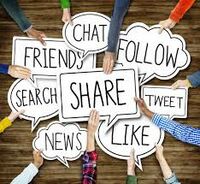
Social networking allows some individuals to express themselves much better than how they would in person. Not everyone is as outgoing and poses an extroverted personality. So for such cases, online social media can be a place where they can do whatever they want without caring who says what about them. The opinion of one anonymous user, “It is a lot harder to feel embarrassment over the internet than in person, so people find it easier to vent their feelings on sites like Facebook,” perfectly sums up the point that feelings of discomfort is not present in online interactions as compared to people meeting each other face to face[145]. One can go from posting about any part of their life, anything they are feeling that they felt trapped inside of them and couldn’t release due to peer pressure. Whether it be stress about an upcoming test or something severe such as depression or anxiety, social networking provides a segue for individuals to get that out without being ashamed. This also allows for those who share common interests and feelings to come together and build networks. Similar to the actual world, social networking enables individuals residing from far places to meet and interact with one another on the basis of a mere similarity.
Mental Health
Social networking sites can be used to benefit mental health. According to a study that was conducted, people who suffer from mental illnesses are inclined to join social media sites because they are interested in building more connection with others.[146] They do so because they are hoping to connect with another person who is suffering from the same mental illness. By developing that connection, their friendship can help aide one another in overcoming their mental illness. It is easier to look for help from someone who is going through the same situation as them. It makes them feel less lonely and makes them aware they aren’t the only ones suffering from that mental illness. Social networking sites ability to connect with others and to develop a sense of community are the reasons why it can be beneficial for those who need that kind of community and connection to battle their mental illness. Having the proper support system goes a long way in the journey of fighting and winning mental illness because it’s what keeps people motivated to continue fighting.
Social media brings the people closer
This is an amazing thing that social networking does to our society. Social media shortens the geographical distance between users as location of access becomes irrelevant as communication is accessed through the medium that is the internet. No matter how far you are from your friends, you are still able to keep in touch with your personal relationships and constantly update their information.It is not surprising when you find an old friend in social networking after years losing their contact. Even more terrific, we can find our family from social-networking. There are two sisters were able to find there long-lost brother after 60 years from social-networking. The sisters –Linda McCloskey and Betty Jean Musselman- they posted a picture on Facebook and it received 250000 shares in only three days. That amazing helps from other users give them back their brother. (Jose Alvarez, 2015)[147]
Social networking becomes the charity event’s best friend
Social networking helps create a volunteer networking. It is easier for users to find an activity that they are interested in as well as to help a non-profit event to find more volunteers.There are a lot of events that utilize Facebook as a communication channels to fundraise for their activities. This is a very effective way to spread out your events as well as to attract more helps in the network which helps improve the society.
Social networking platforms allows for easy promotions of charity and fundraising events. Many nonprofit charity events are advertised on social media because of its easy accessibility of distributing information in real-time to a vast amount of people. Due to this real time update it is imperative for these event coordinators to take advantage of it. Any last minute changes or cancellations will reach its followers immediately. The event coordinators can create a catchy hashtag to promote their charity events. Hashtags are useful because followers could click on it and see all the photos and/or tweets associated with the event. Incorporating social media to charity and fundraising events makes it entertaining for everyone because they're able to contribute whether it be posting a photo with the event hashtag or live tweeting about it.
Sharing Knowledge
Social networking helps engages “Passive learning”. This is when there is something pop-up in your newfeed on Facebook or Twitter that you don’t intended to search. The information that shared on social networking is enormous. When you use social networking, you put 1 foot in this enormous source of information, the other foot will be put in when you interested in this information which motivates you to read. A society in which people with higher knowledge and have a chance to access to different sources are way better than a society does not.
Social media has a great effect on education
Nowadays, everything can be online, so is education. There are many social networking sites with education platforms. Academic.edu – according to its web it is a platform for academic which is to share research papers. Mendelay – according to its pages www.mendelay.com , is page for students and researchers, which is “a free reference manager and academic social network” (Dorotea Szkolar, June 21, 2012)[148]. CUNY Black board is also a typical example which student can interact with professor and other students by discussion board (posting or comment)
In addition to allowing education to be taught over the web, the increase in technology has allowed for educators and institutes to establish a system where various social media platforms can be used to aid in the teachings. For example, we are increasingly beginning to see educators using social media applications such as Skype, Twitter, Blogs, to transition the students into their comfort zone. Students of this generation are quick to adapt to the changes of the digital age and it is definitely a positive to incorporate an application they are already familiar with. Teachers are using applications such as Skype to reach people all over the world to aid in the teaching process. It is allowing for a video chat from the educator to the class in a matter of seconds. Not only is this beneficial to the educator, but also for the guest. Time is being saved and physical appearance is not always needed with Skype.[149]
Also, When thinking about an online class we think about the convenience of it since we can participate in the class at our own time and in an environment where we feel the most comfortable. The benefit of using social networking sites for the purpose of education would be to also help those who are limited in their mobility and cant attend a physical in person class when they seek an education. Using Social networking sites for this purpose would help those with disability since they can feel as if they apart of a community that they can express themselves in without getting criticized since everyone online is seen as the same. As seen here "Bai (2003) indicates that social presence leads to reduced feelings of isolation and detachment while simultaneously encouraging student interaction and participation in online courses" when apart of an online community you feel like you can open up more, which is more than one can say when even in a in person classroom, and don't feel alone since your peers and teacher are their to encourage you and accept your ideas since it is a classroom environment.[14]
Raises Social Awareness
Social media, and social networking, has also emerged as a forum for raising awareness and bringing attention to the social issues that concern individuals in the present day. One such social issue is cyber-bullying or internet-bullying. Cyber-Bullying affects everyone including celebrities. Just recently, the Sister Sister actress, Tia Mowry, took to Instagram to share her point of view on cyberbullying, after someone made a remark on a photo that she shared on the network. She stated “Internet BULLYING is not cool and it needs to stop….Love and uplift… people that like to hide behind computers cyber bulling calling many gay, skinny, ugly, fat, the list goes on and on. Cyber bullying needs to stop!”[150] According to STOMP out Bullying program, many other celebrities have joined in the this program which focuses on reducing and preventing bullying and cyber bullying including stars such as Demi Lovato, Jon Bon Jovi, Katy Perry, Kobe Bryant even Billy Joel . [151] [152]
Facebook timelines and feeds are usually bombarded with countless request for medical support for an ailing child or adult or requesting support via sharing or ‘likes’. Take for example the ALS Ice Bucket Challenge. ALS which stands for amyotrophic lateral sclerosis. Social media helped increase awareness of this disease in 2014/2015. Thousands of individuals participated in the ALS Ice Bucket Challenge by pouring a bucket of ice water over their head in an effort to mimic some of the conditions that persons living with ALS suffer with daily. Many individuals could be seen participating in this channel including Mark Zuckerberg, Oprah Winfrey as well as Bill Gates. This sensation had individuals participating from all over the world. Celebrities from all over the world also participated which demonstrates how powerful social media is in raising awareness. Since the Ice Bucket Challenge was launched, the ALS Association raised 29.6 million dollars more than the previous year [153]
Global Perspective
Increased awareness of social issues all around the world, is another great advantage of social media networks. Social media makes it extremely easy to spread information through reposts on Facebook, Instagram and Twitter, for example. Users may become informed on news stories, through a friend’s repost, they may not have otherwise. Unless a person watches the news or reads up on the newspaper or online sites, they may be unaware of what is happening in the world around them, social media helps fill this void. There are many accounts that cater to spreading news stories, and as easy as a click of “follow” you are now able to receive these stories on your feed. This increased awareness is better for us as a society because we can reach each other more easily and find out information at the tip of our fingertips. [154].
Social networking provides a platform to voice opinions, share and bring people together. One should not underestimate the strength in unity a voice can induce when raised together. The Occupy Wall Street, the Arab spring and the recent protest in Hong Kong are examples of the power of Social media to bring people together. Hosni Mubarak had no clue of the political unrest that would follow and topple his government, after a fruit vendor’s self-immolation in protest of the corrupt judicial system was caught on camera and uploaded to YouTube. When he did try to disrupt the internet connection it was a little too late, the magnitude of the damage had grown too big to be contained. Social media did not cause the Arab spring but it did provide the fuel that kept the fire alive, smoldering the tyrants who ruled their county with an iron fist and helped the people win their democracy [155]. As aptly said by Wael Ghonim-an Egyptian activist, “If you want to liberate [a people], give them the internet”[156]. Social media also played a key role in bringing about some half a million Hong Kong people to the streets on 1st of July 2014 to protest a bill, proposed by the government that had the potential of restricting the freedom of speech had it been passed [157]. As humongous as the devastation which took away thousands of lives and rendered many homeless, when an earthquake of 7.8 magnitude struck Nepal recently, social media is giving an equally large platform for people to create awareness of the magnitude of the destruction and raise money to help the people displaced by the natural calamity.
Law Enforcement Perspective
Social networking has provided is helping law enforcement officials to solve cases more efficiently. Criminals sometimes would unknowingly post incriminating photos, videos and statuses to social networks, such as Facebook, believing that if they keep their privacy on private, law enforcement agents would not be able to access their information. What they do not know is that officials can access their private information through friends and family who either do not know how to properly utilize the privacy settings on their accounts, thus allowing access to their information, or just simply agree to let officers view the information. Thinking a profile is completely private is ludicrous because all privacy was gone once an individual shares anything with their friends. Another way law enforcement can access information is by creating a fake profile to befriend criminals, making private information accessible. Creating a fake profile is not illegal but it is against Facebook's policy [158]. All of these methods used to gain access to criminals’ privates’ pages are significantly helping to gather more data on cases and solve crimes.
Business Perspective
[159] Social media has helped a lot of businesses in terms of communication and understanding what customers want. The introduction of social media has made communication more efficient from a global perspective as well. The expansion of communication has effected “social transformations of cultures, countries, and societies.” Companies have begun to communicate with prospective customers through social media as well. They use platforms such as YouTube and Twitter to share their new products with their customers and to address any big changes. Social media is a cost-efficient way to communicate with customers and address their concerns, especially towards a negative product or service review. It is a good way to show that the company addresses their customer’s concerns and takes it into consideration, which not only the customer is aware of but other customers reading the response are aware of as well. This is essential in today’s society where we live in a world full of cameras and screenshots. It is important that customers acknowledge the effect companies put in to keep customers satisfied. Whether it is through having a customer hotline available at convenient times for customers, or responding to their concerns on various forms of social media, companies have to acknowledge that amidst is a lot of strong competitors it is essential to set themselves apart in the market by creating a customer relationship with them.
It is already clear that since social media became popular, it made people’s life easier allowing them to communicate with each other being in a far distance. However, it led to the beginning of a new era facilitating people and businesses to grow, most importantly to the economic and social development. Democratization of information: before we used to pay to get out information about our company or brand Substantiated claim. (Desjardins 2017). Today with the help of social media we are own media brand and less barriers to reach people. Today we do not have to pay to businesses to promote our businesses, we can create our own business accounts online on social media sites and develop it through media platforms. Consequently, it has allowed small brands to grow. Social media has become a platform to build a local brand in a cost effective way. Prior to smartphones and social networking sites, it was difficult and expensive to reach out people for local businesses. For example, if your business was not located on a main street. There are millions of such small brands and local business over the country and they make a decent amount of market share in the economy. Moreover, corporations and companies when they hire prospective employees, in order to get know closer them and learn about their personal and professional life, morals, the circle of their friends, they easily access to their social media profile like Facebook, LinkedIn or Twitter and check the future employee’s morale if it is a positive or negative. Employees’ morale can be described on social media sites by their pictures, posts, the circle of friends, shared videos or articles etc.
Political Perspective
Election Campaigns: Social networking becomes an ideal place to run campaign since its spreading speed is extremely fast and political issues become a very hot topic that people tend to pay more attention to. "This is our hub of communication," explained Ken Dawson, who heads digital strategies for Ben Carson's presidential campaign. "We really see it as the heart of our campaign." (Scott Detrow. October 25, 2015)[160] One of the typical examples is Donald Trump who has been appearing on Facebook’s newsfeed every day. A lot of people know about him through articles which are daily shared on Facebook. Disregard of how effective this campaign way is, he is well-known now thanks to social media. There is an article on CNN mentions about Donald Trump shares his debate question on Facebook which caught the attention of many Facebook-ers (Theodore Schleifer, Aug 3, 2014). Bernie Sanders is another politician that has had a successful campaign on social media. Bernie is running to get elected as the democratic nominee for the 2016 presidential elections. Sanders is popular on Instagram and has hundreds of accounts created by his fans and supporters to help spread his message. Sanders popularity has steadily been increasing as the months go by. Twitter following grew by 12.3% from April 4th to May 8th, and the numbers keep increasing.
People see more political point of views: Social networking sites such as Facebook or Twitter gives their users various points of views on the same political issue which are shared by their friends. On social media, one gets to have the chance to understand how other people deal with a problem, since everyone has different ways of handeling problems. Not only do you see more political topics talked about on social media but it reached a whole new demographic of people. Twitter was not invented for a political purpose, but now Obama, Trump, etc. use twitter and other social media techniques to get messages out to more people and in a different way. This past election made students who use these social media accounts more involved and feel included.
Social Networking brings people closer to political issues that used to be kept in secrets, especially, in many Democratic Countries: In many Democratic Republic countries such as China, Vietnam,etc, political issue is always the most sensitive topic that is usually kept as secret. It’s not surprising when most of Chinese citizens are not active on Facebook, Instagram, Snapchat or Twitter. Chinese actually have their own social networking site, called "QQ" which is popular among the Chinese Community. The government in China does not want Chinese citizens to have any interaction with foreign countries. The government also does not want foreign countries have any form of influence of the Chinese people. Therefore, government keeps their social networking under surveillance and only within the Chinese community, for managed purposes. On another hand, Vietnam – a Democratic Republic country that used to block their DNS access to Facebook, has now changed their rules. Vietnamese now have the opportunity to be active users on Facebook. As well as have access to different political sources from inside Vietnam and as well as outside of the country. Vietnamese people are now more open to talking about political issues, as well as speak out on their freedom.
There are also downsides to the instantaneous share in social media related to politics: There are also downsides to this availability of contact voters directly. The fact that politicians can post on social media instantly can cause a lot of damage as we can learn from Anthony Weiner, a politician that has sent inappropriate pictures and messages to women through Twitter and Facebook and as a result he lost his seat in the congress. The real challenge the use in social media brings with is that politicians can use it to manipulate public opinion and it is becoming almost a threat to democracy. It became easy to spread fake news and the reliability of the information on social media is decreasing.
The Negative Effects of Social Networks
Social networking is the use of certain websites and applications to interact with other users or to find people with similar interests as you. In today's technologically advanced world, it is rare to not find anyone not on social media. We all use it to connect with friends or families or co-workers. Jobs nowadays are also using social media to share ideas or to promote business. The internet has become a larger platform than ever, letting us do anything imaginable. Some of the benefits of social networking is instant access to information, staying connected, most are also free or very inexpensive, and are fun/easy to use. More and more celebrities will use it as a platform for their life and become more famous. Social networking is beneficial to everyone because of its ease of use and the freedom to connect for free. Like everything else, social networking also has its "dark side." The most important one would be the issue of privacy. If you do want to keep all your information safe and sound, then you would have to delete all of your social media account. "Facebook Privacy is So Confusing Even the Zuckerberg Family Isn't Private" by Rebecca Greenfield talks about a privacy issue of a picture. Mark Zuckerberg's sister shared a family photo on Facebook and the same picture was shared on Twitter and she was unaware of it. When she found out, she was angry because she thought it was only visible to her friends. She was unaware that her "friends of friends" can also see her pictures unless she changed it on her settings page on Facebook. It can also lead to cyber bullying and peer pressure, especially among teens. Social media is also one of the major distracting factors among us all. Every time we get a notification, we are tempted to be on our phone and go back to social media app. It is also a waste of time. "Social" media makes us less social because we interact so much online that we avoid actual face to face interactions. Now we face awkward social situations and immediately pull out our phone to avoid it. The article, "Antisocial Networking?" by Hilary Stout explains how teens who grew up with computers and cellphones are having a hard time reading social cues. "Even though young digital natives are very good with tech skills, they are weak with face-to-face human contact skills." This means although these teens are very good at communicating through texts and behind a computer, they can't do the same when it comes to face to face ones. Social networking will definitely evolve in the future, so much that we won't have to travel to see a certain place or to meet anyone. With all the advanced technologies that have yet to come in the future, I can definitely imagine it. Social medias will benefit and make more profits as more and more people use it for "free." Our information and data will be used more and more. I feel like we will lose even more privacy in the future as well. Social networking has made its indelible mark on the world, but it is definitely up to us to ensure that we use it properly to prevent its negative effects from harming us and younger social networking users as well. Unfortunately, with the rise of the internet connected smartphone and tablet, in-person meetings are becoming increasingly rare. In addition to the weaker social skills you mentioned, there is higher anxiety when communicating as well as lower levels of creativity and critical thinking skills when expressing thoughts to the real world. This lack of face-to-face communication may prevent children from properly having a dialogue with parents, family members, or friends when adverse events like cyber bullying are happening to them. Honest talks with children about their privacy rights, how to keep personal information to oneself, and through ignoring and blocking bullies that come their way are ways to do our part in making future social networking a safer place. Lastly, a periodic digital detox may be good for all of us. Even if it is only for a day or two, our minds will become clearer and more relaxed as we refrain from checking our devices constantly.
An alarmingly high percentage of people reported that social media has had a negative impact on them. In in depth interviews of people ages 28-73, 60% of people reported that social media impacted their self-esteem negatively, 50% reported that it has had a negative impact on their relationships, and 80% reported that is easier to be deceived through social media. Social media users should be cognizant of the effect it has on them.
Social media is also creating a paradox effect when it comes to dating. While it appears that there are more options now when it comes to dating, the reality is that there are less viable options. According to psychologist, Jennifer Rhodes, people that are obsessed with following their dates online, don't usually have effective communication skills. Additionally, couples are interacting less with each other in person. They view posting photos and texting as interaction, and therefore forget to talk in person. People also often think they know everything about a person after looking at their online profiles, so they don't end up talking to them much in person.
Social Media has also led to an experience known as Fear of Missing Out or FOMO. When people use social media for prolonged periods of time and receive likes or comments on their content, they start to feel compelled to constantly check their social media for updates. When we check our social media, we may get “rewarded” with an interesting post. We also get a reward from the external validation of our own posts. This is known as intermittent reinforcement and it causes people to want to keep checking their social media so that they don’t miss anything.
Disadvantages
Social Media not only facilitate people’s communication and life but also bring great impact on society and new social problems. The core problem is “overload”. The hidden worries brought by intelligent products in the era of big science and technology include health overload, information overload, and interpersonal overload. Just as social networking has its numerous, different advantages, there are also many disadvantages associated with social networking as well. As with most controversial subjects, there are many pros and cons to be weighed from different, individual perspectives to determine the overall impact. Several negative impacts, and disadvantages are listed below.
Reduce the quality of interpersonal communication. The overload of interpersonal relationships leads to the decline of intimacy among friends. The problem of attention disintegration brought about by information fragmentation reduces social-emotional communication to a certain extent and weakens the intensity of interpersonal interaction.
Potential physical and mental health hazards. It seems that message brushing on the mobile phone can never be finished. The mobile phone fills up people’s fragmented time, and also makes the whole time fragmented, affecting normal work and rest, especially sleep. Longtime bowing head to play mobile phone is easy to cause neck and shoulder muscle stiffness, spasm, and other signs.
Social media also has numerous and serious issues. Common problem is cyberbullying. Since anyone can create a fake account and do anything without being traced, it has become quite easy for anyone to bully on the Internet. Threats, intimidation messages and rumors can be sent to the masses to create discomfort and chaos in the society. Second problem is privacy and security. There are many news about personal information leaking from internet or other social media platform. Personal information can be hacked and easily shared on the internet. If the security of the platform is not strong enough, it will create a lot of problems to public users. The most important problem regarding social media is addiction. A lot of teenagers are addicted to social media. They spend most of their time on social media instead of spending time on doing other important things, such as education and health. If users are not aware and not wisely use social media, it will ruin their life. [164]
Social media is a powerful tool for spreading information to the public. However, it becomes problematic when people start spreading false information on the internet. We have seen politicians using fake news to increase their popularity, to get support from the people or to attack their opponents. This becomes a real problem since people can no longer trust what they see on the internet. Sadly, we are spending lots of time on social media every day and it wouldn't be a surprise that we would get deceived by the fake news and unable to see what's really happening in our society. Manipulating headlines of real stories on social media is another way politicians are using fake news to mislead voters. Although Facebook has disabled the ability for users to manipulate headlines of news stories on its platform since they discover this problem, it is not possible to eliminate all the fake news and stop people from doing it. [165]
Identity Theft
We have been selling our privacy for a while now: We sell our information to the grocery store in exchange for discounts. Similarly, we sell our privacy to the airlines so that we can get upgrades and better customer service. We also sell our privacy to online pharmacies so that we can get our prescriptions refilled without any hassle and so on and so forth [166]. When PwC (Price Waterhouse Cooper) surveyed roughly 1000 US adults about privacy, they found that 72 percent of Americans age 18 to 29 were willing to share their personal information for discounted movie tickets and roughly half of all those surveyed said that they would hand over their personal information in exchange for other goodies such as services that would help them find the nearest popular restaurant or performance [167]. The ease with which we part with our information is not without consequences. Identity thefts affects million of million ever year, a recent study has revealed, costing victims time, money and peace of mind to recover [168]. Target got a taste of this unpleasant experience, when hackers got into their system and stole the identities of their consumers, wreaking havoc and caused the company to lose face. There are more opportunities than ever to steal identities as global use of social media increases. According to a BBC report, the number of victims of identity theft rose by 57% during 2015. Such thing was possible due to the personal information that can be found on social networking sites. Twitter and LinkedIn have become a "hunting ground" for identity thieves. An innocent post such as “going away for the weekend” in Facebook or twitter or other social networking websites can make you vulnerable to burglary. As an Indiana woman by the name of Keri Mc Mullen found the hard way when she made a simple post that she was going to watch a band with her fiancée. When she got back home, to her utter shock, her house had been burglarized and valuables worth $11,000 had been stolen. Fortunately the perpetrators were caught on camera she had installed in her house and sweet justice was served. Stalkers can take advantage of photo- and video-sharing sites like Flickr and YouTube to get a sense of you, your family, your friends and the house that you live in. That being said, one should always remember that no matter how your privacy settings are tuned, the things that we post in social networking sites have the biggest potential of being exploited. We are all aware of the dos and don’ts when it comes to giving out sensitive information such as our social security number. Regardless some social networking websites still ask you for such similar information that could be used to your disadvantage
Crime of Opportunity
The uses of social networks are leaving oneself open to crimes of opportunity. Transparency is beneficial to a certain extent but becomes dangerous when too much privacy and personal information is revealed. It is common for people to exchange personal information for certain benefits when they are provided with only two choices: get the benefit with a few clicks or get no benefit at all. Adolescents and adults compromise their privacy when signing up for any site and that requests any private information. People, especially young adults, do not think to hesitate when it comes to updating statues about their location. What they do not realize is criminals can use those status updates for crime. If a person posts on twitter, and their account is not private, a criminal can see everything they post. By posting information such as vacation whereabouts or even posting local location updates makes people vulnerable to burglary, assault, stalking and cyberstalking [169]. Cyberstalking is defined as harassment to a point where the victim feels threatened. Cyberstalking can be avoided because a cyber-stalker relies on the victim’s use of privacy settings and the Internet’s anonymity to stalk their victims. All of these crimes can simply be avoided if users correctly utilize privacy settings and only friend people they know.
Dangers also occur from new types of sites that emerged such as dating sites. People on these social media dating platforms, usually look for somebody they can connect and bond with. More often than not, these people are also complete strangers. Along with meeting these people online, the physical meetings that occur often possess inevitable risks. There have also been cases where victims have been drugged and/or raped by the person they met. While it is nearly impossible to eliminate these risks, this problem was created by the start of dating sites. These sites have created an online alternative for meeting people rather than the traditional way. Although there are many preventative measures, people should still be wary of those they meet online.
Impact of social networking to teenager – the most popular victims of social media. According to Figure (Pew Research Center,2014), we can see the dominant age group on social media are from 18-29 all the time. If we are not careful, young girls, teenager or woman can fall prey to online attacks which can create more bad consequences. (Jenny Q.Ta, 2014).Teen girls are the target of sexual predator. “The personal information revealed by teenagers on these sites also attracts sexual predators. There have been a number of reports of sexual predators locating victims through social networking sites” (Susan B Barnes,2006, [170]
Cyber-Bullying
Cyber bullying is defined as the deliberate use of digital media to communicate false, embarrassing, or hostile information about another person according to O'Keeffe and Clarke-Pearson (2011). Cyber bullying has become a huge problem as a result of the birth of social media platforms as many deaths have occurred due to cyber bullying in past years. Bullying and harassment are evidence that our society still has a long way to go. Cyberbullying occurs in many forms such as spreading rumors, making mean comments, posting unflattering pictures on social media platforms and other sites as well. Social media does not make it any easier nor does it protect the people who are most susceptible to the negative effects of social media bullying.
Since the rise of social media the most popular of the sites have been a breading ground for this form of bullying. Individuals cannot even feel safe and secure in their own home knowing that someone is tormenting them online, which is suppose to be a platform for encouragement and spread of positive ideas that can be built up upon by others and create relationships through that small connection/bond that started through and idea bringing about similar interests. There are many social networking sites that bullies go to one being Facebook which is likely the most popular social networking site, but statistics show in an article by NY Daily News that another site is the breeding ground for these cruel and mean acts "42% saying they were bullied on Instagram. Facebook wasn’t far behind, at 37%, Snapchat was next at 31%. Twitter (9%) and Tumblr (3%) were at the bottom." Instagram has been growing in popularity no wonder something as evil as cyberbullying would take place here and the most nonetheless. This type of behavior should never happen if someone would like it being done to them they should never think about doing it to someone else because you never know the outcome of what bullying can do to an individual. [15]
What was just a school affair is now reachable to a wider audience owing to the elevated platform that social networking provides. A majority of bullying takes place in Facebook because of its popularity and its open platform. As a matter of fact, Washington Post reports that an astounding nine out of ten teen Facebook users have reported witnessing bullying. Fifty four percent of the people surveyed by Ditch the Label also reported experiencing bullying in the same website [171]. Other social networking sites are also not far behind. When you are behind the computer, commenting on the ugly scar that your classmate has on her neck or making fun of the overweight girl that has a crush on you, you are unaware of the implications that your unkind words can have on them as you are not able to see firsthand, the hurt and the agony that the person is experiencing. Hence you are not able to sympathize and put a stop to your rude comments. Social media gives us the power to say things that we would normally not say in person. I bet none of us would ridicule a fat person in his face because chances are that you would either be punched or the people around you would make you feel like a scumbag for stooping so low. Either way, you know better not to put yourself in such a situation.
Social media is constant in our lives and will continue to be a prevalent role in society, especially teenagers. I have witnessed too many times, as a waitress, family meals become a silent affair as the kids browse through their smartphone every single minute of their time at the table. The human aspect of interaction between individuals is changing continuously and will need to be analyzed cautiously. The need to be constantly connected in social media is a major issue as it creates a platform for constant bullying. Before the advent of social media, bullying was more or less confined to school. You could always come home to your mother's freshly baked apple pie and instantly feel better. But now with the pervasiveness of social media, the poor victim has no place to get away from being an object of ridicule as the constant bullying is always staring right at your face. Furthermore the reach is not just confined to school and your class, the taunting is on a much larger scale with other kids joining in to make fun of you. Social media has made it easier for groups of people to join in on bullying and single out a person just because the rest of the crowd is doing it.
Teenagers are not emotionally equipped to handle severe bullying done on a large scale. Consequently they take extreme steps to put an end to it. I am sure most of us are familiar with the tragedy that befell the Clementi family, when their son Tyler Clementi from Rutgers University put an end to his life by jumping from George Washington bridge because he could no longer tolerate the harassment and ridicule he was put through, when a video of him kissing his boyfriend, caught in the webcam was uploaded and circulated among his friends by his room-mate. Unfortunately this is not a lone case. There have been many instances where social media has played a key role in magnifying the humiliation and harassment to the point where the helpless victim could only put a stop to it by taking away his or her life. Teen suicide spearheaded by cyber bullying, definitely make us take notice of the damaging far reach that social media contributes to, but it is not the most common issue. Most teens, who experience some kind of bullying in their life tend to suffer from low self esteem that can last throughout their lifetime. Depression, social anxiety, eating disorders, and many other problems may result because of cyberbullying. The victim is withdrawn and loses interest in activities that he or she used to enjoy. Some of them even tend to inflict cuts on their own body [172]. Cyber bullying must be stopped so that our children can grow up to be strong productive individuals who contributes to society in a positive way.Cyberbullying, and it’s gotten so bad, there’s even a campaign to stop it(www.stopbullying.gov).
Cyberbullying is pretty much bullying, but happens on the social network, text messages, or emails. It could be a rumor about someone that’s posted online, a picture, a video, or even a rude and distaste message about a person, cyberbullying is horrible, especially among young teenagers. I’ve read so many stories and articles about kids who were bullied and ended up taking their own life because they couldn’t deal with the bullying anymore. One was a shy 18-year old, Tyler Clementi, mentioned earlier in this, who attended Rutgers University. He committed suicide after finding out that a sexual encounter he had was video streamed by fellow peers on social media. In a Live Science article, “Bullying linked to suicidal behavior in adolescents” by Agata Boxe, a study from the Netherlands showed that children and teens who were cyberbullied was “strongly correlated with suicidal thoughts than traditional (in- person) bullying. https://cyberbullying.org/wp-content/uploads/2016/10/cyberbullying-gender2a.jpg
Addiction
In addition, some people are just addicted to these social networks. They can spend hours and hours online. According to the ResearchPedia, “Excessive time spent on social networks causes some individuals to experience withdrawal symptoms.” [173] As any other addiction, social media can make you feel lonely as well as suffer of distress. “The lack of social interaction could result in people suffering from more stress-related diseases and disorders than before,” the article added. PBS decided to create a documentary titled, Generation Like, to talk about the addiction of social media in teenagers. [174]. However, some of the worst drawbacks of social networks are the lack of privacy, identity thief, and companies spying on their current and new employees.
Speaking of the professional work environment, the addiction to the use of social media has affected many employees’ performances as well. In a recent study, apparently, as it seems that 29 percent of the use of the internet is to fulfill the purposes of social networking and out of those people, 89 percent claimed that they have committed this practice at work to waste time[175]. In other words, when they waste time, they are being utterly unproductive and not doing what they are supposed to be doing. In turn, this costs the company they are working for and would result in outcomes that are at the very least not ideal.
In general, once you have access to these social media sites through your devices it becomes a habit of checking it constantly. People love to open their apps and stay up to date and don't realize that the more they use it the more addicted they become. So much of it eventually affects other aspects of regular daily activities. Using social media in excess is actually constantly checking your account, stalking people's profiles, and making that something you have to do daily.
Mental Health
]] Mental health issues arising from social media use has also been a growing concern. According to Stein (2014), studies “found that seventy percent of teenagers age twelve to seventeen spend time on a social media site in a typical day.” Further studies show that increased use of social media amplifies the likelihood of using drugs, drinking alcohol, and smoking cigarettes because they are constantly exposed to people under these influences. Young teenagers often go through a phase where they want to find themselves or fit in with people in society so when exposed to pictures of people under the influence, it causes them to feel the need or want to try the same thing.
Research from the American Academy of Pediatrics suggests a new phenomenon called “Facebook Depression” which they define as depression that develops when preteens and teens spend a great deal of time on social media sites, such as Facebook, and then begin to exhibit classic symptoms of depression. [176].
The overuse of social networking sites can cause individuals to have the inability to have in person conversation. As social networking sites are becoming more prevalent into the lives of many individuals, they're forgetting the skills to have conversation with one another in person. Instead of talking with family and friends, people usually will now respond through social networking sites or text messages. This can cause some serious personality and brain disorders. In an article by Huffington Post it shows that kids tend to use their phones as a form of avoidance so they don't have to interact and solve the issue as seen here "The high school kids who I do see will be checking their phones constantly. They’ll use it as an avoidance strategy." This is a problem since kids will not be able to solve conflicts that they face, get through an interview, make new friends, and network to gain connections in the real world if they can't break out of this shell.[16] . This can cause major mental issues by not being being able to open up about issues going on and resulting in this lack of expression to worsen what one is going through.
From a paper that was published recently on JAMA Psychiatry, we can learn that using social media for more than 30 minutes a day can relate to an increase in mental health risks for teenagers. Furthermore, it says that teenagers that are using social media for 3 hours a day or more have a 60% higher risk to develop mental health problems. Teenagers who use social media for over 6 hours a day increase their chances by 78%. On another study that has taken place recently, out of 1125 students, 30.7% were reported using social media between 30 minutes and 3 hours a day and 12.3% were reported using social media between 3 and 6 hours a day. This extensive use of social media of 3 hours or more a day is associated with a certain behavior called internalizing. This behavior is like a negative internal dialogue that can cause a person to withdraw emotionally and it is often linked to anxiety, loneliness, and depression. In addition, the fact that social media is based on an illusion runs on likes, shares, retweets, and filters, enables it to have some damaging effects on our mental health and especially on teenagers who are insecure and very confused as it is.
Self-Esteem
One of the advantages of social media networks discussed above was the power the positive image you project of yourself can have as a confidence booster. However, seeing so many positive images of others, causes the opposite to happen to you. Viewing the perfect images of women, people’s vacations, accomplishments, and the like can make you feel as if your life isn’t as good as theirs or as if life isn’t fair. If one bases their self-esteem on the validation they receive on social media, they are at risk of being impacted by negative feedback [177]. This can lead to “ineffective dieting…eating disorders and body dysmorphic disorder” [177]. Also, People who have been users of Facebook longer felt, more, that other users were happier, and less, that life is fair [178]. Those who spent more time using the social media site during the week felt, more, that other users were happier and had better lives [178]. You get more explicit and implicit cues of people being happy, rich, and successful from a photo than from a status update. A photo can very powerfully provoke immediate social comparison, and that can trigger feelings of inferiority. You don’t envy a news story [179]. A study done at the University of Michigan found that people who use Facebook often feel worse about their life and less satisfaction. Despite the feeling of less satisfaction in their life, people continue to use social media platforms as an outlet for their feelings and thoughts to be conveyed and listened to. Social media platforms have become the intermediary where people disclose information about them and receive immediate feedback about it. This acts similarly to a reward and causes the feeling of addiction to social media. The reliance on social media platforms has become a tool for people to base their self-esteem and self-worth. Self-esteem and self-worth derived from social media has been shown to lead to “anxiety, depression, and other psychiatric issues” when faced with reality according to Stein (2014).
Recent studies have shown that Facebook has the ability to cause negative effects on one's self-esteem by triggering feelings of envy, with vacation and holiday photos proving to be the largest resentment triggers based off these studies. Other prevalent causes of envy include posts by friends about family happiness and images of physical beauty—such envious feelings leave people lonely and dissatisfied with their own lives. A joint study by two German universities discovered that one out of three people were more dissatisfied with their lives after visiting Facebook, and another study by Utah Valley University found that college students felt worse about their own lives following an increase in the amount of time spent on Facebook. As social media usage increases, there is a growing number of people who are developing self-esteem issues. People with low self-esteems tend to post a lot more on social media presenting themselves in a different light to appear as someone they are not. Addiction to social media can lead to and is associated with low self-esteem and can also cause identity issues. Depending on social media to satisfy self-esteem issues is not healthy and needs proper addressing. However, these counts act as mean of measuring popularity for many teens. In many social groups low number of followers translates into not being ‘popular.’ For developing teens having the pressure to keep up an online image can be very negative for their mental health. Not having a lot of likes on a picture or having fewer followers than a friend can have negative effects on self-esteem. Wanting to increase follower counts fuels social media addiction. Users are constantly trying to boost their counts by checking their apps and following strangers. Sometimes even buying fake followers who they know nothing about.[Weller, Katrin. "Trying to Understand Social Media Users and Usage."]
Social Networking also impairs one’s ability to think independently. It does this by seeing what everyone else is doing and making one not want to feel neglected. All the people you see online have a major impact on decision-making. It is hard to have your own opinion when you have so many friends on these social networking websites and most them are all posting about the same opinion. An example of this is when people are all posting about the presidential election and a lot of people you are friends with on Facebook have the same opinion. They are all saying how bad president Trump is and how great was president Obama, so you are only reading these and not doing your own research about the topic. Therefore, you think they are correct. Another reason why it is hard to think independently is because people may be afraid of what others will say. If most of your friends online all like president Obama, it is hard to write about not liking him due to fear of fight. Once this conflict breaks out you will be criticized for your own opinion and naturally this decreases your self-confidence, making you not want to say any of your own opinions in fear of being made fun of.
Other disadvantages include [180]:
- Face to Face connections are endangered
Experts fear that future generations aren't properly developing the skill of being able to communicate with one another face to face which might hurt them when it comes to things such as finding work.
- Time waster
- Decrease in attention spans
- Users are sleeping less
The influence of the use in social media on sleeping habits
In recent years there is an increase in the occurrence of sleeping problems like insomnia among people and one of the main reasons for it is the use of social media. Both overall times spent on social media, as well as frequency, have been tied to sleep problems. The recommended amount of sleep per night for adults is 7 to 7.5 hours. According to the CDC (The Centers for Disease Control and Prevention), in 1940 the average American had 7.9 hours of sleep. Today, most Americans get only 6.8 hours of sleep per night. Researches have been claimed that there is a relationship of correlation, and not causation, between the usage in social media to sleeping problems, because it is hard to say with 100% certainty that it is the cause for people’s sleeping problems. Social media is already tied to stress and depression, and those themselves could cause one to have sleeping problems, like insomnia. Social media is also interrupting the physical aspect of our sleep. The blue light from our electronic devices interferes with the body’s natural processes of sleep. Furthermore, according to a study that examined 1000 teenage students in Singapore, the use of social media not only affects the quality of our sleep, it also affects our functioning the next day. The use in social media was to increase the levels of impaired functioning of the students and their level of daytime sleepiness. [181]
Slacktivism
Slacktivism refers to the negative effect that social media has had on social causes. While it is a great way to share and increase awareness of social causes, charities, or petitions online, there is something that many people don't realize. People sharing support to these causes by sharing or liking on social networks doesn't actually do anything for the cause other than spread awareness, and does not effectively result in people actually donating or signing for a particular cause. Research regarding this topic has created the term “slacktivism” which is when social media gives people options to absolve them from responsibility to act in social causes. [182]
Facebook Depression
Facebook depression is a term that originates from a report by the American Academy of Pediatrics (AAP) and refers to the symptoms of depression that arises with the constant use of social networking sites such as Facebook. This type of depression tends to be found more commonly in teenagers due to the fact that younger individuals are more likely to be affected, and influenced, by the opinions of others. According to Ethan Kross, the director of the Emotion & Self Control Lab at the University of Michigan, research findings indicate that there is a correlation between the use of Facebook and "feeling lousy". That research also found that depression is three times more common among the most active users of Facebook, Twitter, and Reddit.
This type of depression is more common within adolescents because of how invested these young minds tend to be within the world of social media. What they lack in knowing is that not everything that they is posted, is the whole story. Many kids believe that others are living a better life due to peers posting pictures of a happy life, leaving others to feel upset towards the life they live. They think what ever they see online os what their life should be like, and if not, they are doing something wrong when in reality social media is just a platform for people to pick and choose what part of their life they want to share.
In a Lancaster University review, it has been shown that social networking is heavily associated with depression due to the practice of "comparing" and "overthinking".[183] Lancaster University reviewed studies from 14 countries, which included 35,000 participants of varying ages, and concluded that individuals, mainly Facebook users, were more at risk of being affected with depression if they perceived feelings of envy when watching others, included former partners in their online social networking activities, made negative social comparisons between themselves with other users, and constantly created negative posts, or updates.[184]
Spread of False Information
The dissemination of false information, also called "fake news" in recent years, is one of many concerning, negative effects that has become intertwined with the constant use of social networking technologies within society. Many individuals rely on their social networking platforms in order to keep up on current events and present-day news. For example, many users check their Facebook news feed and Twitter feed on a daily basis and such platforms where they have the ability to read up on the articles that are shared by others within their social networks. It is argued that the incredible accessibility of social networking websites is also one of its biggest flaws. Many misleading news articles are written with "hyperbole and inflammatory headlines", sometimes with completely false information, and users on social networking platforms pass on, and spread, these misleading articles at an alarming rate without being able differentiate between such "fake news" from reliable, credible sources[185]. News is an important resource that is necessary in maintaining a well-informed, knowledgeable population, and many argue that social networking works against such ideals as users grow to become reliant on such technologies.
The problem of fake news is becoming an increasingly worrisome and potentially dangerous situation when it comes to the role media typically plays in shaping society. Through media coverage we are able to stay on top of everything that happens across the world and are provided this information at the touch of our fingertips. However, regardless of whether or not we feel like we're very good at spotting fake news, it may be more difficult to find than you think. A survey done on a group of individuals showed that our perception of where credible information comes from may be playing a huge role in whether or not we're reading and being exposed to fake news [17].
There are a lot of websites that offer fake news, so many people may share and report false information through social media that affect these companies; customers’ reports on social networking can include comments on their reputation. It takes only a minute or two for people to receive fake information via social media. As such, the transmission of social media is so fast that people are bound to believe even false information. Companies need to be more careful about social media exposure to prevent this problem.
In Social networks we see false information all the time. For example, a couple weeks ago, I saw on Facebook that a famous boxer from Dominican Republic died in a car accident. It was a whole article about how and where he died. A couple of days later I saw on Facebook again, that the boxer was not actually dead and that he went to different mass media to disprove the information and to say that everything was a lie. Here we can see how disinformation can be easily spread out through social networks.
People can also create fake accounts under your name and start posting inappropriate comments or picture on the website. Hacking social accounts has become very common nowadays. People hack others people accounts to find information or sometimes just for fun. Famous people are usually the main target of these incidents. Hackers can take your picture from your profile and make people believe you are the one posting all that.
How to protect your account
In regard to privacy, social media users can set their personal information settings appropriately on these platforms to avoid the misuse of their information. It is recommended to make personal social media accounts private rather than public. Users can reconsider whether it is okay to upload photos, videos, and articles on social media before posting as well since people can attack and criticize social media posts when they see them. Also, users can be cautious when accepting new friends online to avoid unnecessary cyber bullying, text messages and stalkers. Social media users can also deal with their security by changing their passwords for websites and social media accounts often if they feel threatened. It is also helpful for users to create and use separate work accounts and personal accounts.
Social networking rumor kills more people than we thought
Pressure from social networking (unreal world), in fact, has a negative impact to our lives. It is not a joke when there are many deaths cause by social media such as “ Man kills his friend for “Poking” his girlfriend” or “Being grounded from MySpace Drives Teen to Shoot his Dad” from The 14 Craziest Deaths caused by Social Media (Whitney Milam, Ranker.com)[186] According to "This Week in Asia" journal's article WhatsApp rumours have led to 30 deaths in India. Anger at a terrorist attack in Kashmir has opened the floodgates of disinformation, which civil society groups are now working to combat[187]
Privacy Concerns
People tend to become more open in social networking. A lot of people have a habit to share their information on social networking. They share their friends, their location, what they have, where they have been,… From Facebook accounts, we can figure out a lot of information about that person. It will be safe when you share your information with your friends or the person that you know well; however, you never know who is tracking you. That would be a great threat for you when your public too much personal information on social networking. According to a report about trust and privacy concern within social networking sites “100% of the Facebook members reveal their real name in their profile, compared to 66.7% of MySpace members. 94% of Facebook members include their email address, compared to about 40% of MySpace members.” (Catherine Dwyer. Starr Roxanne Hiltz. Katia Passini, 2007)[188].The main reason of losing privacy because people lose awareness of privacy losing. They sometimes trust social networking sites without any concern. The rapidly increasing of information and data generation requires a business to generate more customer information. This is also one of the reasons that turn social networking into a dangerous place with a huge threat of losing information.
Many social network sites are distributing users’ personal information to the third parties for advertisement purposes. There were some privacy setting issue complaints about Facebook’s privacy settings Facebook has undergone many changes to its privacy policy since 2006, many of which resulting in less user control over who gets access to their personal information. EPIC filed two complaints with the Federal Trade Commission (FTC) focusing on Facebook's unfair and deceptive trade practice of sharing of user information with the public and with third-party application developers. The first complaint, In re Facebook (December 17, 2009) and Supplemental Complaint (January 14, 2010), focuses on Facebook's unfair and deceptive trade practice of sharing of user information with the public and with third-party application developers.” This complaint illustrates that Facebook’s privacy setting to make their previously protected information available to the public was unfair. In this way, they are deceiving users by not clearly informing them about the use of cookies that Facebook uses to track users’ activity.
A person’s digital footprint is the collected record of evidence of sites they have visited according to O'Keeffe and Clarke-Pearson (2011)[189]. With every move we make in social media being monitored, people’s right to privacy has been severely compromised, as Mark Zuckerberg's (founder of Facebook) sister learned the hard way. A family picture she had shared with her close friends in Facebook went viral after an acquaintance of her close friend posted the candid picture in her newsfeed [190]. Privacy is a small price to pay when one makes a conscious decision to be a part of social media. With so much sharing of information in social media, we now know that if Betty was an animal, she would be a dog, and the celebrity she is in love with is Brad Pitt. We also know that Sharon’s youngest kid is autistic and that John lives and dies for his cats and that Susan is saddened by the plight of people and children suffering in war-torn Syria. All of this promiscuous sharing of information may give us a sense of community but it costs us our privacy. The picture of your bikini-clad body, rubbing against the lifeguard may be appropriate on the beach of St Thomas but it may undermine your respect as the head of the Communication Department. The same may be true for other “girls just wanna have fun” pictures of you downing tequila shots. You may be a hard-working, diligent individual but your pictures in social media may portray you as a fun loving person who likes to hang out with friends in bars and clubs. After all who doesn’t want the world to see us as a person who is enjoying one’s life and living it to the fullest. But without you being aware, you are being profiled as a party animal who may not take her work seriously. Consequently, you may not get the job despite being the best fit for it. As social media websites notch up their game to make the dissemination of information easier, both the FTC and states legislatures are trying to protect the American Public from specific aspects of privacy intrusions that are brought up through such dissemination. “12 states currently have laws specifically restricting employers from demanding access to their employees’ social media sites when the sites are fully not public. These states that have passed the law are Arkansas, California, Colorado, Illinois, Maryland, Michigan, New Jersey, New Mexico, Nevada, Oregon, Utah, and Washington” [191]. Other legislatures are also considering following suit, amidst the growing concern of loss of privacy ensuing from the blatant misuse of one’s information on social networking websites.
In the modern era, the invasion of privacy has resulted from virtual territory privacy, factual privacy, interactional privacy, and psychology privacy.
Virtual Territory Privacy
The multiple chapters in this book focus on the privacy of social media and its effects on its users. The book clarifies how various posting information about oneself on Facebook has become global due to the availability of modernized technology. The author explains how multiple activities like communication, sharing of location may be harmful to individuals. Thus, this book will help us to develop the activities that invade our privacy on the internet. In a virtual social context, people feel ownership of the digital sites that belong to them, or they have created by themselves, for instance, the weblogs, personal spaces, and profile pages. Therefore, the digital contents available in these sites represents own virtual presence and are made up of personal information. Thus, virtual presences are defined as the natural extension of individual virtual existence in the social platform.
An internet personality is created and displayed on shared media outlets such as Facebook photos and status updates. Face to face introduction is similar to the digital body on the internet although the users do not physically interact. The digital technology allows people to view other people's photos and know about their daily activities through social status updates. Most people who have digital devices such as mobile phones have access to the internet but some are not aware of its significance. Most people like knowing how others are doing in their life and this makes them stalk other people on social media where most people post about their lives.
Factual privacy
Social media podiums such as Facebook allows users to post and share pictures, date of birth, name, location and many other things that reveal personal information. By doing this, it allows another person to access the information posted and shared. The intention of sharing information is to connect with online friends but some people use the shared information in a negative way where some people even lead to cyberbullying. Many people do not question whether the information they share will be misused. Personal information can be misused when the information is leaked to other users without the conscience of the user. This has a significant impact on user privacy. Some users neglect to read the privacy policy about how to secure their information and this results in misuse of the user's information. [192].
Interactional privacy
Interactional protection is necessary for the setting of informal online organizations where present day advancements remove the fleeting and spatial constraints of (physical) communications. Electronic communication (e.g. text frameworks and messages) enriches the channel through which one can become to by potential contacts. The side-effect of upgraded openness is the loss of controllability of correspondence. With electronic devices, individuals are available as long as they are on the web, which enormously increments the events of undesirable transformations. Interactional security is along these lines an essential part of protection in the virtual condition. In the past decades, people could not broadcast themselves unlike today where anyone can broadcast himself or herself in the media and the chance for individuals to present themselves, their videos and ideas have dramatically grown. Nowadays, internet users write blogs that are public and also publish private photos and videos on social media platforms such as Facebook. “Web 2.0 applications are interactive internet sites with millions of users”. Websites such as Myspace which are online presentations and Facebook which is mostly used by the student community have become very popular. When presenting themselves on social media by means of social networking sites and web communities, the users display their profile with personal information which consists of one or more pictures. In order to maintain a good relationship with others, people are advised to add other people to their personal contact list. This will enable the user to find people with similar interests and this will present attractive descriptions about them. According to Goffman (1959) to Social media users have more control over how they represent their selves on the media compared to face to face communication. [193].
Psychology privacy
Individuals highly expose their personal experiences on social media. Therefore, the hyper-connectivity enabled by online social networking presents much of the individual content to other people. Consequently, it becomes straightforward for online users to monitor one's life. The remarkable growth of social networking has fueled online political participation among US citizens. Many of the US grownups use the internet to get involved in the political process. Social networking sites (SNS) users on in the past used social media to receive the news on politics (Duggan &Smith, 2014). The social media has been turned to a fundraising site by the political leaders. They also use social media in doing their campaigns. Wired party-political involvement is prejudiced by political self-effectiveness and general public trust. Since the discovery of Facebook, there is growing research on social network use and political involvement. This attempts to know whether the overall use of social networks could lead to young people's internet participation and offline party-political involvement and public commitment. Those users of the internet that have radical interest share their party-political views on SNS with friends and also follow their political opponents on Twitter.
NSA and Breach of Privacy
Facebook and the NSA(National Security Agency) have had a long history with each other. Edward Snowden, an ex-employee of the NSA was convicted of espionage after releasing confidential information regarding spy and hacking programs that lurk in our cyber-world.The NSA labeled this act simply as "national security protocol". Ever since this was made to the public, Facebook has come under fire by the general public. Facebook is the largest social network in the world and its users are not okay with the government exploiting their personal and private lives. Mark Zuckerberg has attempted several times to address this issue. He has even personally called President Barack Obama, but it was simply brushed aside.[194]
It has been mentioned several times within the last couple of years that public audits made on the NSA has revealed that they have violated laws thousands of times. Facebook is merely collateral damage that is done as much of breach in privacy usually occurs in e-mails and phone calls. The NSA has openly admitted their faults on several occasions, but little to no actions seem to have been taken for preventative measures. The public wants more transparency and that is something the NSA cannot offer.[195] This gray area topic is still in discussions, but it doesn't seem that there will be any big reforms in the coming years as President Obama has already announced that the NSA's mass spying program will not be part of his reform program. Obama has argued in the face of independent studies that NSA spying has actually prevented multiple threats and attacks that have saved thousands of lives not only in the United States, but also on a global level.

Not only is this breach of privacy done with malicious content but also is an infamous practice common in large corporations marketing departments that tend to observe their target market to find out their interests and the products that would lure them. According to the study conducted by Hoang and Pishva, graduate students researching in the field of Information Communication and Technology, communicating online non-anonymously can really be harmful to the users as it allows hackers and other organizations that are illegally monitoring people’s personal information to exploit that and use it to their own benefit[197]. If put in simple words, if one doesn’t hide their identity online, people can steal it and use it against them. However, on a less harmful level, many data collecting agencies monitor people’s personal data and then sell it off to large companies. In turn, these companies use the data to advertise and sell their products to these specific individuals which would appear superficially as though the companies are catering to their needs but in reality are simply trying to make money[198].
Cambridge Analytica Facebook Scandal
In March of 2018, the New York Times and the Observer reported that Cambridge Analytica, a political data firm that assisted the Trump administration during its 2016 political campaign, improperly obtained private Facebook data of close to 87 million people. [199] The firm used the data to build psychological profiles in an attempt to influence voters. The data was also used to send targeted political ads, aimed to sway voters with the use of those profiles. It was later discovered that in addition to Trump, Ted Cruz also used the information provided by Cambridge Analytica in his own 2015/2016 presidential campaign. [200] After news articles on the matter were released, Facebook came under fire from lawmakers who demanded that Mark Zuckerberg, the company's CEO, testify before Congress. [201]
This scandal raised questions of whether social media companies are transparent enough in how user data is used and led to an investigation by the Federal Trade Commission (FTC). It also resulted in the hashtag "#deletefacebook" circulating trending on Twitter and a number of prominent companies and individuals deleting their Facebook profiles. Facebook's stock and the stock of most companies in the tech sector sold off following the New York Times and Observer reports. [202]
Starting on April 10, Mark Zuckerberg faced two days of questioning from Congress, regarding Facebook's privacy policy and how the company allowed the data of almost 87 million users to be accessed by Cambridge Analytica. The questions focused on topics such as why Facebook did not notify the FTC of the data leak, Facebook's role in Russia meddling in the 2016 U.S. presidential election, and future regulation of Facebook's business. [203]
By July, 2019, after the FTC concluded it's investigations, Facebook has been fined $5 billion by the commission. Despite the negative public attention, critics of Facebook claim that the company still has not enacted meaningful change to address the issues raised by the scandal. [204]
Facebook's Mood Experiment
In a behavioral experiment conducted for one week in 2012, Facebook changed the content in News Feeds of almost 690,000 users.[205] Some users were shown a higher number of positive posts, while others were shown more negative posts. The results of the experiment, conducted by researchers from Cornell, the University of California, San Francisco and Facebook, were published this month in an academic journal Proceedings of the National Academy of Science.[206] The study found that users who were shown more negative posts were more likely to produce negative post and the users who were shown more positive posts, tended to be more positive in their posts as well. [207]
This behavioral study outraged many people when the findings of the experiment were released on the news. The Electronic Privacy Information Center (EPIC,) which advocates for digital privacy, filed a formal complaint with the Federal Trade Commission over the 2012 Facebook mood manipulation study. EPIC claims Facebook violated laws when it conducted this experiment because Facebook users did not know they were being studied, not gave permission to participate in the experiment. However, when you sign up for Facebook, the term of service that you agree to when creating a profile, gives the company permission to conduct this kind of research. .[208]
Others seem to think that this experiment opened up a brand new way to study behavior. Behaviors can be so closely monitored on these Social Networking sites, and it may give insight to why people do the things that they do and could possibly be a big break through for the social science world.
Blogging
Through online sites, individuals can also choose to create online blogs simply. These blogs can be a mix of the aforementioned types of social networks. For example, the blog may be created to express an interest in hobbies, to be informational to others, or as a place to share self-generated multimedia.
"A blog is basically a journal that is available on the web. The activity of updating a blog is “blogging” and someone who keeps a blog is a “blogger.” Blogs are typically updated daily using software that allows people with little or no technical background to update and maintain the blog. Postings on a blog are almost always arranged in chronological order with the most recent additions featured most prominently."[209]
A blog is also a discussion or informational site published on the World Wide Web and consisting of discrete entries. The author posts regular updates on his/her blog while other users comment or give their opinion. The term "weblog" was coined by Jorn Barger on 17 December 1997. The short form, "blog", was coined by Peter Merholz, who jokingly broke the word weblog into the phrase we blog in the sidebar of his blog Peterme.com in April or May 1999.[210]
Penzu.com: is a private online diary-hosting website. Users can create written entries similar to a standard personal journal and can also upload photos from their devices Penzu uses a freemium business model with special paid features including unique fonts, AES encryption, rich text formatting, and others. As of 2014, the website had over 1 million users in 170 countries worldwide.
Blogger.com: Blogger is a blog-publishing site that allows individuals to create many different blogs about various topics. It was developed by Pyra Labs, which was bought by Google in 2003.
WordPress : A free blogging website created in 2003. It also allows you to create websites and mobile applications. WordPress powers 22.5% of all websites on the internet. [211]
Tumblr.com: A platform that allows users to create blogs, create newsfeeds by following other blogs, and allows users to have their content more easily accessible through the use of hashtags (commonly associated with Twitter).Originally, launched in February of 2007 by David Karp, it was later acquired by Yahoo in 2013.[212] According to Tumblr's home page, you can "effortlessly share anything" and "post text, photos, quotes, links, music, and videos from your browser, phone, desktop, email or wherever you happen to be. You can customize everything, from colors to your theme's HTML."[213] Although Tumblr is considered a blog, it is much different than the traditional blog. Tumblr contains a lot of images, with half of the posts being images. The Advantages of Tumblr include being able to post quickly and easily from email or any mobile phone. Customization is another key aspect as users can choose from 1250 themes for their blogs and can even customize it further. The layout of the site provides elegance, and its layout is ideal for showcasing images/videos with a minimum amount of text. Currently, Tumblr has 185 million blogs and 83 billion posts, with users being able to blog about anything they want.[214]
Social Networking and Having good time
Pinterest: Has been growing in popularity due to its ability to "pin" posts that one is interesting, hence the name Pinterest. Pinterest has been popularly growing as a method of inspiration for people who need ideas for just about anything including but not limited to - crafty DIY projects, fashion, and home decor ideas. Pinterest allows users to create Boards that fit their interest. Hashtags are also an easy method to sort different posts. Hashtags are important as it sorts the pins into different categories, making for users to easily search what they are looking for. It is estimated that by 2019, the site will reach approximately 59.3 million people, with a strong user base already reaching females. Pinterest is a highly interesting social network for marketers. The site is popular in-store shopping tool for people who already use it, and it’s hoping to make inroads in the social shopping space with buy-able pins. [215]
The Power of Blogs
The generation today doesn’t realize the impact of what a blog can do due it being around in the western world for over 25 years. It might even soon become “old media” with the advancements in social media to date. However, it is still showing its strength and impact in third world or less developed countries. A great example of it is the young woman who was located in Iraq during the Bagdad occupation. She was able to blog about her involvement as the public within. Word was spread as it does in our prime “new media” era. We didn’t need to recollect the actual events years or generations later like “old Media”. Her blog collected thousands upon thousands of followers. Her writing continues to be analyzed and has carried over to literature and film. It also displays the relation of new media to old where new media does not take over old media and vise versa but feed off each other.
Dating
Reference:New_Media_in_Love
Just as there are applications for every other type of interaction of course there are several for dating and meeting new people. Match.com and eharmony.com were the starting point for these applications. Even though these sites are more geared towards the older user these applications mentioned below are geared towards the younger side.
Tinder is a very basic app that links to your Facebook but will never post anything. It gives you a list of pictures and the only information available are the first name, age, mutual friends, and mutual interests. All the user has to do is swipe left for no and right for yes. The only time the user will know if you swiped left or right is if both users swipe right on each other and its a mutual match. The list of people is based on your location.
Plenty Of Fish is a much more detailed site. You make your own profile, it doesn't sync with your Facebook, however. In making the profile it asks you questions like what are you looking for on the site, occupation, pets, along with other questions and basic information. This is a more serious site where young people are either legitimately looking for relationships or just looking for some fun.
Coffee Meets Bagel is a San Francisco-based dating and social network website. The app uses Facebook information to help identify potential matches.
The Bumble app is a relatively new app, released December 2014, that helps people find romantic interests. The women that use that app have to begin conversations with their matches first. If there is no conversation within 24 hours, the match disappears. The app definitely takes the pressure off the men and puts it totally on the women. Just like other similar apps, you have to swipe right for yes, and swipe left for no.
Hinge is an app that is “designed to be deleted". This means that the app is geared towards people who want to find relationships. Users' profiles are more detailed compared to other dating apps. You sync your account to Facebook, add your location, your radius of miles, and a whole bunch of filters in order to find someone you could potentially be interested in. Hinge only gives you a certain amount of people per day.
Grindr is an app that specifically made for gays and bisexual men. Grindr works similarly to Coffe Meets Bagel, where you can identify potential matches, based on your location, and based on how far you are from the person. The app makes use of mobile devices "geolocation", a feature of smartphones and other devices which allow users to located other men who are nearby, This is done through a user interface that displays a grid of representative photos of men, arranged from nearest to farthest away. Tapping on a picture will display a brief profile for that user, as well as the option to chat, send pictures, and share one's location. It is currently available in 192 countries[216]
Shopping
As more and more small e-commerce appeared to online activities, new social application like WeChat had developed the new functions relate to My Wallets to satisfy the increasing demand of pay function by users to shop online. new features allow users to collect payment in easier way by simply clicking on the plus icon in the main interface (CIW Team). The new features links users’ banking accounts and credit accounts to WeChat application to realized pay and received payments functions. Small steps but have huge reactions. WeChat is now evolving into a new stage. More and more users from Taobao and Ali were entering into WeChat e-commerce. By now WeChat Market have the opportunities to compete with Ali Ba Ba’s e-commerce in their creative ways.
The local specialties use WeChat create their own WeChat accounts, attracting more WeChat users to read their selling information and providing discounts and promotions to users who did share and support their WeChat posts. The soaring amount of article views by WeChat users drove the in-store visits directly.
The feedbacks from social media web or applications like WeChat posting are very powerful. So more and more individuals and local small businesses are stepping into the new media age of the new business model. This new trend of business and consumer business shopping model is free to everyone with very low entry barriers. Massive information of shopping products and services from the local specialists are available for all online users to compare to choose the right products and services for themselves. [[File:http://img.chinainternetwatch.com/wp-content/uploads/china-online-shopping-market-2015-q1-11.jpg]
The success of WeChat had let it become a great platform a for user to do anything and everything online. In China, WeChat has become a jack-of-all-trades app (Wagne). Users can easily shop through WeChat, buy air tickets, sent money gifts, play online games, rent cars, rent apartments, and anything else. This strategy had caught attentions in the west by some major social chat apps, like Tango and Facebook.
Informational
Informational communities are made up of people seeking answers to everyday problems. For example, when you are thinking about starting a home improvement project or want to learn how to go green at home, you may perform a web search and discover countless blogs, websites, and forums filled with people who are looking for the same kind of information. A few examples include:
Super Green Me: Online community where individuals interested in adopting green living practices can interact
HGTV Discussion Forums: Connect with individuals interested in home design improvement via the HGTV message boards
Do-It-Yourself Community: Social media resource to allow do-it-yourself enthusiasts to interact with each other
Klout : website and mobile app that allows users to rank their presence on social media websites.
Educational
Educational networks are where many students go in order to collaborate with other students on academic projects, to conduct research for school, or to interact with professors and teachers via blogs and classroom forums. Educational social networks are becoming extremely popular within the educational system today. Some examples of such educational social networks are listed below.
The Student Room: UK-based student community featuring a moderated message board and useful resources related to school
The Math Forum: A large educational network designed to connect students with an interest in math, this site provides interaction opportunities for students by age group.
ePALS School Blog: This international social network for K-12 students is designed to build international connections to promote world peace.
Academic researchers, who want to share their research and review results achieved by colleagues, may find academic-specific social networking to be quite valuable. Several examples of the most popular online communities for academics are:
Academia.edu: Users of this academic social network can share their own research, as well as follow research submitted by others.
Connotea Collaborative Research: Online resource for scientists, researchers and clinical practitioners to find, organize and share useful information.
Hobbies
One of the most popular reasons that people use the Internet is to conduct research on their favorite projects or topics of interest, related to personal hobbies. When people find a website based on their favorite hobby, they discover a whole community of people from around the world who share the same passion for those interests. This is what lies at the heart of what makes social networks work, and this is why social networks that are focused on hobbies are some of the most popular. A few examples of hobby-focused social networking sites include:
Oh My Bloom: A social media site specifically for gardening enthusiasts. It features groups, forums, blogs, video content and more.
My Place at Scrapbook.com: Designed specifically for scrap-booking enthusiasts, users can create profiles, share information, post updates and more.
Sport Shouting: An online destination for sports fans to voice their opinions and connect with other enthusiasts.
WorldStarHipHop: WorldStarHipHop is an American hip-hop site, shock site, and video blog. It is like YouTube in that it is a video website where users submit amateur videos that are then selected by the site's staff for publication. The videos fit into three neat categories: rap, sex or violence. It was founded in 2005, by Queens native, Lee 'Q' O'Denat. The site regularly features public fighting caught on tape, music videos from artists and other content targeted to the hip-hop audiences. World Star is famous for posting videos about fights or sexual acts. It has gained much popularity especially in the hip-hop culture with 1.1 million views per day. One video of P. Diddy endorsing Ciroc gained a lot of popularity and made World Star memorable, being voted "top hip-hop and urban culture website" for three years in a row by Black Entertainment Television (BET).[217] This site has been under much controversy for its adult/violent content. One phenomenon triggered by World Star is the catchphrase "World Star, baby." A lot of backlash has been brought forth because the people who film, along with the other bystanders, do nothing to either stop the incidents, or help the victims. An example is when passengers aboard an NYC bus cheered and encouraged three young boys to hit a man who was already injured. No one bothered to stop the beating or even call the police. Much worse is the fact that the bystanders encouraged the violence. Some say that these videos posted on World Star only strengthen the stereotypical view of African Americans and exploit them for entertainment. When confronted with these complaints, O'Denat states that he is just showing the reality of the world, and that they are reporting it, not creating it. He compares his site to the New York Times or ABC news reporting crime news.[218] Even though WorldStar has drawn much criticism, its controversy, shocking videos, and hip-hop vibe, are ultimately what draws viewers, as well as comments.
LiveLeak:
LiveLeak, based in the United Kingdom, is a video sharing website that allows users to post and share videos. The site was founded in October 2006 and is estimated to be the 642nd most popular website in the world as of July 2014 [219]. LiveLeak has become many users' favorite site to visit during their free time because of the type of video content it carries. Additionally, users are allowed to comment on the videos posted by others. The videos on LiveLeak are unique compared to regular social media websites like Youtube; its uploaded videos are vivid, uncensored, with mature contents. Videos like car crashes, brutal deaths, gruesome fights and more are being uploaded constantly in real time. LiveLeak is categorized as a social media site, just like YouTube and Facebook, because viewers can comment on videos and respond to the comments of another user.
LiveLeak also has a mobile app that allows users to upload and view videos right from their mobile devices.
Virtual Worlds
Although virtual networking websites have been gaining popularity in recent years, virtual worlds are also attracting large amounts of attention from users. In virtual worlds people have avatars, which are graphic 2D or 3D representations of themselves. They are customizable to amazing details. These are just codes written by programmers, in binary language which is based on only two characters that is 0 and 1. Some of the popular virtual worlds include Second Life, Minecraft and The Sims online. Virtual worlds foster pure creativity and imagination to infinite lengths. Jacki Morie while talking about Minecraft states: “Minecraft is a virtual world. It’s digital LEGOs if you will, but it’s a space for kids to exercise their imagination and to connect with others to also want to build and create things. And it’s the biggest phenomenon today. “Virtual worlds” may end up needing another name, but Minecraft is a game-changer.” [220] Virtual worlds not only help creativity but also are a platform that can be used for research and experimentation purposes, without the problems and restriction of real life. The article mentions that researchers particularly in the field of social and economic sciences have been wanting to conduct their researches in virtual worlds since almost 10 years, and finally as the virtual society grows to immense numbers they see their dreams coming true.[221] are starting to do researches on virtual worlds and are asking general social scientific questions. Virtual reality is also becoming a more feasible idea with the development of VR headsets and experiences.
Positive Effects
The advantage of the virtual world is that people can experience reality through devices. People can practice in the virtual world first and then use it as an experiment tool. In other words, mistakes can be eliminated directly in the real world and accidents can be prevented in advance, by practicing in the virtual world. Users can interact with various people beyond space. In addition, it is possible to meet people and live in a virtual world by meeting other people in the virtual world without having to go to places that have not been visited offline.
Negative Effects
Being that people spend a long-time social networking, they can become addicted to the virtual world which makes it difficult to distinguish differences in the real world; social networking addiction keeps users in the virtual world, making it difficult to get along and connect with people around them in the real world. Especially many students are addicted to social networking because they do not set the time spent on social networking and have no control over it.
Club Penguin
Launched on October 24, 2005, this platform allows its users to build igloos as homes, decorate them, buy pets, and actually play games throughout the town. This game can also be very educational considering there actually is a library where you can read books and other games where knowledge and pattern analysis are needed. This form of new media strongly enables its users to use creativity and imagination to enjoy and innovate the game itself. In 2014, the virtual world had over 250 million active users.
The platform, originally a part of New Horizon Interactive, The Walt Disney Company acquired Club Penguin in August 2007. The virtual world was discontinued in March 2007, in favor of a new spinoff virtual world called Club Penguin Island.
A comparative study of social networking websites
In the given wiki project, I have made a comparative study of few popular social networking websites. I have considered websites like Facebook, Myspace, Twitter, Orkut, LinkedIn etc. For the purpose of comparing, I have selected nine value drivers. The value drivers are: Privacy, Games & other options, Site Features, Profile formatting, Networking Features, Search options, instant messaging, ease of use and unwanted advertisement. Maximum weightage is given on privacy, Site features, Networking features, instant messaging and ease of use.
Table-1 : Weightage Scale
Each website is compared based on the value drivers. Points are assigned to each of the website depending on the parameters of value drivers. This is called value ranking. Green cells against the websites prove suggest that, it is favourable to the website and red suggest unfavorable. Out of all these value drivers, unwanted advertisements have negative impact on the website’s reputation. Hence, the website which has less advertisement interference is given higher point.
Table-2 : Value Ranking
Value ranking information is then plotted on a differentiation chart. The chart is given below:
Chart-1 : Differentiation Chart
From the figure of Differentiation Chart, we can observe that Facebook has scored better in Games & other options, Site Features, Networking Features, Search options, instant messaging and ease of use. Hence, it is pretty evident that Facebook has outclassed all other websites in terms of value drivers.
I have done a popularity and market share analysis based on the number of users and popularity of the websites are mapped accordingly. Popular websites are given lesser ranking. Green cell against the websites shows favorable for the particular website.
The Popularity and value proposition mapping is given below:
Chart-2 : Value Positioning
I have considered the number of users as the market share. I have considered only five social networking websites and given full weightage to all these websites, ignoring all other websites. The sizes of the bubbles are representing the market share. Higher the size of the bubbles, higher is the market size. Again, all the bubbles closer to the base suggest they are more popular. We can see that Facebook is the most popular and also it has the highest market share.
Conclusion
We can conclude that Facebook is most popular and has the highest market share. Also, Facebook has superior results based on the value drivers such as: Privacy, Games & other options, Site Features, Profile formatting, Networking Features, Search options, instant messaging, ease of use and unwanted advertisement. Maximum weightage is given on privacy, Site features, Networking features, instant messaging and ease of use
In all, the gathering of information by organizations could barely be justified on the utilitarian grounds because privacy is a social good that is seamless to many humans. we can be characterize as beings with social values who need to live in a honest, obedient, and rewarding environment. Privacy is also essential in so far that enables us to maintain a strong diversity of relationships with our parents, spouses, employers, friends, and organizations. However, friendships function based on exchange of information, and at times gathering this information sometimes undermines the institute of the friendship. for instance, what makes a friendship stronger depends on the level and degree of information being shared. This is true for all functional relationship be it, spouses, friends, or siblings. Thus, we can now argue that privacy allows us to have a rich and healthy diversity of relationships because of what we share over these social networking sites(SNS).
The Future of Social Media
Live Streaming
Live Streaming is the future of social media. Social Media applications like Facebook, Instagram, are capable of performing livestreams where users of such applications can share a video live and broadcast it to friends or other users affiliated with your following. Live Streaming is very convenient and easy because you don't need any special camera add-ons or microphones to use this function. Almost any smartphone is capable of performing a livestream, which is far more convenient than using desktops and laptops with mediocre quality webcams and external microphones. [222]
With a live streaming functionality, it helps social media companies increase their revenues and excite their customers or users of their applications. With the popularity in broadcasting self-created videos such as YouTube or Facebook, livestreaming offers a new way to be able to share content. With livestreams, a social media user is instantly able to broadcast in real-time what they may be doing in their daily lives, providing authenticity to viewers and allowing people to interact more intimately. People are able to far more easily broadcast their lives and is extremely convenient. Live videos offer a great deal of opportunities for sponsors and businesses to further communicate their products and services. Live Streaming offers a convenient and inexpensive way to better communicate to people, while also providing authenticity and a unique experience to be able to interact with others through respective platforms in real-time. [223]
Facebook Live and Instagram Live are one of the more prominent platforms that have been utilizing and heavily endorsing this live stream functionality. These Social Media platforms both provide their users with immediate push notifications regarding to certain people or brands they may be following that are going live. Viewers of both platforms are able to interact with those livestreams they may attend, and are also able to view the stream in real-time. The ones that commence the livestreams are also able to interact with the users on their respective livestreams and are also able to see the number count of the audience attending the stream. Live Streaming is cost effective and provides massive engagement [224]. The engagement on these social media platforms are quite impressive, and very beneficial to Social Media Networks. This new media is a breakthrough in the way we communicate with people, enabling real-time engagement and improved interactions. Live Streaming is a very successful functionality feature in social media today and the future.
Artificial Intelligence
Artificial Intelligence is the theory and development of computer systems able to perform tasks that normally require human intelligence. In short, AI can do the time-consuming jobs for human and able to finish them with efficient. Especially in this new digital world, the users of social media is increasing rapidly every day, AI can collect the data from users across the world and analyze the data. According to the article, "The Impact of Artificial Intelligence on Social Media", we expect 2.5-billion people to have at least one social account by the end of 2018. With this tremendous amount of users out there, it is no surprise that marketing departments from worldwide are centralizing their resources on AI development towards social media. It is not a new trend in the business world, many major companies already identify AI as the way forward for progressing business. For example, Facebook has invested in AI since 2013 when they acquired the services of New York University professor Yann LeCun. The use of AI is all over Facebook, from neural networks learning to tag, to image recognition making it easier to find friends. The tech team of Facebook aims to make the service more efficient through AI. They make Facebook become more user-friendly and easier to use. Also, deep learning methods allow the AI to learn keyword queries to help create better search results for people and places. The company is also using AI to filter people’s news streams better. On the other hand, companies are using social media in a more effective way with the help of artificial intelligence.
It helps them to better understand what their customers like and they can market more relevant products as a result. Marketers can also personalize content for their customers by understanding buying habits and patterns. AI can also find out people’s everyday environments and what motivates them to make their decisions by analyzing the data collected. Most importantly, AI can do all these with a little time and learn the habits at a much faster rate than any human and companies can save a lot of money by implementing AIs into their system. [225]
References
Quigley, Rachel. “I still don’t know if we have something: A relaxed but uncertain beer drinking Mark Zuckerberg talks about Facebook’s future in 2005.” Mail online, Web. 19 Nov 2013.
- Desjardins, Jeff. “How Does Social Media Influence The Economy?” Forbes, Forbes Magazine, 2 Aug. 2017, https://www.forbes.com/sites/quora/2017/08/02/how-does-social-media-influence-the-economy/#60727be444d0.
- ↑ <http://www.newmedia.org/what-is-new-media.html>.
- ↑ [http://www.mediabistro.com/alltwitter/social-media-users-2013_b47429
- ↑ Redsicker, Patricia . "New Research, Comparing Social Network Trends for 2014." Social Media Examiner RSS. Social Media Examiner, 8 Apr. 2014. Web. 08 July 2014. <http://www.socialmediaexaminer.com/new-research-shows-social-networks-ideal-marketers/>.
- ↑ Elevator Pitch: Why Badoo wants to be the next word in social networking, Mark Sweney , The Guardian, December 24, 2007 , Accessed March 2008.
- ↑ Bebo - most popular of its kind in UK,(August 2007): TechCrunch website. Retrieved on January 15, 2008.
- ↑ German Xing Plans Invasion of LinkedIn Turf: article from the MarketingVox website.
- ↑ Hi5 popular in Europe: article from the PBS MediaShift website. Retrieved on January 18, 2008.
- ↑ "Why Users Love Orkut" - 55% of users are Brazilian: About.com website. Retrieved on January 15, 2008,Template:Dead link
- ↑ Dwyer, Catherine, Starr Hiltz, and Katia Passerini. "Trust and privacy concern within social networking sites: A comparison of Facebook and MySpace." AMCIS 2007 Proceedings (2007): 339.
- ↑ [http://www.mediabistro.com/alltwitter/social-media-users-2013_b47429
- ↑ http://historycooperative.org/the-history-of-social-media/
- ↑ The Network Nation 2 by S. Roxanne Hiltz and Murray Turoff (Addison-Wesley, 1978, 1993)
- ↑ Michael Hauben, Ronda Hauben, and Thomas Truscott (1997-04-27). Netizens: On the History and Impact of Usenet and the Internet (Perspectives). Wiley-IEEE Computer Society P. ISBN 0-8186-7706-6
- ↑ Katie Hafner, The WELL: A Story of Love, Death and Real Life in the Seminal Online Community (2001) Carroll & Graf Publishers ISBN 0-7867-0846-8
- ↑ Benevenuto, Fabrício, et al. "Characterizing user behavior in online social networks." Proceedings of the 9th ACM SIGCOMM conference on Internet measurement conference. ACM, 2009.
- ↑ Romm-Livermore, C. & Setzekorn, K. (2008). Social Networking Communities and E-Dating Services: Concepts and Implications. IGI Global. p.271
- ↑ Redsicker, Patricia . "New Research, Comparing Social Network Trends for 2014." Social Media Examiner RSS. Social Media Examiner, 8 Apr. 2014. Web. 08 July 2014. <http://www.socialmediaexaminer.com/new-research-shows-social-networks-ideal-marketers/>.
- ↑ Redsicker, Patricia . "New Research, Comparing Social Network Trends for 2014." Social Media Examiner RSS. Social Media Examiner, 8 Apr. 2014. Web. 08 July 2014. <http://www.socialmediaexaminer.com/new-research-shows-social-networks-ideal-marketers/>.
- ↑ Redsicker, Patricia . "New Research, Comparing Social Network Trends for 2014." Social Media Examiner RSS. Social Media Examiner, 8 Apr. 2014. Web. 08 July 2014. <http://www.socialmediaexaminer.com/new-research-shows-social-networks-ideal-marketers/>.
- ↑ Knapp, E. (2005). A Parent's Guide to MySpace. DayDream Publishers. ISBN 1-4196-4146-8
- ↑ Steve Rosenbush (2005). News Corp.'s Place in MySpace, BusinessWeek, July 19, 2005. (MySpace Page Views figures)
- ↑ "Social graph-iti": Facebook's social network graphing: article from The Economist's website. Retrieved on January 19, 2008.
- ↑ Redsicker, Patricia . "New Research, Comparing Social Network Trends for 2014." Social Media Examiner RSS. Social Media Examiner, 8 Apr. 2014. Web. 08 July 2014. <http://www.socialmediaexaminer.com/new-research-shows-social-networks-ideal-marketers/>.
- ↑ http://www.theguardian.com/technology/2007/jul/25/media.newmedia.
- ↑ http://www.inc.com/guides/2010/04/social-media-recruiting.html.
- ↑ https://www.washingtonpost.com/news/the-switch/wp/2017/10/17/tbh-facebooks-new-anonymous-teen-compliment-app-explained/?utm_term=.64d9e2f18bb0
- ↑ https://www.theatlantic.com/technology/archive/2013/04/why-do-people-use-facebook/274721/
- ↑ https://www.theatlantic.com/technology/archive/2013/04/why-do-people-use-facebook/274721/
- ↑ https://www.feedough.com/facebook-marketplace/
- ↑ https://www.facebook.com/notes/facebook/an-open-letter-from-mark-zuckerberg/2208562130
- ↑ Redsicker, Patricia . "New Research, Comparing Social Network Trends for 2014." Social Media Examiner RSS. Social Media Examiner, 8 Apr. 2014. Web. 08 July 2014. <http://www.socialmediaexaminer.com/new-research-shows-social-networks-ideal-marketers/>.
- ↑ https://www.facebook.com/notes/facebook/introducing-your-new-navigation/287459122130
- ↑ http://en.wikipedia.org/wiki/Twitter.
- ↑ http://twitter.about.com/od/Twitter-Basics/a/The-Real-History-Of-Twitter-In-Brief.htm.
- ↑ https://www.huffingtonpost.com/2014/09/10/twitter-language-book_n_5786556.html
- ↑ www.theatlantic.com/technology/archive/2011/10/twitter-not-enemy-english-language/336068/
- ↑ https://twitter.com/jack/status/20?lang=en
- ↑ Jenkins, Brian. “A Brief History of Twitter.” E-Connect, Apr. 2014, pp. 60–61. EbscoHost
- ↑ http://instagram.com/about/faq/# Instagram , What is Instagram?, May 6, 2014]
- ↑ Instagram Stats , By The Numbers: 70 Interesting Instagram Statistics, March 6, 2014
- ↑ Instagram Popular, What is Instagram and Why Is It So Popular?, August 16, 2012
- ↑ [18]
- ↑ http://www.feedough.com/does-myspace-still-exist-why-did-myspace-fail/
- ↑ http://www.yikyakapp.com/features/
- ↑ http://www.alexa.com/siteinfo/ask.fm/
- ↑ https://hootsuite.com
- ↑ http://expandedramblings.com/index.php/youtube-statistics/#.U2k15jmZafQ
- ↑ https://web.archive.org/web/20080713214826/http://yhoo.client.shareholder.com/press/timeline.cfm
- ↑ https://www.wired.com/2004/12/photo-site-a-hit-with-bloggers/
- ↑ https://www.theverge.com/2013/3/20/4121574/flickr-chief-markus-spiering-talks-photos-and-marissa-mayer
- ↑ https://petapixel.com/2016/03/22/flickrd-rise-demise-photo-sharing-service/
- ↑ https://web.archive.org/web/20090204034907/http://hello.com/
- ↑ Reddit, Reddit and, September 2012
- ↑ Reddit , May 12, 2015
- ↑ http://9gag.com/
- ↑ http://seenive.com/top-viners
- ↑ http://www.rollingstone.com/music/news/daft-punk-random-access-memories-tracklist-revealed-on-vine-20130416
- ↑ http://www.adweek.com/digital/twitter-just-shut-down-vine-4-years-after-buying-it-30-million-174301
- ↑ https://play.google.com/store/apps/details?id=com.zhiliaoapp.musically&hl=en
- ↑ https://www.cnbc.com/2018/09/19/short-video-apps-like-douyin-tiktok-are-dominating-chinese-screens.html
- ↑ https://www.vox.com/culture/2019/11/25/20982107/tiktok-app-songs-meme-social-media
- ↑ https://www.vox.com/culture/2019/11/25/20982107/tiktok-app-songs-meme-social-media
- ↑ https://www.rollingstone.com/music/music-features/tiktok-video-app-growth-867587/
- ↑ https://junkee.com/tiktok-music-industry/224016
- ↑ https://junkee.com/lizzo-truth-hurts/217314
- ↑ https://https://www.socialtracker.io/toplists/top-10-tiktok-users-by-followers//
- ↑ http://en.wikipedia.org/wiki/Podcast.
- ↑ https://computer.howstuffworks.com/internet/basics/podcasting1.htm
- ↑ http://www.vero.co/#welcome-to-vero
- ↑ https://techcrunch.com/2015/07/28/vero-social-launch/
- ↑ https://m.vlive.tv/about
- ↑ https://sensortower.com/
- ↑ https://www.alexa.com/siteinfo/vlive.tv
- ↑ https://help.naver.com/support/contents/contents.nhn?serviceNo=12240&categoryNo=15362&lang=en
- ↑ https://www.forbes.com/sites/tamarherman/2020/04/21/beyond-live-k-pop-concert-streaming-service-launches-with-superm-wayv-nct-dream--nct-127/#460fded11e12
- ↑ https://abcnews.go.com/International/pop-boy-band-superm-thrills-fans-performs-concert/story?id=70362270
- ↑ https://www.chinainternetwatch.com/tag/weibo/
- ↑ https://www.whatsonweibo.com/sinaweibo/
- ↑ https://www.chinainternetwatch.com/tag/weibo/
- ↑ https://www.interhacktives.com/2018/02/22/how-to-use-sina-weibo-as-a-journalist/
- ↑ https://play.google.com/store/apps/details?id=com.sina.weibo&hl=en_US
- ↑ ‘’LinkedIn’’ , LinkedIn, May 6, 2014
- ↑ https://www.journalofaccountancy.com/issues/2017/oct/how-to-build-a-linkedin-profile.html
- ↑ http://www.deri.ie/fileadmin/documents/DERI-TR-2004-08-11.pdf
- ↑ http://files.eric.ed.gov/fulltext/EJ1058250.pdf
- ↑ https://www.shrm.org/resourcesandtools/hr-topics/talent-acquisition/pages/using-social-media-find-passive-candidates.aspx
- ↑ http://linkhumans.com/blog/how-to-use-social-media-to-recruit-deloitte-case-study
- ↑ http://linkhumans.com/blog/how-to-use-social-media-to-recruit-deloitte-case-study
- ↑ http://www.foxbusiness.com/features/2014/07/11/7-strategic-tips-to-recruit-on-social-media.html
- ↑ https://www.shrm.org/resourcesandtools/hr-topics/talent-acquisition/pages/using-social-media-find-passive-candidates.aspx
- ↑ www.afb.org/afbpress/pubnew.asp?DocID=aw131003
- ↑ https://walkthechat.com/wechat-impact-report-2018-shows-impressive-social-impact/
- ↑ www.theguardian.com/media/2018/apr/04/missing-link-why-disabled-people-cant-afford-delete-facebook-social-media
- ↑ http://techcrunch.com/2014/12/31/snapchat-485m/
- ↑ http://thenextweb.com/apps/2015/01/27/snapchat-secret-new-way-add-friends/#gref
- ↑ https://support.snapchat.com/a/snapcash-send
- ↑ https://support.snapchat.com/en-US/a/filters
- ↑ http://www.businessinsider.com/jpmorgan-snapchat-graduation-recruitment-campaign-2016-5
- ↑ http://digiday.com/brands/growing-pains-agencies-see-snapchats-ad-sales-approach/
- ↑ http://https://investor.snap.com/events-and-presentations/events/event-details/2020/Snap-Inc-Q3-2020-Earnings/
- ↑ http://www.cnet.com/how-to/blackberry-messenger-is-dead-use-these-apps-instead//
- ↑ http://www.statista.com/statistics/258749/most-popular-global-mobile-messenger-apps/
- ↑ https://www.cnet.com/news/facebook-lights-up-slow-old-android-phones-with-messenger-lite-app/
- ↑ http://www.businessofapps.com/data/wechat-statistics/
- ↑ http://techcrunch.com/2015/01/08/line-taxi-japan//
- ↑ https://gigaom.com/2011/08/17/how-groupme-thrived-in-year-one-of-the-messaging-wars/
- ↑ https://www.Viber.com
- ↑ https://www.cnet.com/news/aol-acquires-instant-message-firm/
- ↑ https://icq.com/windows/en
- ↑ http://www.timewarner.com/newsroom/press-releases/2001/05/09/icq-celebrates-100-million-registered-users
- ↑ https://corp.mail.ru/en/company/messagers/
- ↑ https://en.wikipedia.org/wiki/AIM_(software)
- ↑ https://aimemories.tumblr.com/
- ↑ https://www.mediaupdate.co.za/social/148414/is-video-conferencing-the-future-of-social-media
- ↑ https://theconversation.com/whos-zoomin-who-how-the-coronavirus-crisis-is-finally-putting-the-social-into-social-media-136109
- ↑ https://www.https://https://docs.microsoft.com/en-us/microsoftteams/skype-for-business-online-retirement#.
- ↑ https://www.https://https://www.microsoft.com/en-us/microsoft-365/microsoft-teams/group-chat-software.
- ↑ https://blog.hootsuite.com/influencer-marketing/
- ↑ http://www.cbsnews.com/news/60-minutes-kim-kardashian-logan-paul-social-media-influencers/
- ↑ http://www.cbsnews.com/news/60-minutes-kim-kardashian-logan-paul-social-media-influencers/
- ↑ http://www.cbsnews.com/news/60-minutes-social-media-influencers-turn-followers-into-dollars/
- ↑ http://adage.com/article/digital/ftc-cracking-social-influencers-labeling-promotions/305345/
- ↑ https://thebookfamilyrogerson.com/2018/11/22/become-bookstagram-influencer/
- ↑ aaptiv.com/magazine/social-media-fitness
- ↑ http://www.business2community.com/social-media/10-key-\benefits-social-media-business-01461178#QegmuVcbEz5dGMGL.97
- ↑ [http://www.organicseoconsultant.com/advantages-of-using-social-media
- ↑ [19]
- ↑ http://www.socialmediaexaminer.com/SocialMediaMarketingIndustryReport2014.pdf
- ↑ http://smallbusiness.chron.com/highlevel-business-impact-social-media-38816.html
- ↑ 130.0 130.1 http://www.nfib.com/article/how-3-small-businesses-use-instagram-for-marketing-60237/
- ↑ 131.0 131.1 131.2 131.3 https://blog.kissmetrics.com/biggest-misconceptions-about-instagram/
- ↑ http://sproutsocial.com/insights/create-a-hashtag/
- ↑ http://www.npr.org/templates/story/story.php?storyId=6522523
- ↑ http://www.nielsen.com/us/en/insights/news/2011/how-social-media-impacts-brand-marketing.html
- ↑ https://www.searchenginejournal.com/increase-brand-loyalty-social-media/206998/
- ↑ https://www.entrepreneur.com/article/286408
- ↑ https://www.bluefountainmedia.com/blog/advantages-of-social-media-marketing
- ↑ https://www.designorate.com/how-social-media-affects-creativity/
- ↑ http://gmt.sagepub.com/content/28/2/39.abstract
- ↑ http://digital-photography-school.com/instagram-and-its-impact-on-the-world-of-photography/
- ↑ http://www.nytimes.com/2009/10/26/technology/internet/26twitter.html
- ↑ https://www.ncbi.nlm.nih.gov/pubmed/21381970
- ↑ 143.0 143.1 http://online.liebertpub.com/doi/abs/10.1089/cyber.2009.0411
- ↑ Stacy. “Can Social Media Affect a Woman's Self-Esteem and Increase Stress and Anxiety?” Stacy Perkins, LCPC Ltd., 21 May 2017, mychicagocounselor.com/blog/can-social-media-affect-womans-self-esteem-increase-stress-anxiety/.
- ↑ Anonymous. “What Is Your Opinion on Social Media?” Daily, Local and Breaking News for Bureau County, Illinois - Bureau County Republican, 6 Apr. 2017, www.bcrnews.com/2017/04/06/what-is-your-opinion-on-social-media/ajmj3gi/.
- ↑ https://www.ncbi.nlm.nih.gov/pmc/articles/PMC4830464/
- ↑ http://www.digitaltrends.com/social-media/two-sisters-find-their-long-lost-brother-via-viral-facebook-post/.
- ↑ http://infospace.ischool.syr.edu/2012/06/21/social-networking-for-academics-and-scholars/
- ↑ Waxman, Olivia B. "How Teachers Use Skype in the Classroom",28 November 2012.
- ↑ http://www.upi.com/Entertainment_News/2016/04/29/Tia-Mowry-fights-social-media-critic-who-calls-her-fat-by-tagging-womans-employer/6061461941018/
- ↑ https://www.looktothestars.org/charity/stomp-out-bullying
- ↑ http://www.ellentv.com/2010/12/01/celebrities-speak-out-against-bullying/
- ↑ http://hbswk.hbs.edu/item/why-the-als-ice-bucket-challenge-is-a-social-media-blockbuster
- ↑ https://www.facebook.com/notes/facebook/interesting-news-any-time-you-visit/10150286921207131
- ↑ http://www.huffingtonpost.com/mark-pfeifle/social-media-political-activism_b_1594287.html
- ↑ http://smallwarsjournal.com/jrnl/art/what-the-arab-spring-tells-us-about-the-future-of-social-media-in-revolutionary-movements
- ↑ http://www.newyorker.com/tech/elements/social-media-hong-kong-protests
- ↑ http://www.cnn.com/2012/08/30/tech/social-media/fighting-crime-social-media/
- ↑ https://www.lyfemarketing.com/blog/social-media-sites-for-business/
- ↑ http://www.npr.org/sections/itsallpolitics/2015/10/26/451271794/like-it-or-not-political-campaigns-are-using-Facebook-to-target-you.
- ↑ https://www.nytimes.com/2010/05/02/fashion/02BEST.html
- ↑ https://www.theatlantic.com/technology/archive/2012/12/facebook-privacy-so-confusing-even-zuckerberg-family-photo-isnt-private/320164/
- ↑ https://www.huffpost.com/entry/social-medias-impact-on-self-esteem_b_58ade038e4b0d818c4f0a4e4?guccounter=1&guce_referrer=aHR0cHM6Ly93d3cuZ29vZ2xlLmNvbS8&guce_referrer_sig=AQAAALO-kgtO777vJACncxF5Vr17kBUNcR-Bqb7EcOzpsSOd8_XHXrVtwqCjwGd8Sj9xsdvO5gUtZ1DEpf5asjPiRSXAdronxnMazYyWDn_vlcIANRXkoUY87dZUOawzaYn6dbElFqMm3PlH3RUAc94MiPeglTwQPhNZ8aOS-dEodSEa
- ↑ https://www.techmaish.com/advantages-and-disadvantages-of-social-media-for-society/
- ↑ https://www.axios.com/politicians-fake-news-schemes-elections-1cc1fc82-5ef6-4c52-b586-881ec01e18e3.html
- ↑ https://hbr.org/2012/10/a-penny-for-your-privacy
- ↑ http://www.itworld.com/article/2724070/it-management/survey--americans-willing-to-share-data--if-they-can-control-who-sees-it.html
- ↑ http://www.eonetwork.org/octane-magazine/special-features/social-media-networks-facilitate-identity-theft-fraud
- ↑ http://www.eonetwork.org/octane-magazine/special-features/social-media-networks-facilitate-identity-theft-fraud
- ↑ http://firstmonday.org/ojs/index.php/fm/article /view/1394/1312#note6
- ↑ http://nobullying.com/social-media-bullying-has-become-a-serious-problem/
- ↑ http://nobullying.com/social-media-bullying-has-become-a-serious-problem
- ↑ [http://www.theresearchpedia.com/research-articles/disadvantages-of-social-media
- ↑ http://www.pbs.org/wgbh/frontline/article/what-did-generation-like-think-of-generation-like/
- ↑ Blake, Mychelle. “Advantages and Disadvantages of Social Networking.” LoveToKnow, LoveToKnow Corp, 7 Apr. 2014, socialnetworking.lovetoknow.com/Advantages_and_Disadvantages_of_Social_Networking.
- ↑ http://pediatrics.aappublications.org/content/127/4/800
- ↑ 177.0 177.1 http://www.elle.com/beauty/tips/a2531/how-instagram-is-ruining-our-self-esteem/
- ↑ 178.0 178.1 http://online.liebertpub.com/doi/abs/10.1089/cyber.2011.0324/
- ↑ http://www.slate.com/articles/technology/technology/2013/07/instagram_and_self_esteem_why_the_photo_sharing_network_is_even_more_depressing.html
- ↑ https://www.psychologytoday.com/blog/the-media-psychology-effect/201203/brain-behavior-and-media
- ↑ https://www.tuck.com/social-media-and-sleep/
- ↑ www.simplilearn.com/real-impact-social-media-article
- ↑ http://www.lancaster.ac.uk/sci-tech/news-and-events/news/2016/nov/depression-facebook/
- ↑ http://www.lancaster.ac.uk/sci-tech/news-and-events/news/2016/nov/depression-facebook/
- ↑ http://www.huffingtonpost.com/entry/fake-news-social-media-and-the-downfall-of-the-us_us_586d0508e4b04d7df167d883
- ↑ http://www.ranker.com/list/the-13-craziest-deaths-caused-by-social-media/whitney-milam?var=3&utm_expid=16418821-169.9hDlXjzlQFi9OgM7W38JWQ.2&utm_referrer=https%3A%2F%2Fwww.google.com%2F
- ↑ https://www.scmp.com/week-asia/society/article/2187612/whatsapp-rumours-have-led-30-deaths-india-social-media
- ↑ http://aisel.aisnet.org/amcis2007/339/?utm_source=aisel.aisnet.org%2Famcis2007%2F339&utm_medium=PDF&utm_campaign=PDFCoverPages
- ↑ http://research.fit.edu/sealevelriselibrary/documents/doc_mgr/1006/O'Keeffe_and_Pearson._2011._The_Impact_of_Social_Media_on_Children,_Adolescents,_and_Families.pdf
- ↑ http://www.theguardian.com/technology/us-news-blog/2012/dec/27/facebook-founder-sister-zuckerberg-photo
- ↑ http://www.americanbar.org/publications/blt/2014/01/03a_claypoole.html(Claypoole)
- ↑ https://firstmonday.org/article/view/1394/1312_2
- ↑ https://www.researchgate.net/publication/200772602_Impression_Management_20_The_Relationship_of_Self-Esteem_Extraversion_Self-Efficacy_and_Self-Presentation_Within_Social_Networking_Sites
- ↑ http://money.cnn.com/2014/03/13/technology/security/mark-zuckerberg-nsa/
- ↑ http://www.washingtonpost.com/world/national-security/nsa-broke-privacy-rules-thousands-of-times-per-year-audit-finds/2013/08/15/3310e554-05ca-11e3-a07f-49ddc7417125_story.html
- ↑ Kh, Ryan. “5 Innovative Ways Small Companies Can Collect Big Data.” SmartData Collective, SmartData Collective, 3 Aug. 2019, www.smartdatacollective.com/5-innovative-ways-small-companies-can-collect-big-data/.
- ↑ N. P. Hoang and D. Pishva, "Anonymous communication and its importance in social networking," 16th International Conference on Advanced Communication Technology, Pyeongchang, 2014, pp. 34-39.
- ↑ Pasternack, Alex. “Here Are the Data Brokers Quietly Buying and Selling Your Personal Information.” Fast Company, Fast Company, 28 May 2019, www.fastcompany.com/90310803/here-are-the-data-brokers-quietly-buying-and-selling-your-personal-information.
- ↑ https://www.vox.com/policy-and-politics/2018/3/21/17141428/cambridge-analytica-trump-russia-mueller
- ↑ https://www.texastribune.org/2018/03/20/ted-cruz-campaign-cambridge-analytica/
- ↑ https://www.nytimes.com/2018/04/04/us/politics/cambridge-analytica-scandal-fallout.html
- ↑ https://www.theverge.com/2018/4/10/17165130/facebook-cambridge-analytica-scandal
- ↑ https://www.cnbc.com/2018/04/11/facebook-ceo-mark-zuckerberg-testimony-key-points.html
- ↑ https://www.theguardian.com/technology/2019/mar/17/the-cambridge-analytica-scandal-changed-the-world-but-it-didnt-change-facebook
- ↑ http://money.cnn.com/2014/06/30/technology/facebook-mood-experiment/
- ↑ http://money.cnn.com/2014/06/30/technology/facebook-mood-experiment/
- ↑ http://money.cnn.com/2014/06/30/technology/facebook-mood-experiment/
- ↑ http://news.yahoo.com/privacy-group-files-formal-complaint-feds-over-facebooks-011345580.html
- ↑ http://www.problogger.net/archives/2005/02/05/what-is-a-blog/.
- ↑ http://en.wikipedia.org/wiki/Blog.
- ↑ http://www.wpbeginner.com/why-you-should-use-wordpress/
- ↑ Tumblr , Tumblr Overview for Bloggers, May 6, 2016
- ↑ Tumblr , About Tumblr, May 6, 2014
- ↑ Tumblr , Tumblr Overview for Bloggers, May 6, 2014
- ↑ http://www.emarketer.com/Article/Women-Three-Times-Likely-Use-Pinterest/1012917#sthash.18lbVFBz.dpuf
- ↑ https://en.wikipedia.org/wiki/Grindr
- ↑ World Star , May 6, 2014
- ↑ , World Star Hip Hop Provides Home for Fights, Sex and Violence, February 8, 2012
- ↑ https://en.wikipedia.org/wiki/LiveLeak
- ↑ Mehta, Diane. After Second Life, Can Virtual Worlds Get a Reboot? Morie. 30 April 2013.
- ↑ Bainbridge, W.S., (2007). The scientific research potential of virtual worlds, Science, 317, 473. (November; 2013)
- ↑ https://www.lifewire.com/free-live-stream-apps-4144703
- ↑ https://www.business.com/articles/why-live-streaming-is-the-future-of-social-media/
- ↑ https://kimgarst.com/facebook-live-vs-instagram-live-differences-best-practices
- ↑ https://www.martechadvisor.com/articles/machine-learning-amp-ai/the-impact-of-artificial-intelligence-on-social-media/
- ↑ http://kakaocorp.com/service/KakaoTalk?lang=en.html
- ↑ https://www.addthis.com/blog/2017/12/01/what-you-should-know-about-kakaotalk/
- ↑ https://www.teenink.com/nonfiction/academic/article/485925/The-Effects-of-Social-Networking-upon-Society/
- ↑ https://www.psychiatrictimes.com/view/why-you-may-want-swipe-left-social-media
- ↑ https://www.timesonline.com/story/news/education/2020/10/17/tips-parents-students-learning-virtual-world/3680131001/
- ↑ https://www.nytimes.com/2020/07/24/style/omegle-random-video-chat.html

![Adult use of social networking sites and Twitter- Change over time, 2013[2]](http://images.shoutwiki.com/newmedia/5/52/Pew-Internet-Life-Project-12.png)

